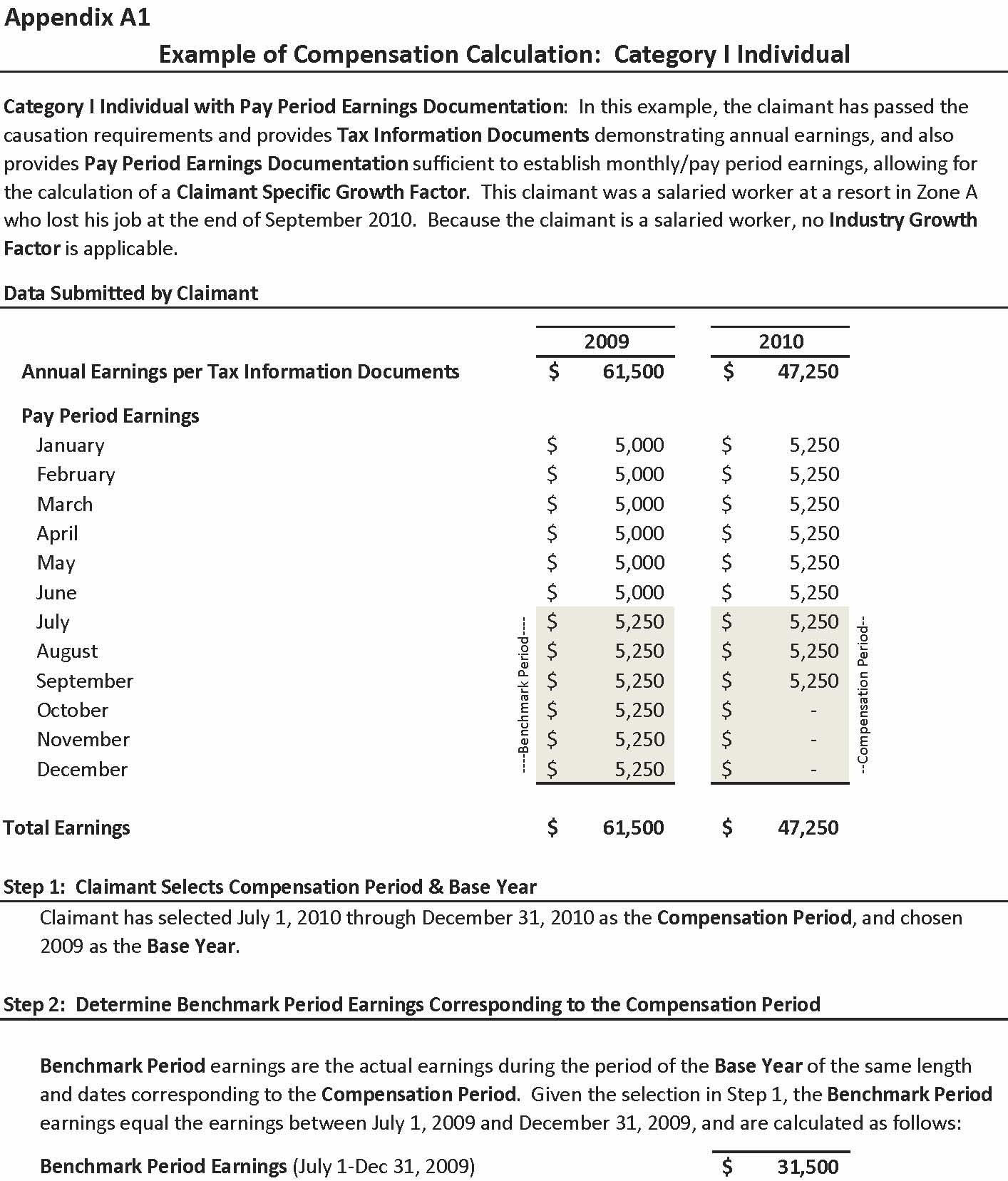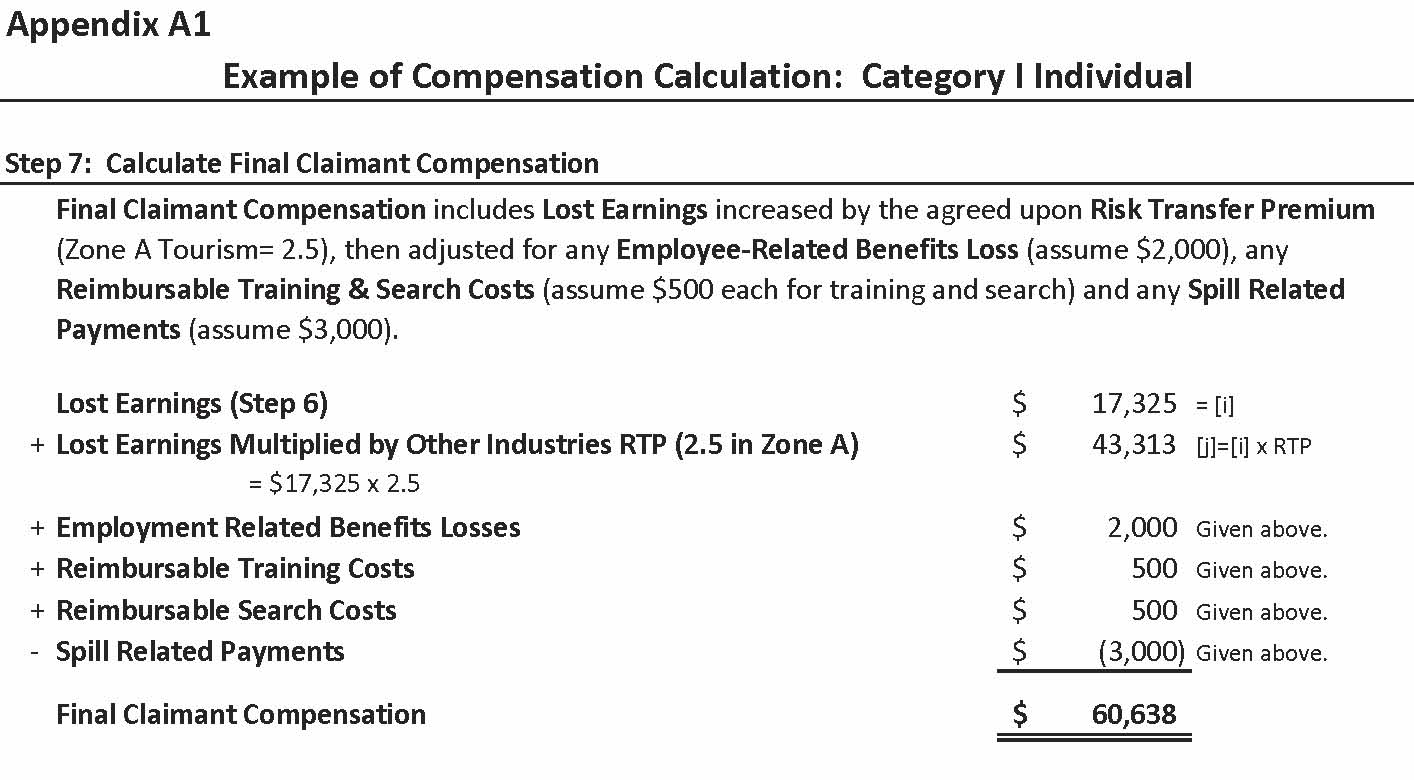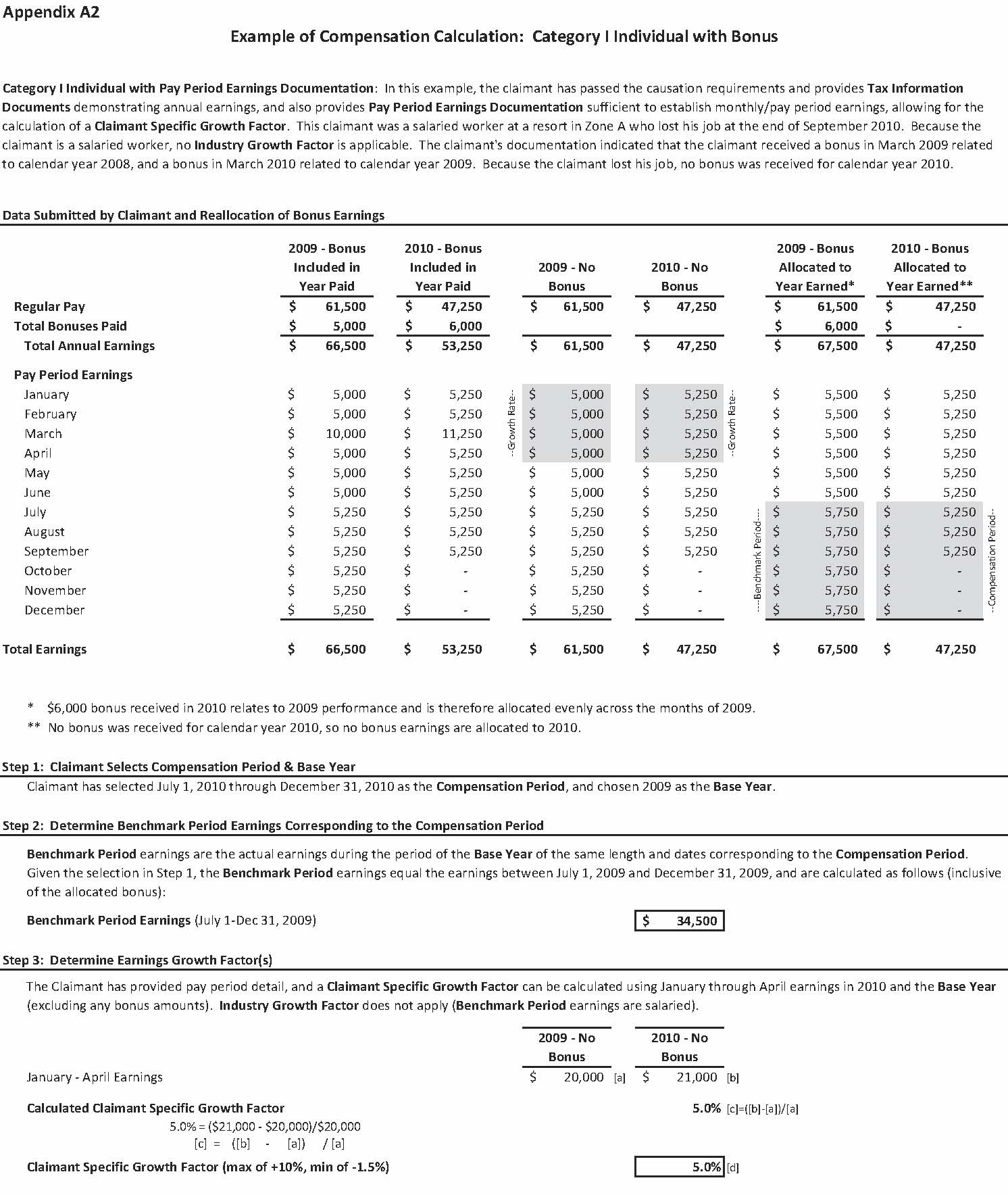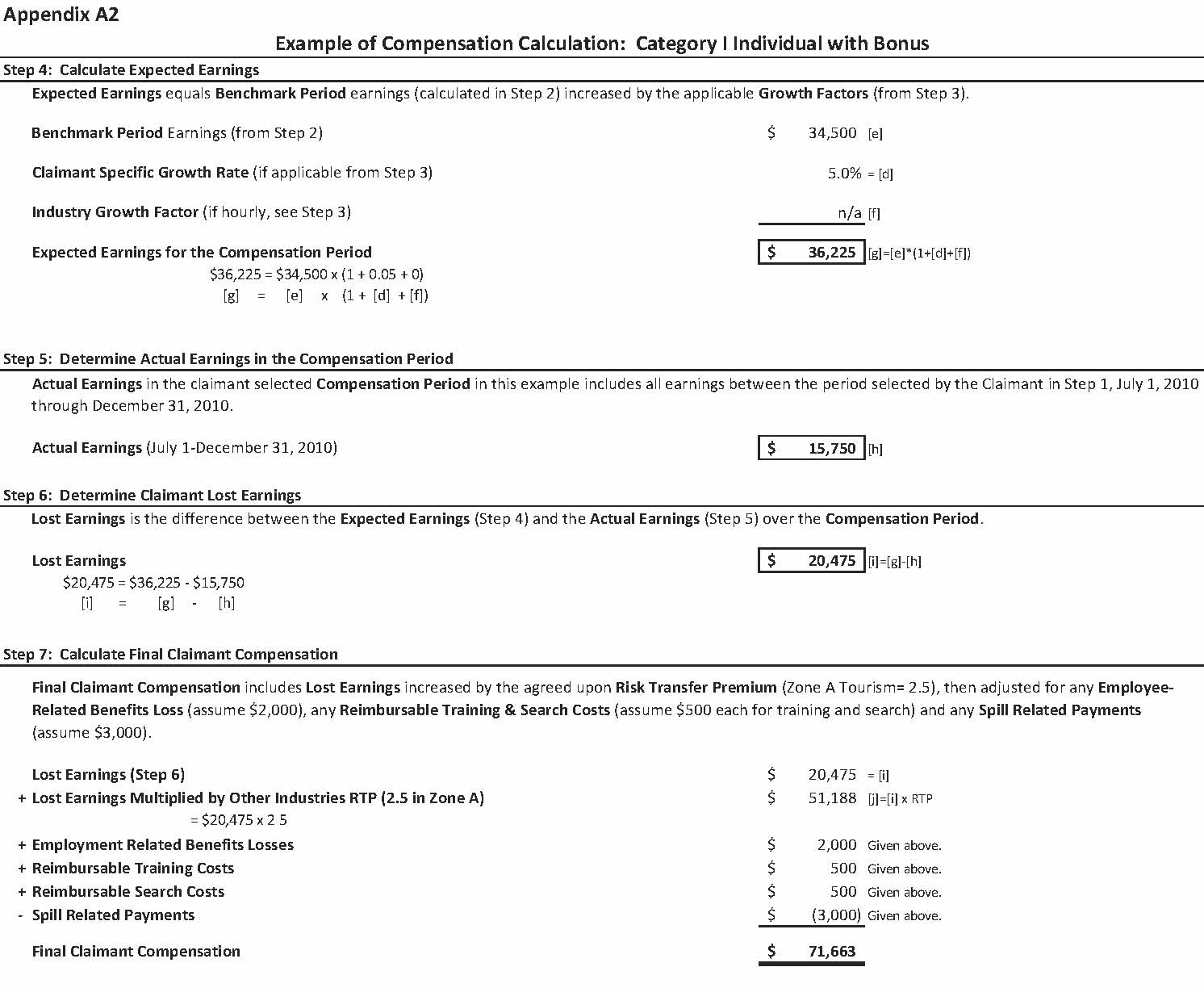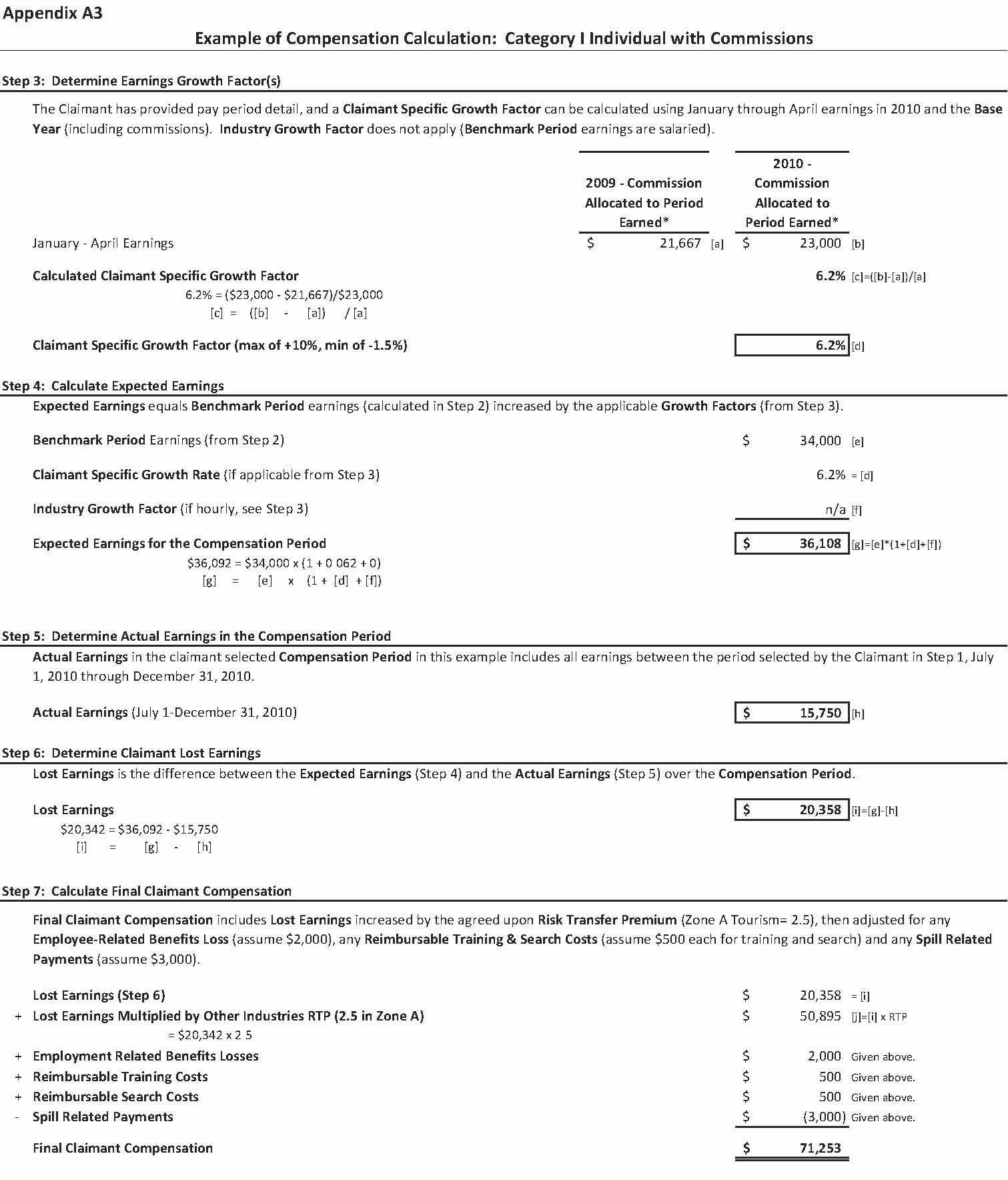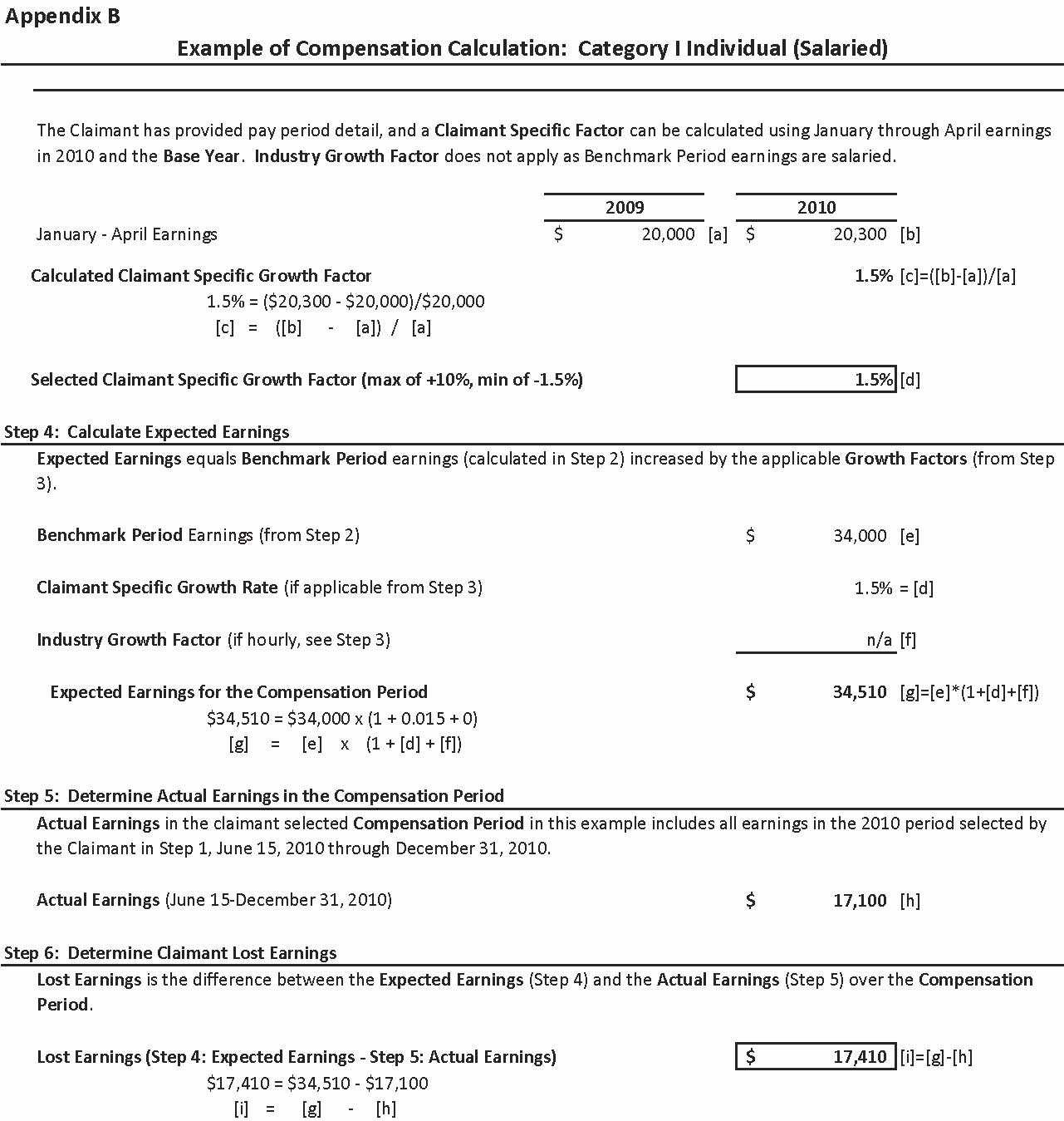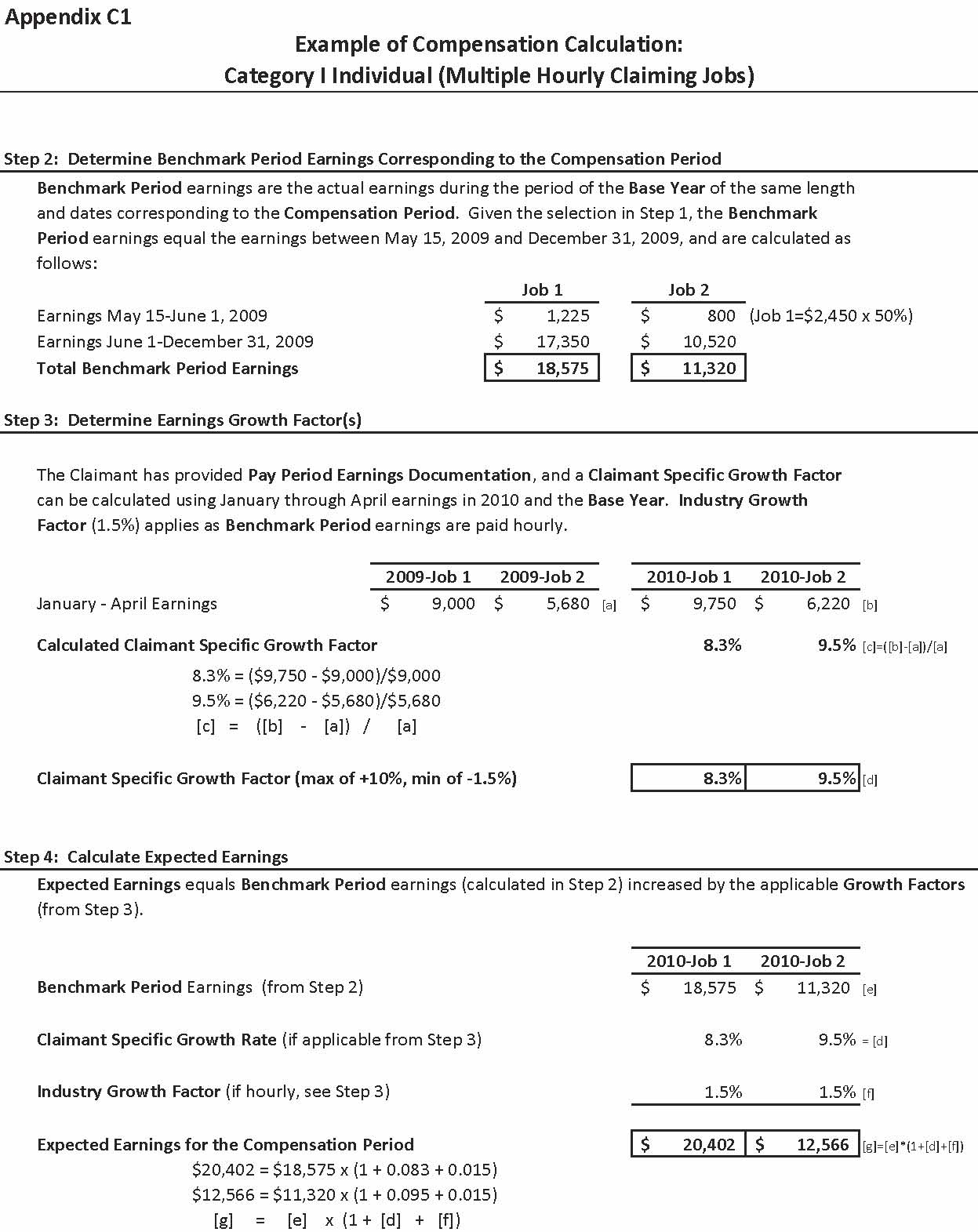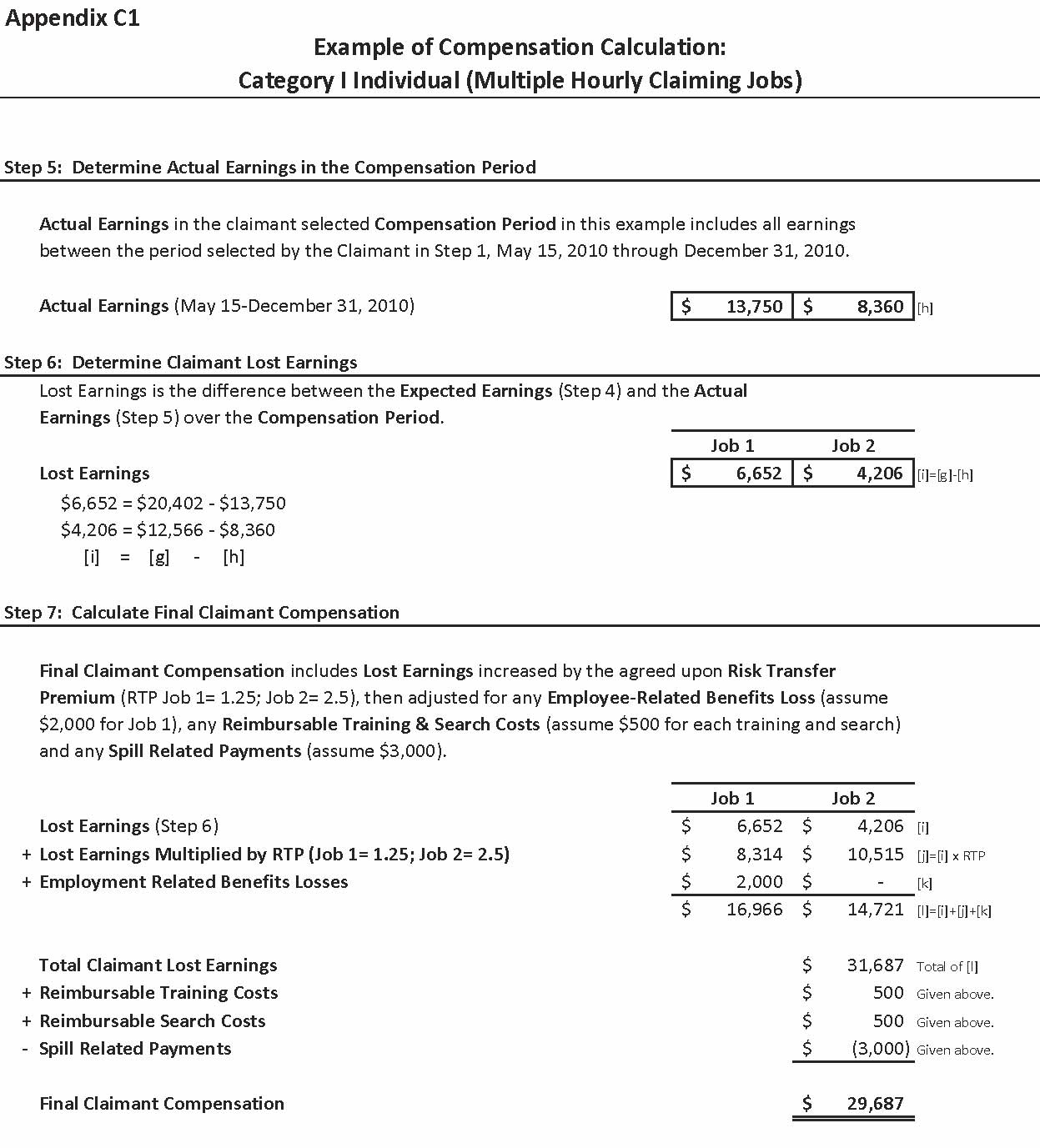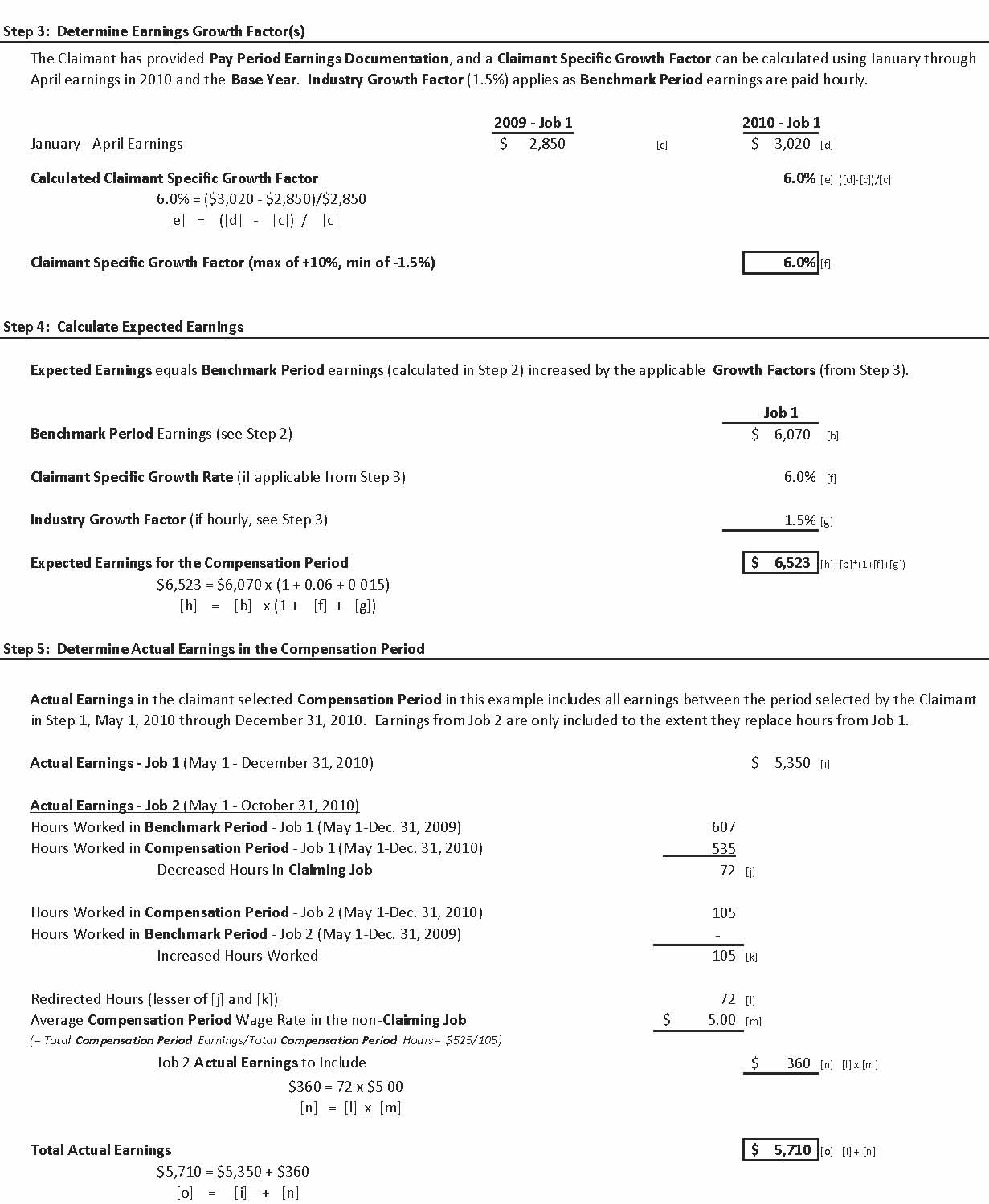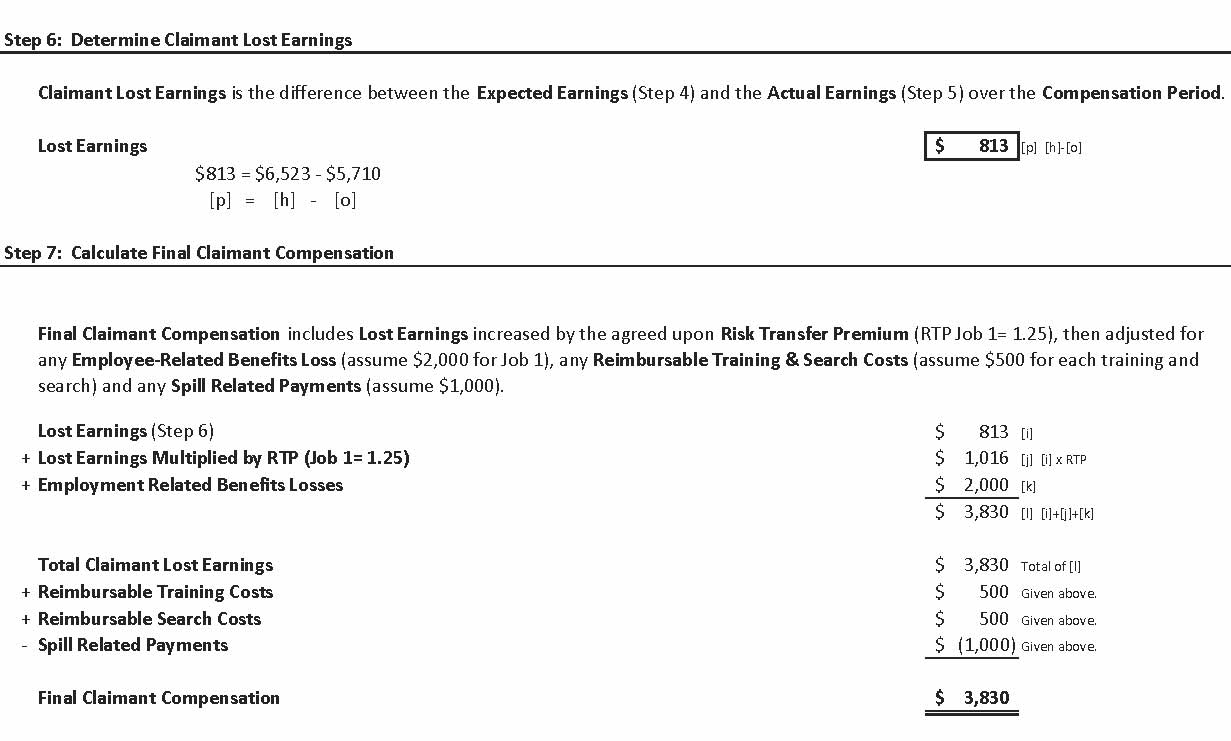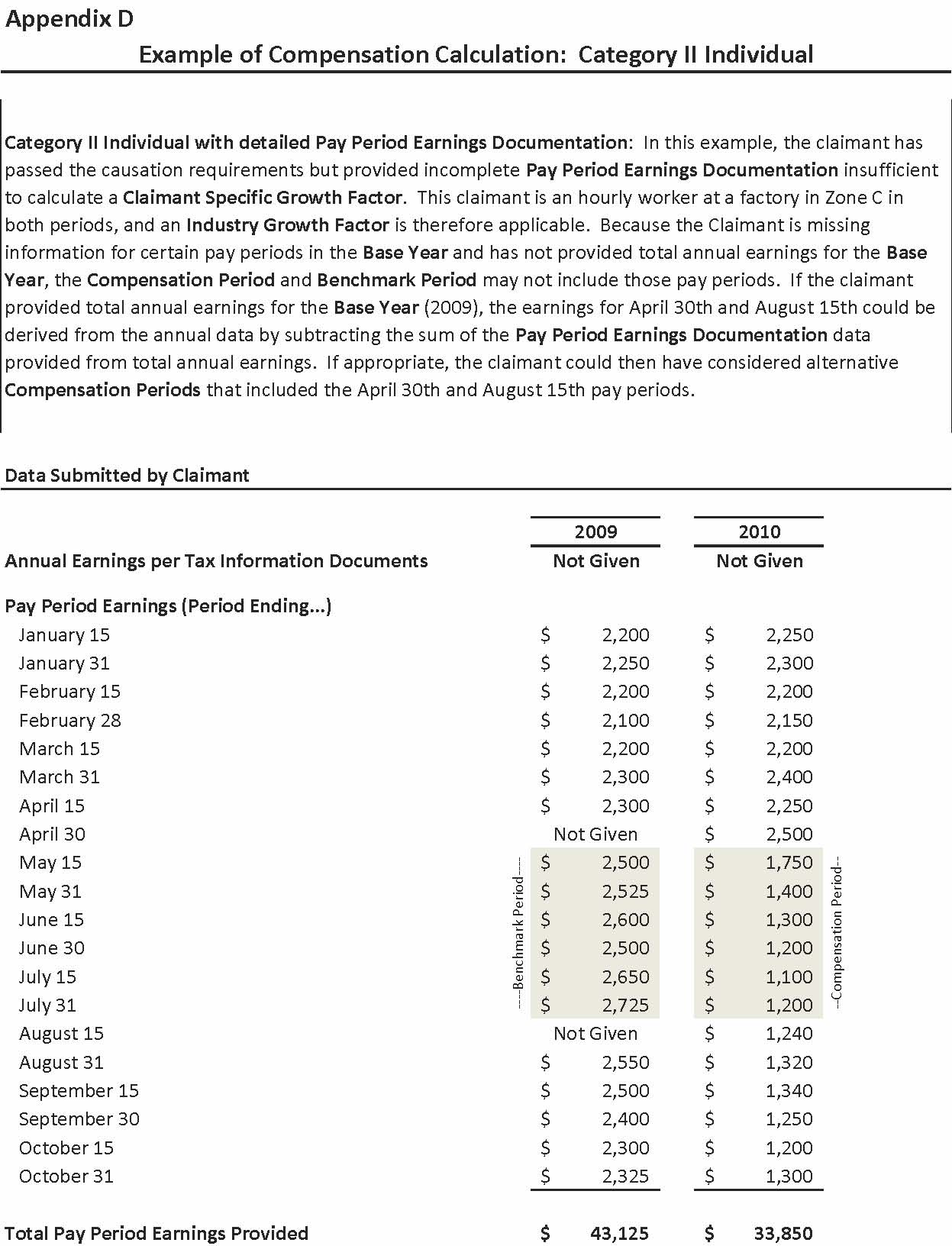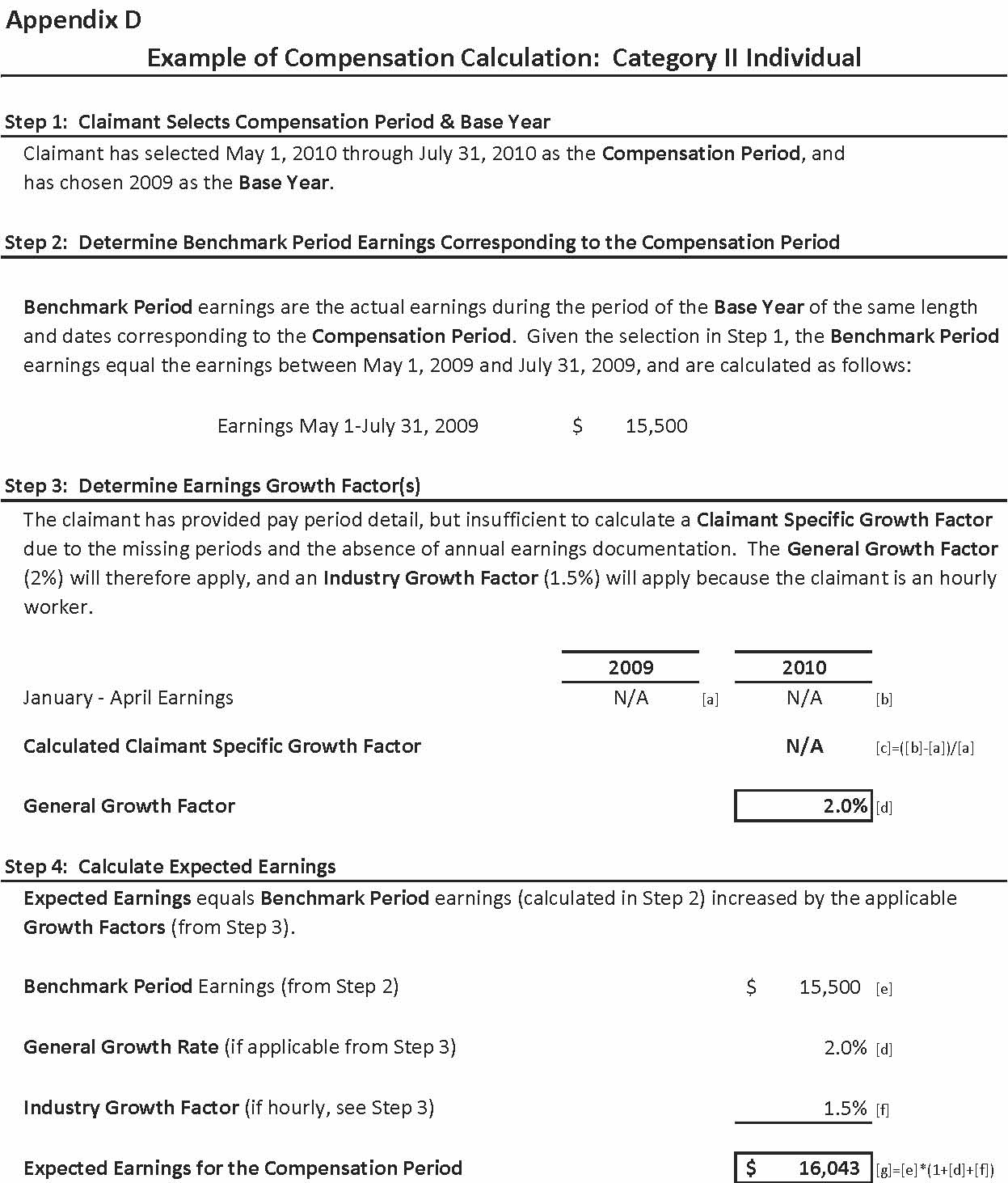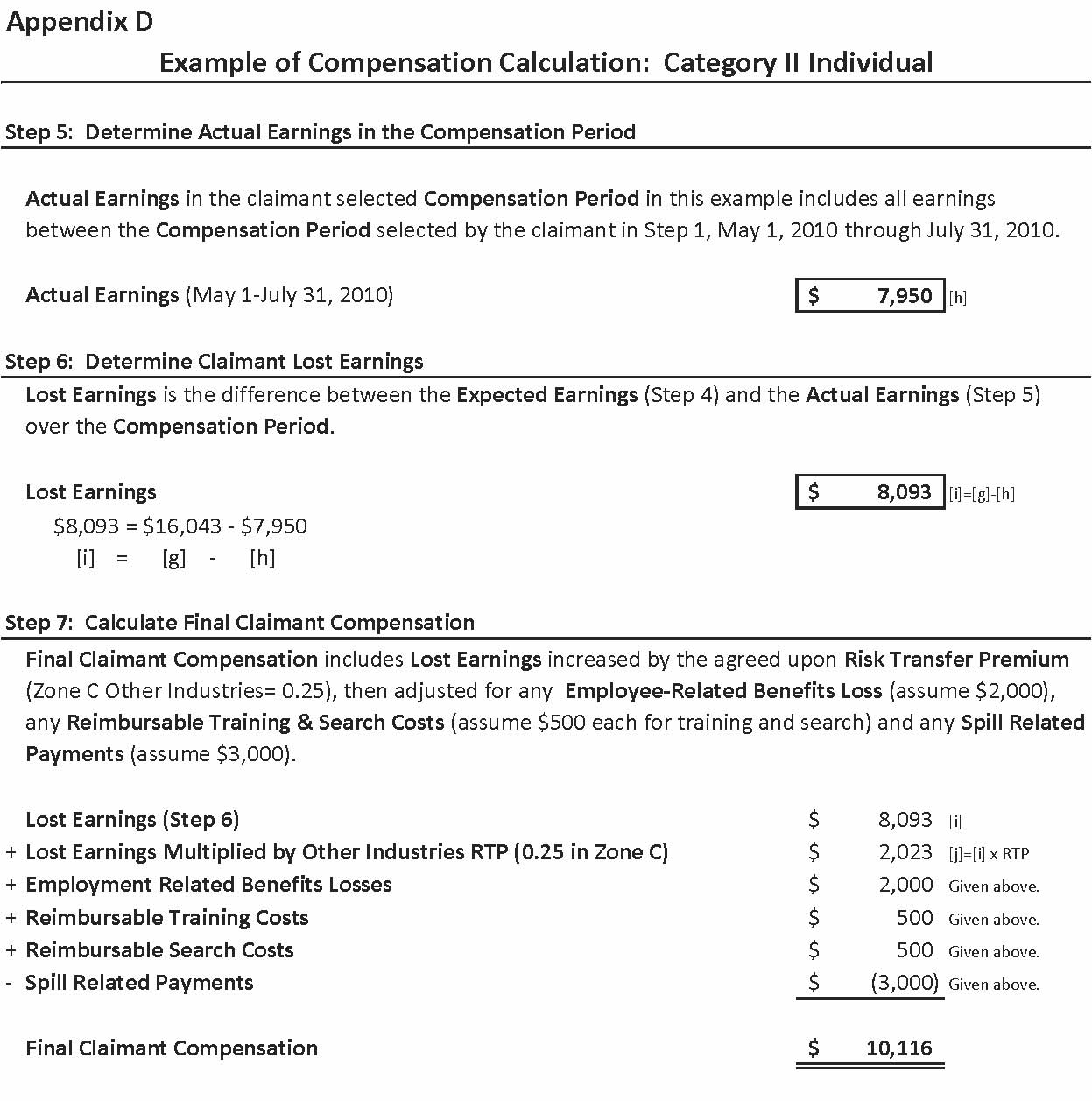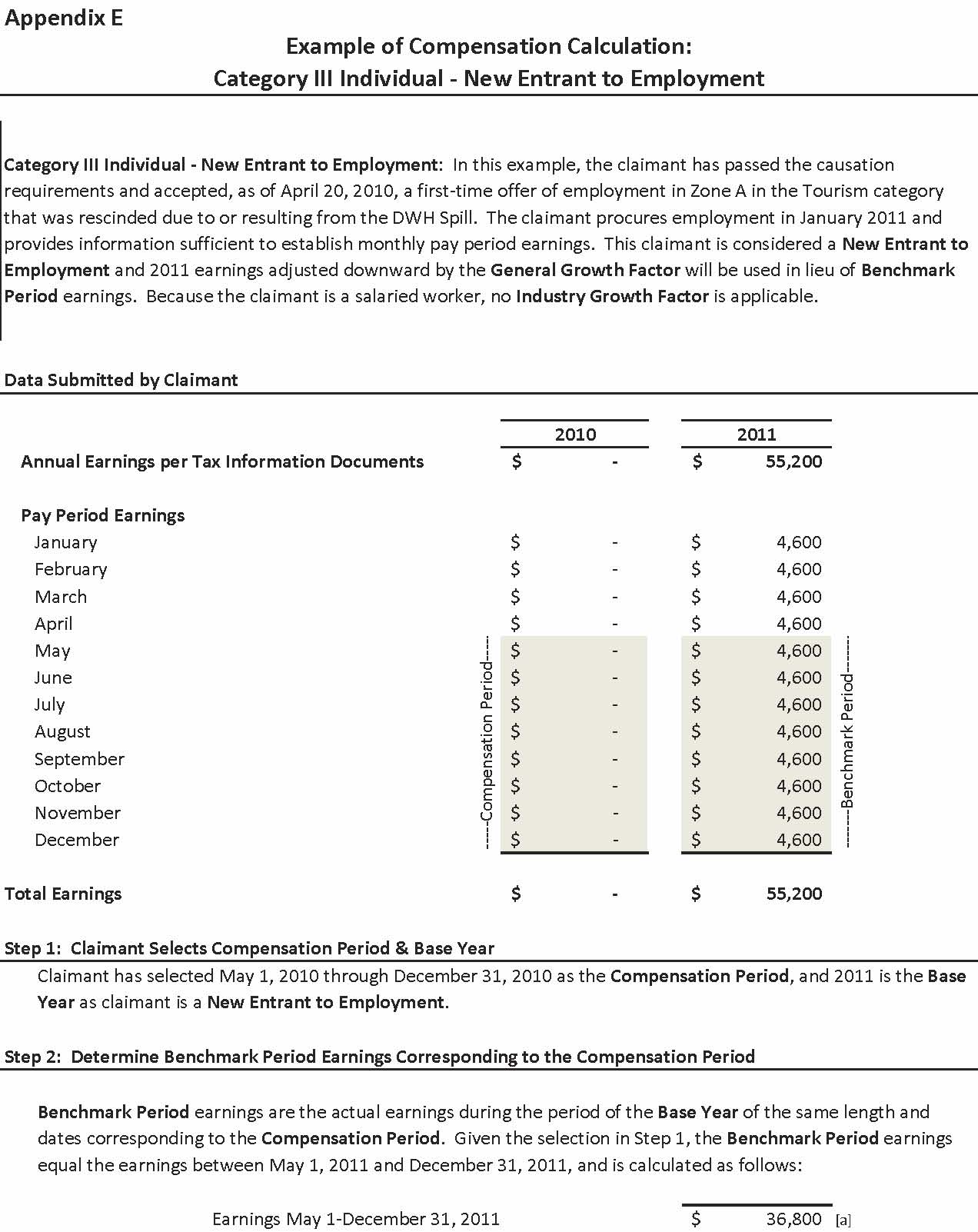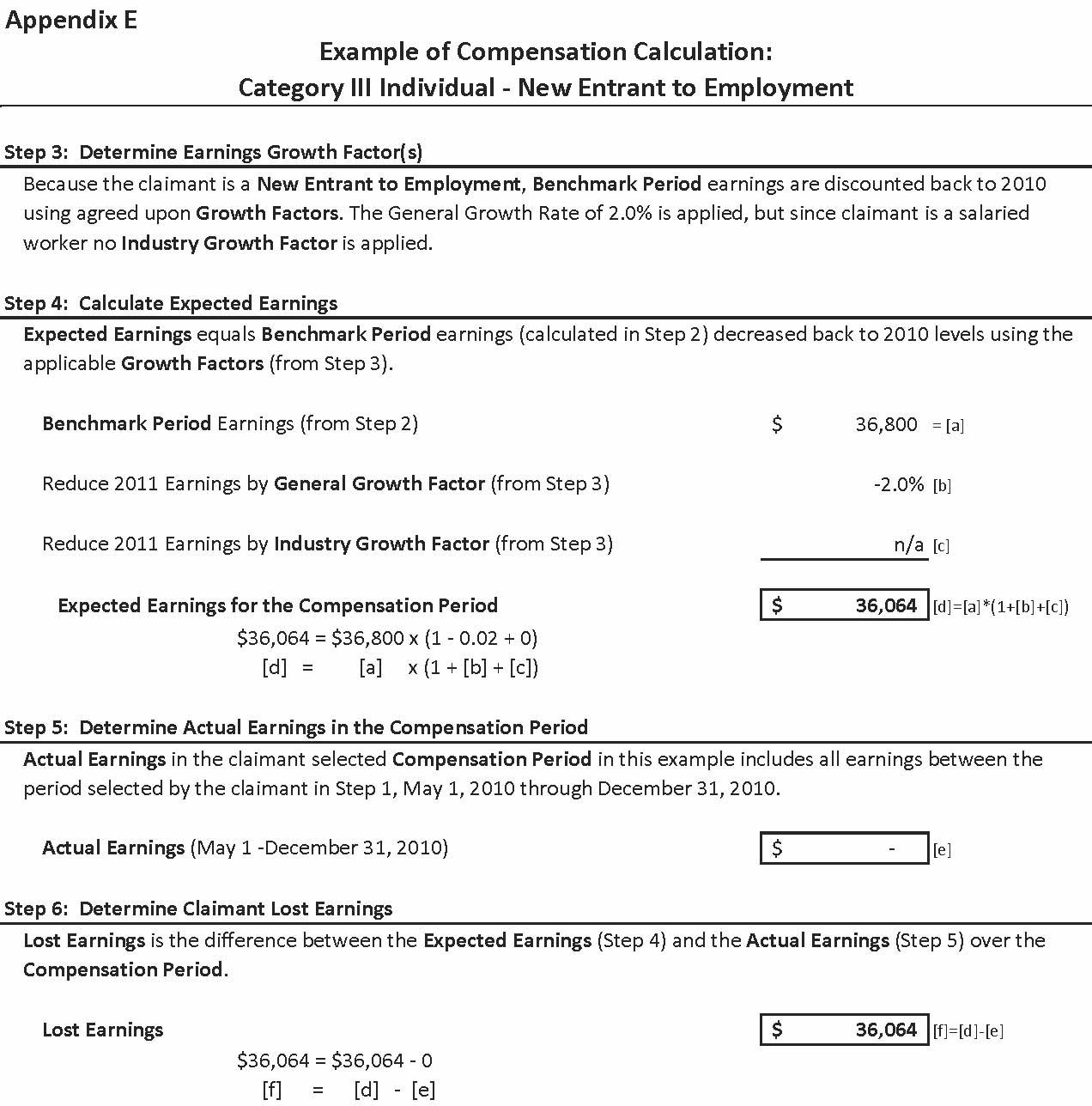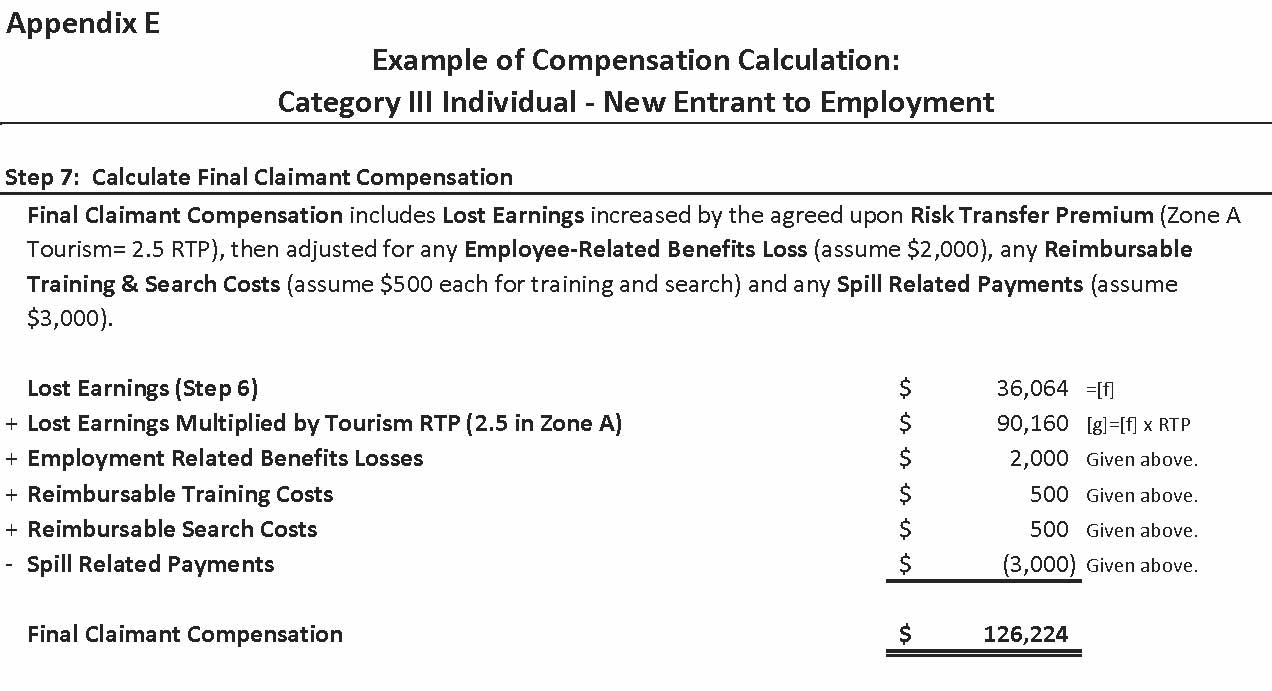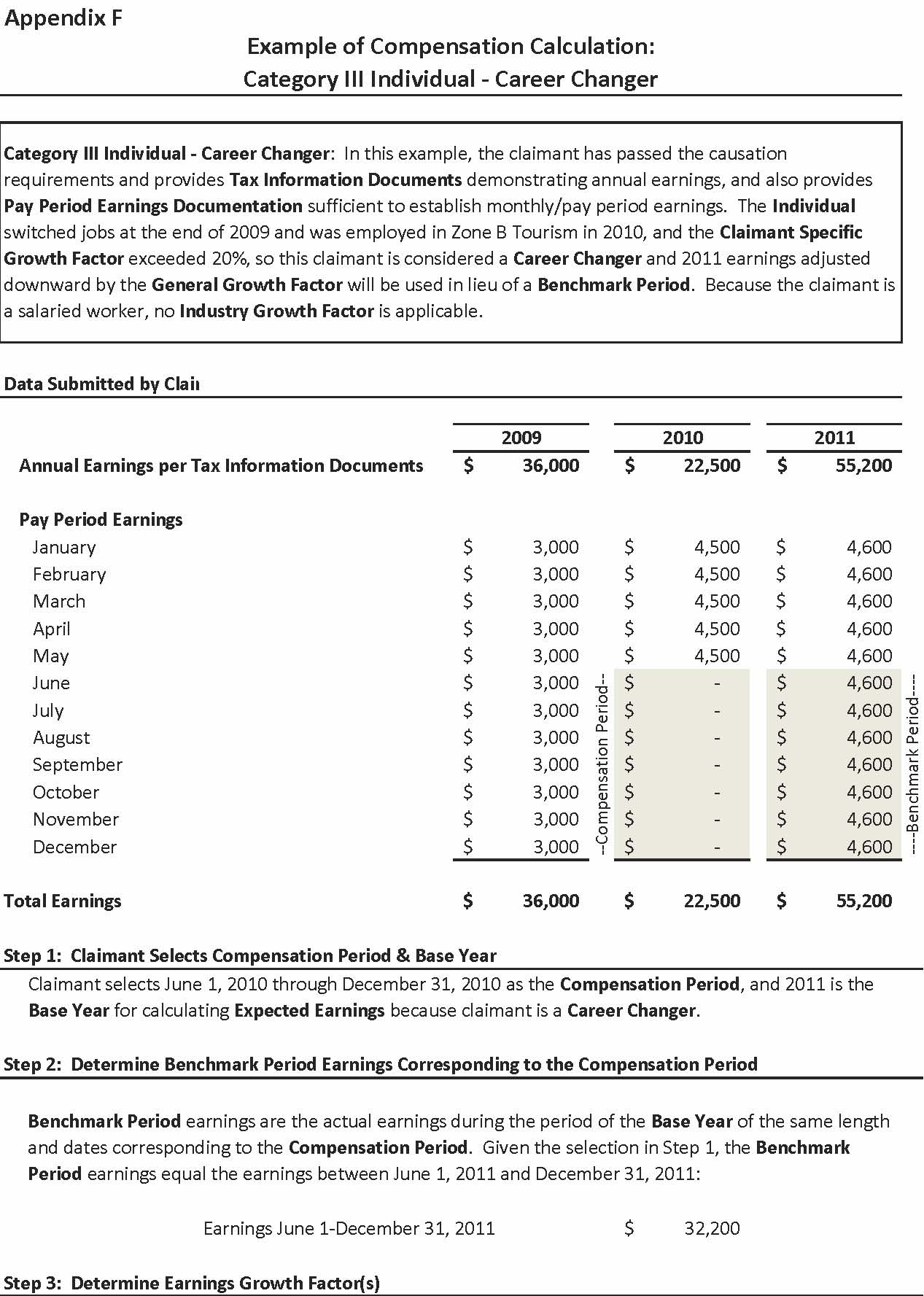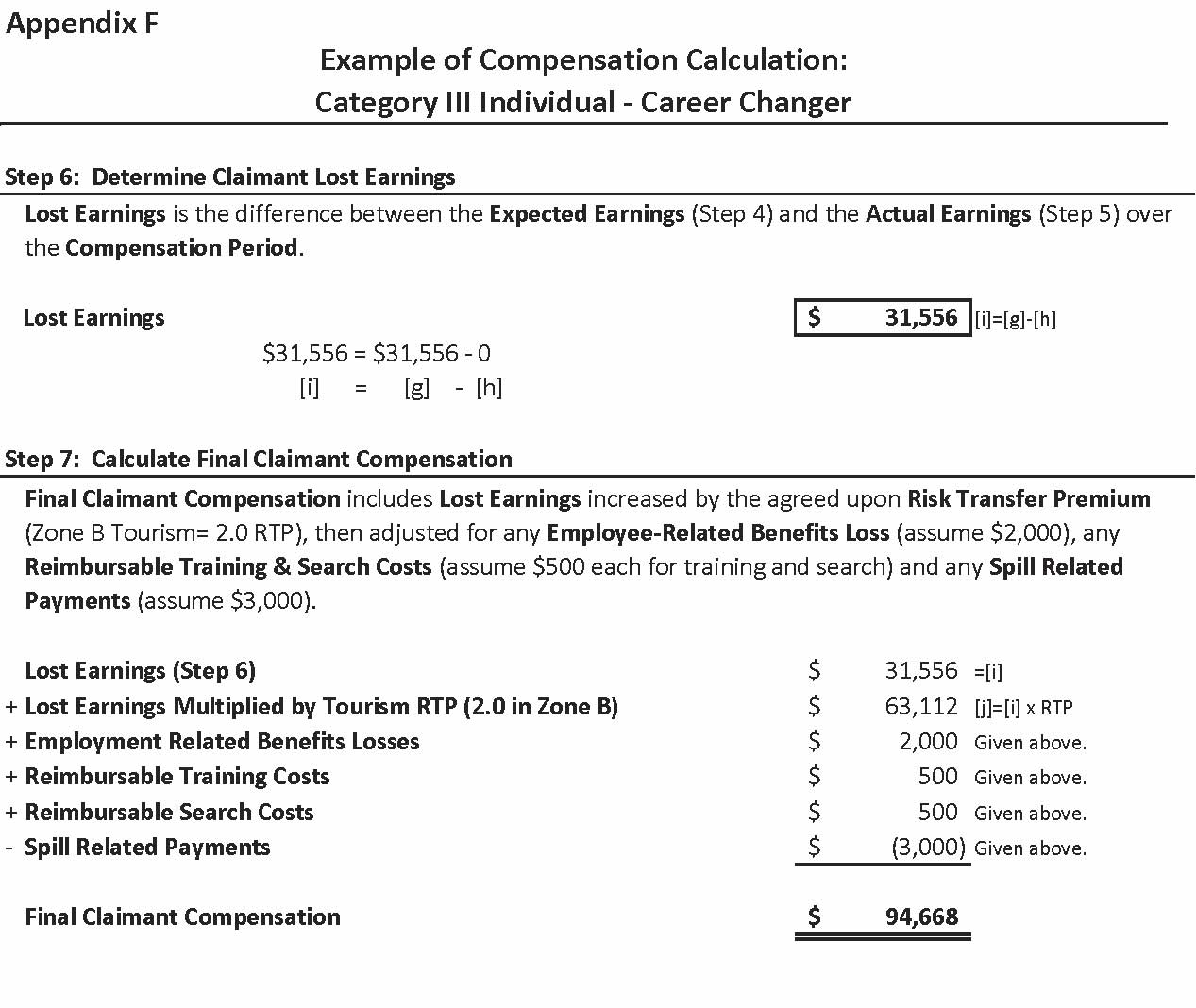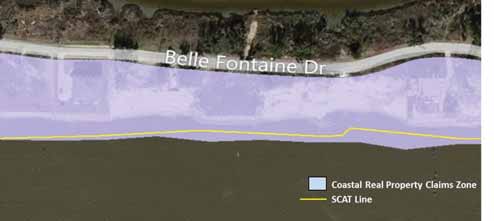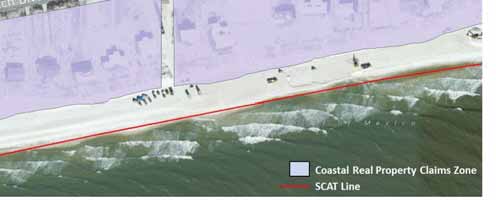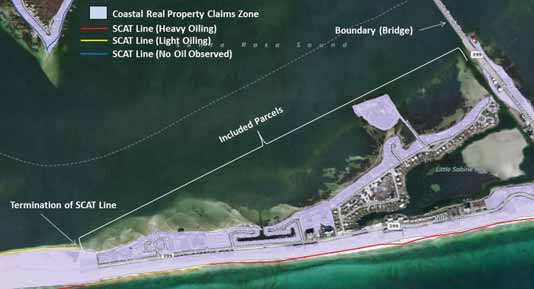GENERAL FRAMEWORK AND OVERVIEW OF SEAFOOD COMPENSATION 3
PROGRAM DISTRIBUTION
SHRIMP COMPENSATION PLAN 4
Expedited Compensation Method 8
Reduced Expedited Method 13
New Entrant Compensation Method 15
Historical Revenue Method 18
Vessel Lease Compensation Allocation 24
OYSTER COMPENSATION PLAN 25
Oyster Leaseholder Interest Compensation 28
Oyster Leaseholder Lost Income Compensation 29
Oyster Harvester Lost Income Compensation 30
Vessel Lease Compensation Allocation 40
FINFISH COMPENSATION PLAN 41
Historical Revenue Method 44
Compensation for IFQ Quota Holders 49
Vessel Lease Compensation Allocation 50
BLUE CRAB/OTHER SEAFOOD COMPENSATION PLAN 52
Historical Revenue Method 56
Vessel Lease Compensation Allocation 63
SEAFOOD CREW COMPENSATION PLAN 65
Category I Crew Compensation 68
Category II Crew Compensation 70
Category III Crew Compensation 78
SEAFOOD SPILL-PAYMENT REDUCTION PROCEDURES 85

SEAFOOD COMPENSATION PROGRAM
OVERVIEW
The Seafood Compensation Program shall cover and compensate Commercial Fishermen, Seafood Boat Captains, all other Seafood Crew, Oyster Leaseholders, and Seafood Vessel Owners for economic loss claims relating to Seafood.1 All economic loss claims by Commercial Fishermen, Seafood Boat Captains, all other Seafood Crew, Oyster Leaseholders, and Seafood Vessel Owners relating to Seafood will be part of and must be brought under the Seafood Compensation Program.2
The Seafood Compensation Program is divided into the following compensation categories and claim types:
TABLE 1
|
CATEGORY |
|
COMPENSABLE CLAIMS |
|
Shrimp |
• |
Vessel Owner/Commercial Fisherman |
|
|
Vessel Lessee claims |
|
• |
Boat Captain claims |
|
Oyster |
• |
Leaseholder Interest claims |
|
• |
Leaseholder Lost Income claims |
|
• |
Vessel Owner/Oyster Harvester Vessel Lessee claims |
|
• |
Boat Captain claims |
|
Finfish |
• |
Vessel Owner/Commercial Fisherman Vessel Lessee claims |
|
• • |
Boat Captain claims Individual Fishing Quota holder claims |
|
Blue Crab/Other Seafood |
• |
Vessel Owner/Commercial Fisherman Vessel Lessee claims (including crab trap damage) |
|
• |
Boat Captain claims |
1
The terms Commercial Fisherman, Seafood Boat Captains, Seafood Crew, Oyster Leaseholders and Seafood Vessel Owners as defined in the “Seafood Distribution Chain Definitions” (Exhibit 3 to the Deepwater Horizon Economic and Property Damages Settlement Agreement) shall apply in this Seafood Compensation Program.
2
To the extent terms herein are defined in the Deepwater Horizon Economic And Property Damages Settlement Agreement, those definitions shall apply in the Seafood Compensation Program. Nevertheless, any term specifically defined within the Seafood Compensation Program, shall be interpreted as set forth in this Seafood Compensation Program, notwithstanding any contrary definition in the Deepwater Horizon Economic And Property Damages Settlement Agreement.

CATEGORY
COMPENSABLE CLAIMS
Seafood Crew (excluding Boat Captains) for
• Crew claimants with standard all Seafood industries
documentation
-
Crew claimants with documentation supplied by employer
-
Crew claimants with documentation supplied by non-employers
For each category and compensable claim type, a Claimant will have to establish that the Claimant is a Class Member and meets the separate eligibility requirements defined below. In addition, Claimants are subject to the requirements of the Deepwater Horizon Economic And Property Damages Settlement Agreement and any applicable Court order, except as otherwise modified or provided by the Seafood Compensation Program.
Claimants are able to file a single Seafood Compensation Program Sworn Claim Form seeking compensation for multiple compensable claims. A Claimant filing a claim under the different plan in the Seafood Compensation Program, may be required to use different historical information for the Benchmark Period and must review the definition of Benchmark Period in each plan. For example, the Claimant may use a different Benchmark Period for the Claimant’s claim under the Shrimp Compensation Plan and the Claimant’s claim under the Oyster Compensation Plan. The following provides a non-exhaustive list of examples in which a single claimant might be eligible to receive compensation for multiple compensable claims:
-
A shrimp Vessel Owner/Commercial Fisherman Vessel Lessee who is also a shrimp Boat Captain may be eligible to receive compensation both as a shrimp Vessel Owner/Commercial Fisherman Vessel Lessee and shrimp Boat Captain.
-
An oyster leaseholder may be eligible to receive compensation for both Leaseholder Interest and Leaseholder Lost Income claims. If the oyster leaseholder claimant is also a Vessel Owner/Commercial Fisherman Vessel Lessee and a Boat Captain, that claimant may be eligible to receive compensation as both an oyster Vessel Owner/Commercial Fisherman Vessel Lessee and an oyster Boat Captain.
-
A claimant who is a Boat Captain for vessel(s) in both the blue crab industry and shrimp industry may be eligible to receive compensation under applicable blue crab and shrimp categories.
Seafood Compensation Program Sworn Claim Forms may be submitted at any time after entry of the Preliminary Approval Order, but no later than thirty (30) days from the date of entry of the Final Order and Judgment of the District Court ruling upon final approval of the Settlement (Bar Date). Claims will be processed and paid as expeditiously as possible by the Claims Administrator.
It is expressly acknowledged that the fact that a Claimant has made a claim and/or received compensation under the Seafood Compensation Program, does not preclude that claimant from making an independent claim and/or receiving compensation under the Deepwater Horizon Economic And Property Damages Settlement Agreement.
Compensation received by an eligible Claimant under the Seafood Compensation Program will be reduced by the amount of prior Seafood Spill-Related Payments as described in the Seafood Spill Related Payment Reduction Procedures in this document.3 No other reductions to the compensation amount under the Seafood Compensation Program will be taken, including compensation received for work in the VoO Program or compensation for VoO Damages under the Settlement.
The Seafood Compensation Program shall cover and compensate the economic loss claims for Commercial Fishermen, Seafood Crew, Oyster Leaseholders, and Seafood Vessel Owners. It does not cover subsistence claims.
General Framework and Overview of Seafood Compensation Program Distribution
The Seafood Compensation Program is estimated to result in prompt claims payments totaling more than $1.9 billion representing approximately 83% of the $2.3 billion Seafood Compensation Program Amount. After applying the terms of the Deepwater Horizon Economic And Property Damages Settlement Agreement (including determining the Seafood Compensation Program Amount) and paying the eligible Seafood Compensation Program claims, the Claims Administrator shall determine the amount of funds, if any, constituting the remaining Seafood Compensation Program Amount. In the event there are Seafood Compensation Program Amount funds remaining, such funds will be distributed to claimants that received compensation from the Seafood Compensation Program. The balance will be distributed to each Claimant in proportion to the Claimant’s gross compensation expressed as a share of the gross compensation paid by the Claims Administrator to all claimants under the Seafood Compensation Program.4 Gross compensation reflects compensation paid by the Claims Administrator prior to deduction for Seafood Spill-Related Payments. If, however, the Court-Appointed Neutral determines that a distribution other than purely proportional would be more appropriate in light of the information available at the time of the second distribution, he may recommend to the Court that the second distribution be reallocated in an alternative fashion. Any such reallocation will be subject to court approval.
3
Seafood Spill-Related Payments are defined as compensation paid to a claimant through the OPA Process, by BP, the GCCF, or through the Transition Facility for economic loss claims relating to Seafood.
4
All claimants who receive compensation under the Seafood Compensation Program are entitled to a share of the distribution of the balance whether or not their individual claims have been characterized as “lump sum” or a similar term, and whether or not they are members of Categories II and III of the Seafood Crew Compensation Plan (each of which provides for an Aggregate Compensation Amount, which shall not apply as a limitation to a Claimant’s entitlement to a share of the balance to be distributed).
SHRIMP COMPENSATION PLAN
Generally Applicable Provisions of the Shrimp Compensation Plan:
-
Eligible Claimants shall be comprised of Class Members (i) who do not fall within the exclusions to the Economic Loss and Property Class Definition, (ii) who are Vessel Owners, Commercial Fishermen who lease Seafood Vessels (Commercial Fisherman Vessel Lessee), and/or Seafood Boat Captains that derive earnings from commercial shrimping and (iii) who meet the additional criteria listed in this Shrimp Compensation Plan.
-
It is understood that in some instances, the Vessel Owner is also the Commercial Fisherman; however, it may be the case that the Vessel Owner leased the vessel to a Commercial Fisherman. In those instances where the vessel was leased during the time period of April 20, 2010 to December 31, 2010, the Vessel Owner and Commercial Fisherman Vessel Lessee must file the vessel claim jointly in order to receive compensation prior to the Bar Date, and they shall share any Vessel Owner/Commercial Fisherman Vessel Lessee compensation provided for in this Shrimp Compensation Plan. If at the time of the Bar Date either the Vessel Owner or the Commercial Fisherman Vessel Lessee has not filed a claim, the one that has filed the claim shall receive the full Vessel Owner/Commercial Fisherman Vessel Lessee compensation for the vessel. The allocation of compensation between Vessel Owner and Commercial Fisherman Vessel Lessee shall be determined as provided in Section V. If the vessel was not leased to a Commercial Fisherman Vessel Lessee during the time period of April 20, 2010 to December 31, 2010, the Vessel Owner is entitled to the full Vessel Owner/Commercial Fisherman Vessel Lessee compensation for the vessel.
-
It is understood that in some instances, the Vessel Owner and/or the Commercial Fisherman Vessel Lessee is also the Boat Captain. In those instances where the Vessel Owner and/or the Commercial Fisherman Vessel Lessee were also the Boat Captain, they shall be eligible to receive the Boat Captain compensation portion for the vessel under the Shrimp Compensation Plan as set forth below. If the Vessel Owner and/or Commercial Fisherman Vessel Lessee employed a Boat Captain on the vessel and did not serve as a Boat Captain on that vessel, the hired Boat Captain is eligible for the Boat Captain compensation, not the Vessel Owner or Commercial Fisherman Vessel Lessee.
-
To establish eligibility to participate in the Shrimp Compensation Plan, a Vessel Owner Claimant must provide for each vessel(s) for which the Claimant is seeking compensation:
A. Proof of ownership of the vessel during the time period of April 20, 2010 to December 31, 2010.
B. Proof that as of April 20, 2010 there was a government license (even if it had expired before that date) that authorized that vessel to commercially fish for shrimp in the Specified Gulf Waters for the 2009 season or the 2010 season. However, a Vessel Owner who did not have such a license for the vessel can participate in the Shrimp Compensation Plan for that vessel if the Claimant can establish the criteria for the New Entrant Compensation Method as described in Section III below.
C. The vessel name and any applicable federal and/or state vessel registration numbers.
D. Proof that either:
-
the vessel was home ported in the Gulf Coast Areas at any time from April 20, 2010 to April 16, 2012; or,
-
the vessel landed shrimp in the Gulf Coast Areas at any time from April 20, 2009 to April 16, 2012.
E. A sworn statement attesting as to whether or not the vessel was leased during the time period April 20, 2010 to December 31, 2010. If the vessel was leased during this time period, the Vessel Owner must provide a copy of the lease agreement.
F. A sworn statement attesting as to whether or not the Vessel Owner was the Boat Captain for that vessel during January 1, 2007 through December 31, 2009. If the Vessel Owner was not the sole Boat Captain for that vessel for some portion of January 1, 2007 through December 31, 2009, to the extent possible, the Claimant shall identify all other Boat Captains employed on the vessel and the time periods for which the Boat Captains were employed.
5. To establish eligibility to participate in the Shrimp Compensation Plan, a Commercial Fisherman Vessel Lessee must provide for each vessel for which the claimant seeks compensation:
A. Proof that during the period of April 20, 2010 through December 30, 2010 the Claimant leased the vessel to be used for commercial shrimping.
B. Proof that as of April 20, 2010 there was a government license (even if it had expired before that date) that authorized that vessel to commercially fish for shrimp in the Specified Gulf Waters for the 2009 season or the 2010 season. However, a Commercial Fisherman Vessel Lessee who did not have such a license for the vessel can participate in the Shrimp Compensation Plan for that vessel if the Claimant can establish the criteria for the New Entrant Compensation Method as described in Section III below.
C. The vessel name and any applicable federal and/or state vessel registration identification numbers.
D. Proof that either:
-
the vessel was home ported in the Gulf Coast Areas at any time from April 20, 2010 to April 16, 2012; or,
-
the vessel landed shrimp in the Gulf Coast Areas at any time from April 20, 2009 to April 16, 2012.
E. A sworn statement, attesting that the Commercial Fisherman Vessel Lessee leased the vessel during the time period of April 20, 2010 to December 31, 2010. The Commercial Fisherman Vessel Lessee must also provide a copy of the lease agreement for the vessel.
F. A sworn statement attesting as to whether or not the Commercial Fisherman Vessel Lessee was the Boat Captain for that vessel during January 1, 2007 through December 31, 2009. If the Commercial Fisherman Vessel Lessee was not the sole Boat Captain for that vessel for some portion of January 1, 2007 through December 31, 2009, to the extent possible, the Claimant shall identify all other Boat Captains employed on the vessel and the time periods for which the Boat Captains were employed.
-
To establish eligibility to participate in the Shrimp Compensation Plan a Boat Captain must provide:
-
A. Proof that as of April 20, 2010 the Boat Captain held a governmental license (even if it had expired before that date) authorizing the Claimant to operate as a Boat Captain and/or to commercially fish for shrimp in the Specified Gulf Waters for the 2009 season or the 2010 season.
-
B. Proof that either the Boat Captain worked:
-
on one or more commercial shrimping vessels home ported in the Gulf Coast Areas at any time from April 20, 2010 to April 16, 2012; or,
-
on one or more commercial shrimping vessels that landed shrimp in the Gulf Coast Areas at any time from April 20, 2009 to April 16, 2012.
-
A Vessel Owner/Commercial Fisherman Vessel Lessee who does not have either a 2009 or 2010 fishing license or proof of shrimp landings in 2009, 2010 or 2011 can participate in the Shrimp Compensation Program if that Vessel Owner can establish the criteria for the New Entrant Compensation Method as defined in Section III below. Additionally, a Boat Captain who had not previously worked as a Boat Captain for a commercial shrimping vessel in the Gulf Coast Areas and who prior to April 20, 2010 had a written job offer for employment as a Boat Captain on a vessel home ported in the Gulf Coast Areas for the 2010 shrimping season may be able to establish the criteria for the New Entrant Compensation Method as defined in Section III below.
-
A Sworn Statement attesting whether or not the Claimant received any Seafood Spill-Related Payments. If the Claimant received Seafood Spill-Related Payments, the Claimant shall provide documents5 sufficient to establish the timing, amount and source
When documents are requested in the Seafood Compensation Program, Claimant may provide either legible copies or originals of the documents.
of Seafood Spill-Related Payments, including documents providing the claimant’s BP/GCCF/Transition Facility Claim Number, if applicable, and any corresponding payments.
Shrimp Compensation Plan Definitions:
Benchmark Period6 is selected by the Claimant and can be (i) 2009, (ii) 2008 and 2009, or (iii) 2007, 2008 and 2009. If the Claimant elects to use years 2008 and 2009 or 2007, 2008, and 2009, the annual revenue amounts shall be averaged. In the event the Claims Administrator determines that the Claimant (individual or vessel) did not participate at the same level of effort in shrimp harvesting due to circumstances beyond the Claimant’s control (such as illness, disability or major mechanical failure), the Claims Administrator may at his discretion allow the Claimant to exclude one or more years of the Benchmark Period.
A Vessel Owner or Commercial Fisherman Vessel Lessee must submit separate Vessel Owner/Commercial Fisherman Vessel Lessee claims for each vessel they owned or leased and may select different Benchmark Periods for different vessels.
A Boat Captain’s claim reflects the Claimant’s activities on all vessels, and the Boat Captain must select a single Benchmark Period for the Claimant’s claim.
A Vessel Owner or Commercial Fisherman Vessel Lessee who also submits a Boat Captain claim may select different Benchmark Periods for the Claimant’s Vessel Owner/Commercial Fisherman Vessel Lessee claim and the Claimant’s Boat Captain claim.
Compensation Plan Methods:
There are four methods for a Vessel Owner/Commercial Fisherman Vessel Lessee and/or Boat Captain to be compensated under the Shrimp Compensation Plan. The options are:
-
Expedited Compensation Method
-
Reduced Expedited Compensation Method
-
New Entrant Compensation Method
-
Historical Revenue Method
A Vessel Owner or Commercial Fisherman Vessel Lessee may select different Compensation Plan Methods for different vessels. There is no qualifying revenue level required for the Historical Revenue Method. The qualifying vessel revenue for the Expedited Compensation Method and Reduced Expedited Compensation Method is summarized in the second column of Table 2 and the compensation amount is summarized in the third column. The eligibility, documentation and details of each method are described more fully in Sections I and II below.
For the Seafood Compensation Program, the Benchmark Period is defined independently for each Seafood Compensation Program Plan and is set forth within the specific Plan. Definitions of Benchmark Period in any other frameworks in the Deepwater Horizon Economic And Property Damages Settlement Agreement do not apply in the Seafood Compensation Program.
A Boat Captain must select a single Compensation Method for his claim. There is no qualifying revenue for the Historical Revenue Method. The qualifying vessel revenue for the Expedited Compensation Method and Reduced Expedited Compensation Method must be made based on revenue for a single vessel size and type category (but not necessarily for a single vessel). The qualifying revenue for the Expedited Compensation Method and Reduced Expedited Compensation Method is summarized in the second column of Table 2 and the compensation amount is summarized in the third and fourth columns. The eligibility, documentation and details of each method are described more fully in Sections I and II below.
TABLE 2
Qualifying Vessel Revenue and Compensation for Expedited and Reduced Expedited Methods
|
Vessel |
|
Owner/Commercial |
|
Qualifying |
Fisherman Vessel |
|
Vessel |
Lessee |
Boat Captain |
|
Vessel Size |
Revenue |
Compensation |
Compensation |
|
Expedited Method: |
|
|
|
|
< 30 feet |
$32,500 |
$104,063 |
$92,813 |
|
30 - 44 feet |
$40,000 |
$135,281 |
$107,250 |
|
45 - 74 feet (Ice) |
$90,000 |
$270,563 |
$160,875 |
|
45 - 74 feet (Freezer) |
$275,000 |
$478,688 |
$284,625 |
|
75+ feet (Ice) |
$225,000 |
$416,250 |
$206,250 |
|
75+ feet (Freezer) |
$400,000 |
$582,750 |
$288,750 |
|
Reduced Expedited Method: |
|
|
|
|
< 30 feet |
N/A |
N/A |
N/A |
|
30 - 44 feet |
$25,000 |
$62,438 |
$49,500 |
|
45 - 74 feet (Ice) |
$50,000 |
$145,688 |
$86,625 |
|
45 - 74 feet (Freezer) |
$200,000 |
$333,000 |
$198,000 |
|
75+ feet (Ice) |
$150,000 |
$291,375 |
$144,375 |
|
75+ feet (Freezer) |
$290,000 |
$457,875 |
$226,875 |
I. Expedited Compensation Method
A. Eligibility Requirements
1. Vessel Owner/Commercial Fisherman Vessel Lessee
In order to qualify for compensation under the Expedited Compensation Method, the Vessel Owner/Commercial Fisherman Vessel Lessee must provide for each vessel:
-
a.
-
A copy of the 2009 or 2010 governmental issued vessel registration for each of Claimant’s vessel(s) establishing the home port of the vessel was within the states of Louisiana, Mississippi and Alabama or a Florida registered vessel with its home port in the counties of Escambia, Santa Rosa, Okaloosa, Walton, Holmes, Washington, Bay, Jackson, Calhoun, Gulf, Liberty, Franklin, Gadsden, Leon, Wakulla in the State of Florida; and,
b.
Proof of revenue from commercial shrimping equal to or greater than the Qualifying Revenue in Table 3 based on vessel size and type for the Benchmark Period.
2. Boat Captains
In order to qualify for compensation under the Expedited Compensation Method, the Boat Captain must provide for each vessel:
a. Proof that during the Benchmark Period:
i. the Claimant was a Boat Captain on a commercial shrimping vessel with the home port of the vessel that was within the states of Louisiana, Mississippi and Alabama or a Florida registered vessel with its home port in the counties of Escambia, Santa Rosa, Okaloosa, Walton, Holmes, Washington, Bay, Jackson, Calhoun, Gulf, Liberty, Franklin, Gadsden, Leon, Wakulla in the State of Florida; and,
ii. the vessel had revenue from commercial shrimping equal to or greater than the Qualifying Revenue in Table 3 based on vessel size and type for the Benchmark Period. A Boat Captain may combine vessel revenue from multiple vessels of the same size and type for the Benchmark Period; and,
iii. the Claimant was the Boat Captain of the vessel during the time period for which the vessel generated the revenue on which the Claimant relies to establish the Qualifying Revenue for the Benchmark Period reported in Table 3.
TABLE 3
|
VESSEL SIZE |
QUALIFYING VESSEL REVENUE |
|
<30 feet |
$32,500 |
|
30-44 feet |
$40,000 |
|
45-74 feet Ice |
$90,000 |
|
45-74 feet Freezer |
$275,000 |
|
75+ feet Ice |
$225,000 |
|
75+ feet Freezer |
$400,000 |
B. Documentation Required
1. Vessel Owners/Commercial Fisherman Vessel Lessees
Vessel Owners/Commercial Fisherman Vessel Lessees seeking compensation under the Expedited Compensation Method must provide documents sufficient to prove eligibility pursuant to the applicable paragraphs of the “Generally Applicable Provisions of the Shrimp Compensation Plan” and the requirements in Section I.A.1, and to determine compensation pursuant to Section I.C below, including the following:
a. Trip Tickets or their equivalents such as dealer forms, which show the volume of shrimp harvested and the sales price as shown on the trip tickets or their equivalents for the Benchmark Period. The total volume multiplied by the price will be the applicable gross revenue.
– OR –
b. Federal or state tax and financial information as follows:
i. If Claimant is an entity, federal or state tax returns and sufficient documentation to identify those components of gross revenue derived from commercial shrimp harvesting by vessel for the Benchmark Period for each vessel for which the Claimant submits a Vessel Owner/Commercial Fisherman Vessel Lessee claim.
ii. If Claimant is an individual, federal form 1040 including Schedules C, E and F or state tax forms with supporting documents, as well as sufficient documentation to identify those components of earnings derived from commercial shrimp harvesting by vessel for the Benchmark Period.
iii. In addition, the Claimant must provide sufficient documentation for the Claims Administrator to be able to identify (i) Claimant’s revenue from shrimping as compared to other sources, (ii) Claimant’s revenue from landings in the Gulf Coast Areas. If necessary, the Claims Administrator may require supplemental information from the Claimant in order to make these determinations.
-
c.
-
Also, the Claimant must provide documentation sufficient to establish the vessel size and type for each vessel for which the Claimant seeks compensation.
d.
In addition, if available, it is requested that the Claimant also provide the following documents, to assist the Claims Administrator:
i. Vessel log book
ii. Share sheets
iii. Sales or other production reports maintained in the normal course of business.
2. Boat Captains
Boat Captains seeking compensation under the Expedited Compensation Method must provide documents sufficient to prove eligibility pursuant to the applicable paragraphs of the “Generally Applicable Provisions of the Shrimp Compensation Plan” and the eligibility requirements in Section I.A.2, and to determine compensation pursuant to Section I.C below, including the following:
a. Trip Tickets or their equivalents for each vessel, which show the volume of shrimp harvested and the sales price as shown on the trip tickets or their equivalents for the Benchmark Period. The total volume multiplied by the price will be the applicable gross revenue.
– OR –
-
b.
-
Federal tax returns, including Schedules C, E and F, W-2s, and 1099s or state tax returns and supporting documents for the Benchmark Period and sufficient documentation to identify those components of earnings derived from commercial shrimp harvesting for the Benchmark Period for the vessel(s) selected by the Claimant. In addition, the Claimant must provide sufficient documentation for the Claims Administrator to be able to identify revenue from shrimp landings in the Gulf Coast Areas for each vessel while the Claimant was Boat Captain. If necessary, the Claims Administrator may require supplemental information from the Claimant in order to make these determinations.
c.
Also, the Claimant must provide documentation sufficient to establish the vessel size and type for the vessel(s) for which the Claimant seeks compensation.
d.
In addition, if available, it is requested that the Claimant also provide the following documents, to assist the Claims Administrator:
i. Captain’s log book
ii. Vessel log book
iii. Share sheets
iv. Sales or other production reports maintained in the normal course of business.
C. Compensation Amounts
1. Vessel Owner/Commercial Fisherman Vessel Lessee Compensation
If the Claims Administrator determines that the Vessel Owner or Commercial Fisherman Vessel Lessee has provided necessary proof of eligibility and the required documentation, the Claimant shall receive the Vessel Owner/Commercial Fisherman Vessel Lessee Compensation for the vessel set forth in Table 4. The Vessel Owner/Commercial Fisherman Vessel Lessee Compensation includes an RTP of 8.25. A Claimant may have more than one vessel and is eligible for compensation for each vessel for which the Claimant independently satisfies the eligibility and documentation requirements.
TABLE 4
|
VESSEL SIZE |
VESSEL OWNER/COMMERCIAL |
|
FISHERMAN VESSEL LESSEE |
|
COMPENSATION |
|
<30 feet |
$104,063 |
|
30-44 feet |
$135,281 |
|
45-74 feet Ice |
$270,563 |
|
45-74 feet Freezer |
$478,688 |
|
75+ feet Ice |
$416,250 |
|
75+ feet Freezer |
$582,750 |
2. Boat Captain Compensation
If the Claims Administrator determines that the Boat Captain has provided necessary proof of eligibility and the required documentation for a vessel, the Claimant shall receive the Boat

Captain Compensation set forth in Table 5. The Boat Captain Compensation includes an RTP of
7.25.
TABLE 5
|
VESSEL SIZE |
BOAT CAPTAIN COMPENSATION |
|
<30 feet |
$92,813 |
|
30-44 feet |
$107,250 |
|
45-74 feet Ice |
$160,875 |
|
45-74 feet Freezer |
$284,625 |
|
75+ feet Ice |
$206,250 |
|
75+ feet Freezer |
$288,750 |
II. Reduced Expedited Compensation Method
If a Claimant does not qualify for the Expedited Compensation Method, the Claimant may qualify for the Reduced Expedited Compensation Method for each vessel.
A. Eligibility Requirements
1. Vessel Owner/Commercial Fisherman Vessel Lessee
In order to qualify for compensation under the Reduced Expedited Compensation Method, the Vessel Owner/Commercial Fisherman Vessel Lessee must provide for each vessel:
-
a.
-
A copy of the 2009 or 2010 governmental issued vessel registration for each of Claimant’s vessel(s) establishing the home port of the vessel was within the states of Louisiana, Mississippi and Alabama or a Florida registered vessel with its home port in the counties of Escambia, Santa Rosa, Okaloosa, Walton, Holmes, Washington, Bay, Jackson, Calhoun, Gulf, Liberty, Franklin, Gadsden, Leon, Wakulla in the State of Florida; and,
b.
Proof of revenue from commercial shrimping equal to or greater than the Qualifying Revenue in Table 6 based on vessel size and type for the Benchmark Period.
2. Boat Captains
In order to qualify for compensation under the Reduced Expedited Compensation Method, the Boat Captain must provide for each vessel:
a. Proof that during the Benchmark Period:
i. the Claimant was a Boat Captain on a commercial shrimping vessel with the home port of the vessel that was within the states of Louisiana, Mississippi and Alabama or a Florida registered vessel with its home port in the counties of Escambia, Santa Rosa, Okaloosa, Walton, Holmes, Washington, Bay, Jackson, Calhoun, Gulf, Liberty, Franklin, Gadsden, Leon, Wakulla in the State of Florida; and,
ii. the vessel had revenue from commercial shrimping equal to or greater than the Qualifying Revenue in Table 6 based on vessel size and type for the Benchmark Period, a Boat Captain may combine vessel revenue from multiple vessels of the same size and type for the Benchmark Period; and,
iii. the Claimant was the Boat Captain of the vessel during the time period for which the vessel generated the revenue on which the Claimant relies to establish the Qualifying Revenue for the Benchmark Period reported in Table 6.
TABLE 6
|
VESSEL SIZE |
QUALIFYING VESSEL REVENUE |
|
<30 feet |
n/a |
|
30-44 feet |
$25,000 |
|
45-74 feet Ice |
$50,000 |
|
45-74 feet Freezer |
$200,000 |
|
75+ feet Ice |
$150,000 |
|
75+ feet Freezer |
$290,000 |
B. Documentation Required
1. Vessel Owners/Commercial Fisherman Vessel Lessees
See documentation requirements for Vessel Owner/Commercial Fisherman Vessel Lessee Claimants under Expedited Compensation Method in Section I above.
2. Boat Captains
See documentation requirements for Boat Captain Claimants under Expedited Compensation Method in Section I above.
C. Compensation Amounts
1. Vessel Owner/Commercial Fisherman Vessel Lessee Compensation
If the Claims Administrator determines that the Vessel Owner or Commercial Fisherman Vessel Lessee has provided necessary proof of eligibility and the required documentation for a vessel, the Claimant shall receive the Vessel Owner/Commercial Fisherman Vessel Lessee Compensation set forth in Table 7. The Vessel Owner/Commercial Fisherman Vessel Lessee Compensation includes an RTP of 8.25. A Claimant may have more than one vessel and is eligible for compensation for each vessel for which the Claimant independently satisfies the eligibility and documentation requirements.
TABLE 7
|
VESSEL SIZE |
VESSEL OWNER/COMMERCIAL |
|
FISHERMAN VESSEL LESSEE |
|
COMPENSATION |
|
<30 feet |
n/a |
|
30-44 feet |
$62,438 |
|
45-74 feet Ice |
$145,688 |
|
45-74 feet Freezer |
$333,000 |
|
75+ feet Ice |
$291,375 |
|
> 75 feet Freezer |
$457,875 |
2. Boat Captain Compensation
If the Claims Administrator determines that the Boat Captain has provided necessary proof of eligibility and the required documentation, the Claimant shall receive the Boat Captain Compensation set forth in Table 8. The Boat Captain Compensation includes an RTP of 7.25.
TABLE 8
|
VESSEL SIZE |
BOAT CAPTAIN COMPENSATION |
|
<30 feet |
n/a |
|
30-44 feet |
$49,500 |
|
45-74 feet Ice |
$86.625 |
|
45-74 feet Freezer |
$198,000 |
|
75+ feet Ice |
$144,375 |
|
75+ feet Freezer |
$226,875 |
III. New Entrant Compensation Method
A. Eligibility Requirements
1. Vessel Owner
In order to qualify for the New Entrant Compensation Method, the Vessel Owner/Commercial Fisherman Vessel Lessee must establish for each vessel that as of April 20, 2010:
-
a.
-
If the vessel is over 30 feet:
i. the Claimant owned or leased the vessel and the vessel was specifically designed for commercial shrimping, such as a trawler, freezer boat, or ice boat, and
ii. the Claimant had expenditures in excess of $25,000 within 12 months prior to April 20, 2010 for purchase or repair of the vessel.
b.
If the vessel is less than or equal to 30 feet:
i. the Claimant owned or leased a vessel and intended to use the vessel predominantly as a shrimping boat, and
ii. the Claimant had expenditures for the vessel on shrimping gear, such as trawls, nets, iceboxes, or winches, in excess of $6,000 within 12 months prior to April 20, 2010.
2. Boat Captains
A Claimant may receive Boat Captain compensation under the New Entrant Compensation Method if the Claimant: (i) qualifies for compensation as a Vessel Owner/Commercial Fisherman Vessel Lessee under the New Entrant Compensation Method for the same vessel and
(ii) has not submitted a separate claim for compensation as a Boat Captain under any Shrimp Compensation Plan. Such Claimant cannot qualify as a Boat Captain for more than one vessel under the New Entrant Compensation Method.
Additionally, a Claimant who had not previously worked as a Boat Captain for a commercial shrimping vessel home ported in the Gulf Coast Areas may receive Boat Captain compensation under the New Entrant Compensation Method if the Claimant provides proof:
-
a.
-
of an agreement entered prior to April 20, 2010 with a Vessel Owner/Commercial Fisherman Vessel Lessee for employment as a Boat Captain on a commercial shrimping vessel home ported in the Gulf Coast Areas during April 20, 2010 to December 31, 2010 that is supported by some written documentation that pre-dates April 20, 2010.
b.
information sufficient to establish the proposed compensation, such as proposed start and end dates, wage rates, projected hours or Boat Captain’s share of the shrimping vessel revenue, and
c.
that offer for employment as a Boat Captain on a commercial shrimping vessel home ported in the Gulf Coast Areas was rescinded or withdrawn as a result of the Deepwater Horizon Oil Spill.
d.
Information regarding the employer, including: (i) employer’s business name, address(es), telephone number(s), website(s) (if available), and a description of the nature of the business.
The Claims Administrator shall have the right to interview the Claimant and potential employer if the Claims Administrator determines an interview is appropriate.
B. Documentation Required
1. Vessel Owner/Commercial Fisherman Vessel Lessee
Vessel Owners and Commercial Fisherman Vessel Lessees seeking compensation under the New Entrant Compensation Method must provide documents sufficient to prove eligibility pursuant to the applicable paragraphs of the “Generally Applicable Provisions of the Shrimp Compensation Plan” and the eligibility requirements in Section III.A.1, and to determine compensation pursuant to Section III.C below, including proof of (i) vessel size and type, (ii) expenditures for purchase and/or repair of the vessel, or (iii) purchases of shrimping gear.
2. Boat Captains
Boat Captains seeking compensation under the New Entrant Compensation Method must provide documents sufficient to prove eligibility pursuant to the applicable paragraphs of the “Generally Applicable Provisions of the Shrimp Compensation Plan” and the eligibility requirements in Section III.A.2, and to determine compensation pursuant to Section III.C below.
C. Compensation Amount
1. Vessel Owner/Commercial Fisherman Vessel Lessee
If the Claims Administrator determines that the Vessel Owner/Commercial Fisherman Vessel Lessee has provided necessary proof of eligibility and the required documentation for a vessel, the Claimant shall receive the Vessel Owner/Commercial Fisherman Vessel Lessee Compensation set forth in Table 9. The Vessel Owner/Commercial Fisherman Vessel Lessee Compensation includes an RTP of 8.25.
TABLE 9
|
VESSEL SIZE |
VESSEL OWNER/COMMERCIAL |
|
FISHERMAN VESSEL LESSEE |
|
COMPENSATION |
|
<30 feet |
$26,016 |
|
30-44 feet |
$33,820 |
|
45-74 feet Ice |
$67,641 |
|
45-74 feet Freezer |
$119,672 |
|
75+ feet Ice |
$104,063 |
|
> 75 feet Freezer |
$145,688 |

2. Boat Captains
If the Claims Administrator determines that a Claimant seeking compensation as a Boat Captain has provided necessary proof of eligibility and the required documentation, the Claimant shall receive the Boat Captain Compensation set forth in Table 10. The Boat Captain Compensation includes an RTP of 7.25.
TABLE 10
|
VESSEL SIZE |
BOAT CAPTAIN COMPENSATION |
|
<30 feet |
$23,203 |
|
30-44 feet |
$26,813 |
|
45-74 feet Ice |
$40,219 |
|
45-74 feet Freezer |
$71,156 |
|
75+ feet Ice |
$51,563 |
|
75+ feet Freezer |
$72,188 |
IV. Historical Revenue Method
A. Eligibility Requirements
1. Vessel Owner/Commercial Fisherman Vessel Lessee
To be eligible under the Historical Revenue Method, a Vessel Owner/Commercial Fisherman Vessel Lessee must meet the eligibility requirements of the applicable paragraphs of the “Generally Applicable Provisions of the Shrimp Compensation Plan” and provide evidence to demonstrate the Claimant’s commercial shrimping revenue during the selected Benchmark Period.
2. Boat Captains
To be eligible under the Historical Revenue Method, a Boat Captain must meet the eligibility requirements of the applicable paragraphs of the “Generally Applicable Provisions of the Shrimp Compensation Plan” and provide evidence to demonstrate the Claimant’s earnings from commercial shrimping on vessels for which the Claimant served as Boat Captain during the selected Benchmark Period.
B. Documentation Required
1. Vessel Owners/Commercial Fisherman Vessel Lessees
Vessel Owners/Commercial Fisherman Vessel Lessees seeking compensation under the Historical Revenue Method must provide documents sufficient to prove the eligibility requirements in Section IV.A and to determine compensation pursuant to Section IV.C below, including the following:
a. Trip Tickets or their equivalents for each vessel for which Claimant seeks compensation, which show the volume of shrimp harvested and the sales price as shown on the trip tickets or their equivalents for the Benchmark Period for shrimp landed in the Gulf Coast Areas. The Claimant must provide sufficient documentation for the Claims Administrator to be able to identify gross revenue derived for each vessel solely for shrimp catch landed in the Gulf Coast Areas during the Benchmark Period. The total volume multiplied by price will be the applicable gross revenue.
– OR –
-
b.
-
Federal or state tax and financial information as follows:
i. If Claimant is an entity, federal or state tax returns, and sufficient documentation to identify those components of gross revenue derived from commercial shrimp harvesting by vessel for the Benchmark Period for each vessel for which the Claimant submits a Vessel Owner/Commercial Fisherman Vessel Lessee claim.
ii. If Claimant is an individual, federal form 1040 including Schedules C, E and F or state tax forms and supporting documents, as well as sufficient documentation to identify those components of earnings derived from commercial shrimp harvesting by vessel for the Benchmark Period.
iii. In addition, the Claimant must provide sufficient documentation for the Claims Administrator to be able to identify (i) Claimant’s revenue from shrimping as compared to other sources, (ii) Claimant’s revenue from landings in the Gulf Coast Areas. If necessary, the Claims Administrator may require supplemental information from the Claimant in order to make these determinations.
c.
Also, the Claimant must provide documentation sufficient to establish the vessel size and type for each vessel for which the Claimant seeks compensation.
d.
In addition, if available, it is requested that the Claimant also provide the following documents, to assist the Claims Administrator:
i. Vessel log book
ii. Share sheets
19
iii. Sales or other production reports maintained in the normal course of business.
2. Boat Captains
Boat Captains seeking compensation under the Historical Revenue Method must provide documents sufficient to prove the eligibility requirements in section IV.A.2 and to determine compensation pursuant to Section IV.C below, including the following:
a. Trip tickets or their equivalents for each vessel for which Claimant seeks compensation which show the volume of shrimp harvested and the sales price as shown on the trip tickets or their equivalents for the Benchmark Period for shrimp landed in the Gulf Coast Areas. The total volume multiplied by price will be the applicable gross revenue.
– OR –
-
b.
-
Federal tax returns, including Schedules C, E and F, W-2s, and 1099s or state tax returns with supporting documents for the Benchmark Period and sufficient documentation to identify those components of earnings derived from commercial shrimp harvesting for the Benchmark Period for the vessel(s) selected by the Claimant. In addition, the Claimant must provide sufficient documentation for the Claims Administrator to be able to identify revenue from shrimp landings in the Gulf Coast Areas for each vessel while the Claimant was Boat Captain. If necessary, the Claims Administrator may require supplemental information from the Claimant in order to make these determinations.
c.
Also, the Claimant must provide documentation sufficient to establish the vessel size and type for each vessel for which the Claimant seeks compensation.
d.
In addition, if available, it is requested that the Claimant also provide the following documents, to assist the Claims Administrator:
i. Captain’s log book
ii. Vessel log book
iii. Share sheets
iv. Sales or other production reports maintained in the normal course of business
C. Compensation Calculations
1. Calculate Benchmark Shrimp Revenue
a. If trip tickets or their equivalents are used, the volume and price of shrimp on the trip tickets or their equivalents are used to calculate gross revenue from shrimp landed in the Gulf Coast Areas. If the Claimant is a Vessel Owner/Commercial Fisherman Vessel Lessee, the Claimant may provide trip tickets for the Benchmark Period for each vessel for which compensation is being sought. If the Claimant is a Boat Captain, the Claimant may provide trip tickets or their equivalents for all vessels the Claimant served as a Captain during the Benchmark Period.
– OR –
b. The Claims Administrator may determine the gross vessel revenue or Boat Captain earnings from shrimp landings in the Gulf Coast Areas based on the Claimant’s tax returns, monthly profit and loss statements, or financial information if the Claims Administrator has sufficient information to determine: (i) Claimant’s revenue from shrimping as compared to other sources, and (ii) Claimant’s revenue from shrimp landings in the Gulf Coast Areas. If necessary, the Claims Administrator may require supplemental information from the Claimant in order to make these determinations.
2. Calculate Additional Catch Adjusted Benchmark Shrimp Revenue by multiplying Benchmark Shrimp Revenue by the Additional Catch Factor. The Additional Catch Factor is presented in Table 11 and is intended to compensate for lost undocumented catch and in-kind payments.
Additional Catch Adjusted Benchmark Shrimp Revenue = (Benchmark Shrimp Revenue * Additional Catch Factor)
TABLE 11
|
VESSEL SIZE |
ADDITIONAL CATCH |
|
FACTOR |
|
<30 feet |
1.25 |
|
30-44 feet |
1.20 |
|
45-74 feet Ice |
1.15 |
|
45-74 feet Freezer |
1.05 |
|
75+ feet Ice |
1.05 |
|
75+ feet Freezer |
1.05 |

3. Calculate Total Adjusted Benchmark Shrimp Revenue by multiplying the Additional Catch Adjusted Benchmark Shrimp Revenue by 1.2, the Adjustment for Changes in 2010-11 Prices.
Total Adjusted Benchmark Shrimp Revenue = (Additional Catch Adjusted Benchmark Shrimp Revenue * Adjustment for Changes in 2010-11 Prices).
4. If (i) the Claimant is a Vessel Owner/Commercial Fisherman Vessel Lessee or (ii) the Claimant is a Boat Captain and Benchmark Revenue was calculated using trip tickets or their equivalents, calculate Benchmark Shrimp Cost. Benchmark Shrimp Cost is calculated by multiplying Benchmark Shrimp Revenue by the Shrimp Cost Percentage. The Shrimp Cost Percentage, presented in Table 12, is expressed as a percentage of revenue and reflects standard industry non-labor variable costs. If the Claimant is a Boat Captain and Benchmark Revenue was calculated based upon his earnings, such as from tax return or financial information, then no Shrimp Cost Percentage is applied, skip to step 5.
Benchmark Shrimp Cost = (Benchmark Shrimp Revenue * Shrimp Cost Percentage)
TABLE 12
|
VESSEL SIZE |
SHRIMP COST |
|
PERCENTAGE |
|
<30 feet |
42% |
|
30-44 feet |
39% |
|
45-74 feet Ice |
39% |
|
45-74 feet Freezer |
42% |
|
75+ feet Ice |
54% |
|
75+ feet Freezer |
52% |
5. Calculate the Base Shrimp Loss using the Shrimp Loss Percentage of 35%.
a. If (i) the Claimant is a Vessel Owner/Commercial Fisherman Vessel Lessee or (ii) the Claimant is a Boat Captain and Total Adjusted Benchmark Shrimp Revenue was calculated using trip tickets or their equivalents, the Base Loss is calculated as follows:
Base Shrimp Loss = (Total Adjusted Benchmark Shrimp Revenue – Benchmark Shrimp Cost) * 35%
b. If the Claimant is a Boat Captain and Total Adjusted Benchmark Shrimp Revenue was calculated using a different source than trip tickets or their equivalents, the Base Loss is calculated as follows:
Base Shrimp Loss = Total Adjusted Benchmark Shrimp Revenue * 35%
6. Determine Base Compensation by multiplying Base Shrimp Loss by the appropriate Vessel Owner/Commercial Fisherman Vessel Lessee or Boat Captain share. Vessel Owner and Boat Captain shares differ by boat size and type and are presented in Table 13.
a. Base Compensation for Vessel Owners/Commercial Fisherman Vessel Lessees is calculated as:
Base Compensation = Base Shrimp Loss * Shrimp Vessel Share
b. Base Compensation for Shrimp Boat Captains is calculated as:
i. If Shrimp Boat Captain Compensation is calculated based on trip tickets then the Base Compensation for Shrimp Boat Captains is calculated as:
Base Compensation = Base Shrimp Loss * Shrimp Boat Captain Share
ii. If Shrimp Boat Captain Compensation is calculated based on tax returns and financial records, then the Base Compensation for Shrimp Boat Captains is calculated as:
Base Compensation = Base Shrimp Loss
TABLE 13
|
VESSEL TYPE AND SIZE |
SHRIMP VESSEL OWNER/COMMERCIAL FISHERMAN VESSEL LESSEE SHARE |
SHRIMP BOAT CAPTAIN SHARE |
|
<30 feet |
45% |
45% |
|
30-44 feet |
45% |
40% |
|
45-74 feet Ice |
45% |
30% |
|
45-74 feet Freezer |
45% |
30% |
|
75+ feet Ice |
45% |
25% |
|
75+ feet Freezer |
45% |
25% |

7. Apply the RTP to Base Compensation in order to determine Final Compensation. Base Compensation is specific to Claimant type and is found in Table 14.
Final Compensation = Base Compensation + (Base Compensation * RTP)
TABLE 14
|
VESSEL |
BOAT CAPTAINS |
|
OWNERS/COMMERCIAL |
|
|
FISHERMAN VESSEL |
|
|
LESSEES |
|
|
RTP |
8.25 |
7.25 |
V. Vessel Lease Compensation Allocation
To the extent the vessel was leased by the Vessel Owner to the Commercial Fisherman Vessel Lessee as of April 20, 2010, compensation will be allocated between the parties based upon Benchmark Revenue, as calculated above and Annual Lease Payment. The Annual Lease Payment shall be calculated as the annual payment to the Vessel Owner by the Commercial Fisherman Vessel Lessee for the lease in effect as of April 20, 2010. The ratio of the Annual Lease Payment to Benchmark Revenue multiplied by the Final Compensation determines the Vessel Owner Share of Final Compensation. The Commercial Fisherman Vessel Lessee’s Share of Compensation is Final Compensation less the Vessel Owner’s Share of Final Compensation.
Vessel Owner Share of Final Compensation = Final Compensation * (Annual Lease Payment / Benchmark Revenue)
Commercial Fisherman Vessel Lessee’s Share of Final Share of Compensation = Final Compensation - Vessel Owner Share of Final Compensation.
OYSTER COMPENSATION PLAN
The Oyster Compensation Plan provides compensation to Oyster Leaseholders and Oyster Harvester Claimants. Oyster Harvesters eligible under the Oyster Compensation Plan are (i) Seafood Vessel Owners, (ii) Oyster Harvester lessees of Seafood Vessels, and (iii) Seafood Boat Captains. Oyster Leaseholders can submit Leaseholder Property Claims and/or Leaseholder Lost Income Claims. Oyster Harvesters can submit Harvester Lost Income Claims. A single Claimant can qualify as both an Oyster Leaseholder and an Oyster Harvester. Compensation plans for each of these claim types are set forth below.
In some instances, Oyster Leaseholders earn income solely from allowing another natural person or entity to harvest oysters from their oyster leaseholds. In other instances, Oyster Leaseholders may be combined such that they both own oyster leaseholds and harvest from those and other leaseholds. For purposes of the Oyster Compensation Plan, Claimants should submit claims reflecting both their harvesting and leaseholder claims together. A combined Oyster Leaseholder/Oyster Harvester is eligible for compensation as both an Oyster Leaseholder and an Oyster Harvester.
Generally Applicable Provisions of the Oyster Compensation Plan:
-
Eligible Claimants shall be comprised of Class Members (i) who do not fall within the exclusions to the Economic Loss and Property Class Definitions; (ii) who are Oyster Leaseholders or Oyster Harvesters; and (iii) who meet the following additional criteria.
-
An Oyster Leaseholder Claimants shall be an entity or individual with an oyster leasehold interest.
-
Oyster Leaseholder Claimants are eligible to receive compensation for leaseholds that are located within Zone A, B or C as reflected on the Oyster Leasehold Compensation Zone Map attached hereto, as Exhibit 1. Oyster Harvesters are eligible to receive compensation for oysters landed in the Gulf Coast Areas.
-
It is understood that in some instances, the Vessel Owner is also the Oyster Harvester; however, it may be the case that the Vessel Owner leased the vessel to an Oyster Harvester Vessel Lessee. In those instances where the vessel was leased during the time period of April 20, 2010 to December 31, 2010, the Vessel Owner and Oyster Harvester Vessel Lessee must file the vessel claim jointly in order to receive compensation prior to the Bar Date, and they shall share any Vessel Owner/Oyster Harvester Vessel Lessee compensation provided for in this Oyster Compensation Plan. If at the time of the Bar Date either the Vessel Owner or the Oyster Harvester Vessel Lessee has not filed a claim, the one that has filed the claim shall receive the full Vessel Owner/Oyster Harvester Vessel Lessee compensation for the vessel. The allocation of compensation between Vessel Owner and Oyster Harvester Vessel Lessee shall be determined as provided in Section 4. If the vessel was not leased to an Oyster Harvester Vessel Lessee during the time period of April 20, 2010 to December 31, 2010, the Vessel Owner is entitled to the full share of the Vessel Owner/ Oyster Harvester Vessel Lessee compensation.
-
It is understood that in some instances, the Vessel Owner or the Oyster Harvester Vessel Lessee is also the Boat Captain. In those instances where the Vessel Owner and/or the Oyster Harvester Vessel Lessee were also the Boat Captain, the Claimant shall be eligible to receive the Boat Captain compensation under the Oyster Compensation Plan as set forth below. If the Vessel Owner and/or Oyster Harvester Vessel Lessee employed a Boat Captain on the vessel and did not serve as a Boat Captain on that vessel, the hired Boat Captain is eligible for the Boat Captain compensation, not the Vessel Owner or Oyster Harvester Vessel Lessee.
-
To establish eligibility to participate in the Oyster Compensation Plan, an Oyster Leaseholder Claimant must provide:
A. Valid oyster lease entered into by Claimant that establishes, as of April 20, 2010, the Claimant as the lessee of the oyster leasehold, or a copy of the actual title for the leasehold. Claimants are required to provide documentation that their leasehold interest is in good standing, such as proof of renewal.
B. Information sufficient to ascertain the geographic boundaries of the oyster leasehold, including the oyster lease ID number.
7. To establish eligibility to participate in the Oyster Compensation Plan, a Vessel Owner Claimant must provide for each vessel for which the Claimant is seeking compensation:
A. Proof of ownership of the vessel during the time period of April 20, 2010 to December 31, 2010.
B. Proof that as of April 20, 2010 there was a government license (even if it had expired as of that date) that authorized that vessel to harvest and land oysters in the Gulf Coast Areas for the 2009 season or the 2010 season.
C. The vessel name and any applicable federal and/or state vessel registration identification numbers.
D. Proof that the vessel landed oysters in the Gulf Coast Areas in 2009 or 2010. For example, this can be demonstrated using trip tickets (or equivalent documents such as dealer forms) or Federal or state tax returns.
E. A sworn statement attesting as to whether or not the vessel was leased during the time period April 20, 2010 to December 31, 2010. If the vessel was leased during this time period, the Vessel Owner must provide a copy of the lease agreement.
8. To establish eligibility to participate in the Oyster Compensation Plan, an Oyster Harvester who leases a Seafood Vessel (Oyster Harvester Vessel Lessee) must provide for each vessel for which the Claimant is seeking compensation:
A. Proof that during the time period of April 20, 2010 to December 31, 2010 the Claimant leased a vessel to be used for oyster harvesting.
B. Proof that as of April 20, 2010 there was a government license (even if it had expired as of that date) that authorized the vessel to harvest and land oysters in the Gulf Coast Areas for the 2009 season or the 2010 season.
C. Proof that the vessel landed oysters in the Gulf Coast Areas in 2009 or 2010. For example, this can be demonstrated using trip tickets (or equivalent documents such as dealer forms) or Federal or State tax returns.
D. A sworn statement attesting that the Claimant leased the vessel from the Vessel Owner during the time period of April 20, 2010 to December 31, 2010. The Oyster Harvester Vessel Lessee must also provide a copy of the lease agreement.
9. Oyster Boat Captain Claimants must provide:
A. Proof that as of April 20, 2010 the Boat Captain held a governmental license (even if it had expired before that date) authorizing the Claimant to operate as a Boat Captain and/or to commercially harvest and land oysters in the Gulf Coast Areas.
B. Proof that Claimant landed oysters in the Gulf Coast Areas in 2009 or 2010. This can be demonstrated using trip tickets (or equivalent documents such as dealer forms) or federal or state tax returns.
10. A Sworn Statement attesting whether or not the Claimant received any Seafood Spill-Related Payments. If the Claimant received Seafood Spill-Related Payments, the Claimant shall provide documents7 sufficient to establish the timing, amount and source of Seafood Spill-Related Payments, including documents providing the claimant’s BP/GCCF/Transition Facility Claim Number, if applicable, and any corresponding payments:
Oyster Compensation Plan Methods Available:
There are two types of claims available to Oyster Leaseholders:
-
Leaseholder Interest Compensation
-
Leaseholder Lost Income Compensation
There is one type of claim available to Oyster Harvesters:
• Historical Revenue Compensation
When documents are requested in the Seafood Compensation Program, Claimant may provide either legible copies or originals of the documents.
A given Claimant may submit claims for more than one form of compensation, for example a combined Oyster Leaseholder/Oyster Harvester may submit claims for all three forms of compensation.
Oyster Compensation Plan Definition:
The Benchmark Period for the Claimant is the combination of 2007, 2008 and 2009. All calculations of Benchmark Period revenues, costs or payments use the average of annual figures across 2007, 2008 and 2009. In the event that a Claimant entered the oyster industry after 2007, then the Benchmark Period will include all full years since the Claimant entered the oyster harvesting industry, so 2008-2009 or 2009. In the event the Claims Administrator determines that the Claimant (individual or vessel) did not participate at the same level of effort in oyster harvesting due to circumstances beyond the Claimant’s control (such as illness, disability or major mechanical failure), the Claims Administrator may at his discretion allow the Claimant to exclude one or more years of the Benchmark Period.
1. Oyster Leaseholder Interest Compensation
Oyster Leaseholder Interest Compensation provides all eligible Oyster Leaseholders with compensation on a per acre basis for their leaseholds. Compensation shall be determined by the geographic location of the oyster leasehold as set forth below.
1.1 Eligibility for Oyster Leaseholder Property Claim
Eligible leaseholds are those located within Zone A, B or C as reflected on the Oyster Leasehold Compensation Zone Map.
1.2 Documentation Requirement for Oyster Leaseholder Interest Compensation
The Oyster Leaseholder must provide the documentation required under the Generally Applicable Provisions of the Oyster Compensation Plan.
1.3 Calculation of Oyster Leaseholder Interest Compensation
The Oyster Leaseholder Claimant shall receive compensation on a per acre basis based upon where the lease is located on the Oyster Leaseholder Compensation Zone Map. The per acre compensation amounts for each zone are as follows:
|
Zone A: |
$2,000 |
|
Zone B: |
$1,000 |
|
Zone C: |
$400 |
If a lease crosses two zones, compensation will be determined based on the number of acres of the lease in each zone. For example, if a lease covers 20 acres in Zone A and 30 acres in Zone B, then compensation will be calculated as: (20 acres * $2,000) + (30 acres * $1,000) = $70,000.
The per acre payment is not subject to any RTP.
2. Oyster Leaseholder Lost Income Compensation
The Oyster Leaseholder Lost Income Compensation provides eligible Oyster Leaseholders with compensation for income earned through payments from another natural person or entity that harvests oysters on their leases. This Section 2 describes compensation for an Oyster Leaseholder that is not also an Oyster Vessel Owner/Oyster Harvester Vessel Lessee. If the Oyster Leaseholder is also a Vessel Owner/Oyster Harvester Vessel Lessee, the Oyster Leaseholder shall receive compensation for a combined Oyster Leaseholder and Vessel Owner/Oyster Harvester Vessel Lessee, as described in Section 3.5.
2.1 Eligibility Requirements for Oyster Leaseholder Lost Income Claims
Oyster Leaseholder Claimants who meet the eligibility requirements set forth in the applicable paragraphs of the “Generally Applicable Provisions of the Oyster Compensation Plan” and Section 1.1 above are eligible to receive Oyster Leaseholder Lost Income Claims Compensation.
2.2 Documentation Requirements for Oyster Leaseholder Lost Income Claims
To receive Oyster Leaseholder Lost Income Compensation, a Claimant must provide:
A. Tax returns, financial statements or business documents establishing revenue earned by the Claimant during the Benchmark Period from another natural person or entity that harvests oysters on their leaseholds located in Zones A, B or C, as reflected on the Oyster Leasehold Compensation Zone Map.
B. Contracts or agreements between the Oyster Leaseholder and another natural person or entity that harvests oysters from their leaseholds located in Zones A, B or C, as reflected on the Oyster Leasehold Compensation Zone Map.
In addition, if available, it is requested that the Claimant also provide the following documents, to assist the Claims Administrator:
A. A list of all Oyster Harvesters who harvested oysters on Claimant’s leasehold(s) during 2007 through 2009.
2.3 Calculation of Oyster Leaseholder Lost Income Compensation
For all Oyster Leaseholder Claimants, the Oyster Leaseholder Lost Income Compensation is calculated as follows:
A. Calculate Benchmark Revenue as the average annual revenue earned by the Claimant during the Benchmark Period from other natural people or entities that harvest oysters on the Claimant’s leaseholds that are located in Zones A, B or C, as reflected on the Oyster Leasehold Compensation Zone Map.
B. Calculate Total Adjusted Benchmark Revenue by multiplying Benchmark Revenue by 1.1, the Adjustment For Changes in 2010-11 Prices.
Total Adjusted Benchmark Revenue = Benchmark Revenue * 1.1
C. Calculate Base Compensation as Total Adjusted Benchmark Revenue multiplied by the Oyster Loss Percentage of 40%.
Base Compensation = Total Adjusted Benchmark Revenue * 40%
D. Apply an RTP of 8.75 to Base Compensation in order to determine Final Compensation.
Final Compensation = Base Compensation + (Base Compensation * 8.75)
|
TABLE 1 Example of Compensation Calculation for Hypothetical Oyster Leaseholder Lost Income Claimant Inputs |
|
Benchmark Revenue [A] $20,000 Adjustment for Changes in 2010-2011 Prices [B] 1.10 Oyster Loss Percentage [C] 40% RTP [D] 8.75 Calculation |
|
Total Adjusted Benchmark Revenue [E] = [A] * [B] $22,000 Base Compensation [F] = [E] * [C] $8,800 Final Compensation [G] = [F] + [F] * [D] $85,800 |
3. Oyster Harvester Lost Income Compensation
An Oyster Harvester Claimant may seek compensation for the Claimant’s economic loss from oyster harvesting by establishing historical revenue generated by Oyster Harvesting. Section 3.3 describes calculation of compensation for an oyster Boat Captain, Section 3.4 describes calculation of compensation for a Vessel Owner/Oyster Harvester Vessel Lessee that is not also an Oyster Leaseholder. If a Vessel Owner/Oyster Harvester Vessel Lessee is also an Oyster Leaseholder, Section 3.5 describes the calculation of both Oyster Leaseholder Lost Income and Oyster Harvester Lost Income for that Claimant.
3.1 Eligibility and Documentation – Boat Captain
To be eligible to receive compensation for lost oyster harvesting earnings, a Boat Captain Claimant (i) must meet the applicable paragraphs of the Generally Applicable Provisions of the Oyster Compensation Plan and (ii) provide evidence to document the oyster harvesting revenue earned by vessels on which the Claimant served as Boat Captain, or the earnings the Claimant earned as Boat Captain of oyster harvesting vessels, during the Benchmark Period. This revenue must be established using:
A. Trip tickets (or equivalent documents such as dealer forms) for each vessel for which Claimant seeks compensation which show the volume of oysters harvested and the sales price for the Benchmark Period for oysters landed in the Gulf Coast Areas. The total volume multiplied by the price will be the applicable gross revenue.
-OR
B. Federal or state tax returns, including Schedules C, E and F, W-2s, and 1099s for the Benchmark Period and sufficient documentation to identify those components of earnings derived from oyster harvesting for the Benchmark Period for the vessel(s) selected by the Claimant. In addition, the Claimant must provide sufficient documentation for the Claims Administrator to be able to identify revenue from oyster landings in the Gulf Coast Areas for each vessel while the Claimant was Boat Captain. If necessary, the Claims Administrator may require supplemental information from the Claimant in order to make these determinations.
In addition, if available, it is requested that the Claimant also provide the following documents to assist the Claims Administrator:
A. Captain’s Log Book
B. Share Sheets
C. Vessel name and any applicable federal and/or state vessel registration identification numbers for any vessels the Claimant captained during the Benchmark Period
3.2 Eligibility and Documentation: Seafood Vessel Owner – Oyster Harvester Vessel Lessee
To be eligible to receive compensation for lost harvesting income, a Vessel Owner/Oyster Harvester Vessel Lessee must meet the eligibility requirements set forth in the applicable paragraphs of the “Generally Applicable Provisions of the Oyster Compensation Plan” and provide evidence to document harvesting revenue and certain costs associated with oyster harvesting during their Benchmark Period for landings in the Gulf Coast Areas. Oyster harvesting gross revenue earned by Claimants during their Benchmark Period must be established using:
A. Trip tickets (or equivalent documents such as dealer forms) for each vessel for which Claimant seeks compensation which show the volume of oysters harvested and the sales price for the Benchmark Period for oysters landed in the Gulf Coast Areas. The total volume multiplied by the price will be the applicable gross revenue.
-OR
B. Federal or state tax forms and financial information as follows:
-
If a Claimant is an entity, federal or state tax returns, and sufficient documentation to identify those components of gross revenue derived from oyster harvesting by vessel for the Benchmark Period for landings in the Gulf Coast Areas for each vessel for which the Claimant submits a Vessel Owner/Oyster Harvester Vessel Lessee claim.
-
If the Claimant is an individual, federal form 1040 including Schedules C, E and F or state tax forms with supporting documents as well as sufficient documentation to identify components of earnings derived from oysters landed in the Gulf Coast Areas by vessel for the Benchmark Period.
-
In addition, the Claimant must provide sufficient documentation for the Claims Administrator to be able to identify Claimant’s revenue from oyster harvesting in the Gulf Coast Areas as compared to other sources of revenue. If necessary, the Claims Administrator may require supplemental information from the Claimant in order to make these determinations.
In addition, if available, it is requested that the Claimant also provide, for each vessel for which the Claimant is seeking compensation, the following documents to assist the Claims Administrator:
-
Vessel Log Book
-
Share Sheets
-
Names and periods of employment of Boat Captains employed on the vessel during 2007, 2008 and 2009
3.3.1 Calculation of Harvester Lost Income Compensation for Boat Captains for Captains Using Trip Tickets to Document Claims
A. Calculate average annual revenue in Benchmark Period for (i) oysters harvested from public grounds (Public Benchmark Harvest Revenue) and (ii) oysters harvested from private leaseholds (Private Benchmark Harvest Revenue). Public Benchmark Harvest Revenue and Private Benchmark Harvest Revenue shall be separately calculated as described above in 3.1. If the Claimant does not have information sufficient to establish the split between revenue from oysters harvested on public grounds and oysters harvested on private leaseholds, all oyster harvesting revenue shall be assumed to have come from private leaseholds.
B. Calculate Total Adjusted Benchmark Revenue by multiplying the sum of Public Benchmark Harvest Revenue and Private Benchmark Harvest Revenue by 1.1, the Adjustment For Changes in 2010-11 Prices.
Total Adjusted Benchmark Revenue = (Public Benchmark Harvest Revenue + Private Benchmark Harvest Revenue) * 1.1
C. Determine Variable Harvest Cost by multiplying the sum of Public Benchmark Revenue and Private Benchmark Revenue by 12%. If the Claimant establishes Benchmark Revenue through individual income tax forms, Variable Harvest Cost shall be zero ($0).
Variable Harvest Cost = (Public Benchmark Revenue + Private Benchmark Revenue) * 12%
D. Calculate Leaseholder Payment Cost by multiplying Private Benchmark Revenue by Leaseholder Payment Percentage of 33%. If the Claimant establishes Benchmark Revenue through individual income tax forms, Variable Harvest Cost shall be zero ($0).
Leaseholder Payment Cost = Private Benchmark Revenue * 33%
E. Calculate Base Harvest Margin as Total Adjusted Benchmark Oyster Revenue less Variable Harvest Cost and Leaseholder Payment Cost.
Base Harvest Margin = Total Adjusted Benchmark Oyster Revenue – Variable Harvest Cost – Leaseholder Payment Cost
F. Determine Base Harvest Loss by multiplying Base Harvest Margin by Oyster Loss Percentage of 40%.
Base Harvest Loss = Base Harvest Margin * 40%
G. Multiply Base Harvest Loss by Boat Captain Share of 40% to determine Base Compensation.
Base Compensation = Base Harvest Loss * 40%
H. Apply an RTP of 7.75 to Base Compensation in order to determine Final Compensation.
Final Compensation = Base Compensation + (Base Compensation * 7.75)
33
|
TABLE 2 Example of Compensation Calculation for Hypothetical Boat Captain Harvester Lost Income Claimant Who Uses Trip Tickets Inputs |
|
Public Benchmark Harvest Revenue [A] $50,000 Private Benchmark Harvest Revenue [B] $100,000 Adjustment for Changes in 2010-2011 Prices [C] 1.10 Variable Harvest Cost Percentage [D] 12% Leaseholder Payment Percentage [E] 33% Oyster Loss Percentage [F] 40% Boat Captain Share [G] 40% RTP [H] 7.75 Calculation |
|
Total Adjusted Benchmark Revenue [I] = ([A] + [B]) * [C] $165,000 Variable Harvest Cost [J] = ([A] + [B]) * [D] $18,000 Leaseholder Payment Cost [K] = [B] * [E] $33,000 Base Harvest Margin [L] = [I] - [J] -[K] $114,000 Base Harvest Loss [M] = [L] * [F] $45,600 Base Compensation [N] = [M] * [G] $18,240 Final Compensation [O] = [N] + [N] * [G] $159,600 |
3.3.2 Calculation of Harvester Lost Income Compensation for Boat Captains for Captains Using Tax Returns and/or Financial Records to Document Claims.
A. Calculate Average Earnings in Benchmark Period for oysters landed in the Gulf Coast Areas.
B. Calculate Total Adjusted Earnings in Benchmark Period by multiplying Average Earnings in Benchmark Period by 1.1, the Adjustment For changes in 2010-11 Prices.
C. Determine Base Earnings Loss by multiplying total Adjusted Earnings in Benchmark Period by Oyster Loss Percentage of 40%.
Base Earnings Loss = Total Adjusted Earnings in Benchmark Period * 40%
D. Apply at RTP of 7.75 to Base Earnings Loss to determine Final Compensation Final Compensation = Base Earnings Loss + (Base Earnings Loss * 7.75)
3.4 Calculation of Harvester Lost Income Compensation for Oyster Vessel Owners/Oyster Harvester Vessel Lessees that Are Not Oyster Leaseholders
This Section 3.4 describes compensation for an Oyster Vessel Owner/Oyster Harvester Vessel Lessee that is not also an Oyster Leaseholder.
A. Calculate average annual revenue in Benchmark Period for (i) oysters harvested from public grounds (Public Benchmark Harvest Revenue) and (ii) oysters harvested from private leaseholds (Private Benchmark Harvest Revenue). Public Benchmark Harvest Revenue and Private Benchmark Harvest Revenue shall be separately calculated as described above in 3.2. If the Claimant does not have information sufficient to establish the split between revenue from public grounds and private leaseholds, all oyster harvesting revenue shall be assumed to have come from private leaseholds.
B. Calculate Total Adjusted Benchmark Revenue by multiplying the sum of Public Benchmark Harvest Revenue and Private Benchmark Harvest Revenue by 1.1, the Adjustment For Changes in 2010-11 Prices.
Total Adjusted Benchmark Revenue = (Public Benchmark Harvest Revenue + Private Benchmark Harvest Revenue) * 1.1
C. Determine Variable Harvest Cost by multiplying the sum of Public Benchmark Revenue and Private Benchmark Revenue by 12%.
Variable Harvest Cost = (Public Benchmark Revenue + Private Benchmark Revenue) * 12%
D. Determine Leaseholder Payment Cost by multiplying Private Benchmark Revenue by Leaseholder Payment Percentage of 33%.
Leaseholder Payment Cost = Private Benchmark Revenue * 33%
E. Calculate Base Margin as Total Adjusted Benchmark Revenue less Variable Harvest Cost and Leaseholder Payment Cost.
Base Harvest Margin = Total Adjusted Benchmark Revenue – Variable Harvest Cost – Leaseholder Payment Cost
F. Determine Base Harvest Loss by multiplying Base Harvest Margin by Oyster Loss Percentage of 40%.
Base Harvest Loss = Base Harvest Margin * 40%
G. Multiply Base Harvest Loss by Vessel Owner Share of 40% to determine Base Compensation.
Base Compensation = Base Harvest Loss * 40%
35
H. Apply an RTP of 8.75 to Base Compensation in order to determine Final Compensation.
Final Compensation = Base Compensation + (Base Compensation * 8.75)
|
TABLE 3 Example of Compensation Calculation for Hypothetical Vessel Owner / Oyster Harvester Vessel Lessee Harvester Lost Income Claimant Inputs |
|
Public Benchmark Harvest Revenue [A] $50,000 Private Benchmark Harvest Revenue [B] $100,000 Adjustment for Changes in 2010-2011 Prices [C] 1.10 Variable Harvest Cost Percentage [D] 12% Leaseholder Payment Percentage [E] 33% Oyster Loss Percentage [F] 40% Vessel Owner Share [G] 40% RTP [H] 8.75 Calculation |
|
Total Adjusted Benchmark Revenue [I] = ([A] + [B]) *[C] $165,000 Variable Harvest Cost [J] = ([A] + [B]) * [D] $18,000 Leaseholder Payment Cost [K] = [B] * [E] $33,000 Base Harvest Margin [L] = [I] - [J] -[K] $114,000 Base Harvest Loss [M] = [L] * [F] $45,600 Base Compensation [N] = [M] * [G] $18,240 Final Compensation [O] = [N] + [N] * [H] $177,840 |
3.5 Calculation of Harvester Lost Income Compensation for Oyster Vessel Owners/Oyster Harvester Vessel Lessees that are also Oyster Leaseholders
This section explains compensation for the Oyster Harvester that is also an Oyster Leaseholder and includes compensation for a Claimant’s role as an Oyster Leaseholder and a Vessel Owner/Oyster Harvester Vessel Lessee. If the Claimant is also a Boat Captain, the Claimant can receive compensation based on the Boat Captain Compensation framework described in Section
3.3 above.
Compensation for an Oyster Leaseholder/Vessel Owner/Oyster Harvester Vessel Lessee’s role as an Oyster Leaseholder and Vessel Owner/Oyster Harvester Vessel Lessee depends on Claimant’s Total Benchmark Revenue less Total Benchmark Costs.
Total Benchmark Revenue includes four types of revenues received by Claimant:
-
Oyster Leaseholder Revenue, which reflects revenue received from another natural person or entity that harvests oysters on the Claimant’s leaseholds;
-
Own Lease Harvest Revenue, which reflects revenue received from oysters harvested by Claimant on the Claimant’s leaseholds;
-
Harvest Revenue from other private leaseholds, which reflects revenue received from oysters harvested from private leaseholds owned by others; and
-
Public Harvest Revenue, which reflects revenue received from harvests from public oyster grounds.
Total Benchmark Cost includes three types of costs incurred by Claimant:
-
Variable Harvest Cost
-
Payments to Other Leaseholders as compensation for oysters harvested from their leases
-
Payments to Boat Captains and Seafood Crew
The following steps describe calculation of compensation for Oyster Vessel Owners/Oyster Harvester Vessel Lessees that are also Oyster Leaseholders. The calculation is summarized in Table 4 below. Exhibit 2 presents a table summarizing the approach in additional detail and includes a further example summarizing compensation for Lost Leaseholder Income and Lost Harvester income when the claimant also acts as the sole Boat Captain.
Calculate Revenue:
-
Calculate Oyster Leaseholder Benchmark Revenue which reflects revenue received from other harvesters as payment for oysters harvested from the claimant’s lease. Calculate Adjusted Oyster Leaseholder Benchmark Revenue as 1.1*Oyster Leaseholder Benchmark Revenue
-
Calculate harvest revenues:
A. Calculate Private Benchmark Harvest Revenue, which reflects revenue generated from oysters harvested on private leaseholds, including leaseholds owned by the Claimant and leaseholds owned by others. Calculate Adjusted Private Benchmark Harvest Revenue as 1.1*Private Benchmark Harvest Revenue
B. Calculate Public Benchmark Harvest Revenue, which reflects revenue generated from oysters harvested on public grounds and Adjusted Public Benchmark Harvest Revenue as 1.1*Public Benchmark Harvest Revenue
C. Calculate Adjusted Total Harvest Benchmark Revenue as the sum of Adjusted Private Benchmark Harvest Revenue and Adjusted Public Benchmark Harvest Revenue.
3. Calculate Adjusted Total Benchmark Revenue as the sum of Adjusted Total Benchmark Harvest Revenue and Adjusted Oyster Benchmark Leaseholder Income.
Calculate Costs:
-
Calculate Variable Harvest Cost as 12% multiplied by the sum of (i) Public Benchmark Harvest Revenue and (ii) Private Benchmark Harvest Revenue.
-
Calculate Estimated Total Leaseholder Costs as Adjusted Benchmark Private Harvest Revenue *33%
-
Calculate or estimate Claimant’s Lease Payments to Other Leaseholders based on tax returns, financial statements and business records provided by Claimant.
-
Calculate Payments to Boat Captains and Seafood Crew
A. Calculate Claimant’s Adjusted Total Benchmark Harvest Revenue, minus Variable Harvest Cost, minus Estimated Total Leaseholder Costs
B. Multiply by 60% to determine Payments to Boat Captains and Seafood Crew
5. Calculate Total Cost as Variable Harvest Cost plus Claimants’ Lease Payments to Other Leaseholders plus Payments to Boat Captains and Seafood Crew
Calculate Final Compensation:
-
Calculate Total Margin as Adjusted Total Benchmark Revenue minus Total Cost
-
Calculate Base Compensation as Total Margin multiplied by Oyster Loss Percentage of 40%.
-
Apply an RTP of 8.75 to Base Compensation in order to determine Final Compensation. Final Compensation = Base Compensation + (Base Compensation * 8.75)
TABLE 4
Example of Compensation Calculation for Hypothetical Oyster Leaseholder / Oyster Harvester Claimant
Calculation Determines Compensation for Lost Leaseholder Income and Lost Harvester Income
|
Oyster Leaseholder Benchmark Revenue |
[A] |
$10,000 |
|
Adjusted Oyster Leaseholder Benchmark |
[B]=[A]*1.1 |
$11,000 |
|
Revenue |
|
|
|
Private Benchmark Harvest Revenue |
[C] |
$75,000 |
|
Adjusted Private Benchmark Harvest Revenue |
[D]=[C]*1.1 |
$82,500 |
|
Public Benchmark Harvest Revenue |
[E] |
$25,000 |
|
Adjusted Public Benchmark Harvest Revenue |
[F]=[E]*1.1 |
$27,500 |
|
Adjusted Total Benchmark Harvest Revenue |
[G]=[D]+[F] |
$110,000 |
|
Adjusted Total Benchmark Revenue |
[H]=[B]+[G] |
$121,000 |
|
Variable Harvest Cost |
[I]=([C]+[E])*12% |
$12,000 |
|
Estimated Total Leaseholder Cost |
[J]=[D]*33% |
$27,225 |
|
Claimants Lease Payments to Other Leaseholders |
[K]=[based on claimant |
$10,000 |
|
records] |
|
|
Payments to Boat Captains and Seafood Crew |
[L]=([G]-[I]-[J])*60% |
$42,465 |
|
Total Cost |
[M]=[I]+[K]+[L] |
$64,465 |
|
Total Margin |
[N]=[H]-[M] |
$56,535 |
|
Base Compensation |
[O]=[N]*40% |
$22,614 |
|
Final Compensation |
[P]=[O]+[O]*8.75 |
$220,487 |

4. Vessel Lease Compensation Allocation
To the extent the vessel was leased by the Vessel Owner to the Oyster Harvester Vessel Lessee as of April 20, 2010, compensation will be allocated between the parties based upon Benchmark Revenue, as calculated above at Section 3.4 or 3.5, and Annual Lease Payment. The Annual Lease Payment shall be calculated as the annual payment to the Vessel Owner by the Oyster Harvester Vessel Lessee for the lease in effect as of April 20, 2010. The ratio of the Annual Lease Payment to Benchmark Revenue multiplied by the Final Compensation determines the Vessel Owner Share of Final Compensation. The Oyster Harvester Vessel Lessee’s Share of Compensation is Final Compensation less the Vessel Owner’s Share of Final Compensation.
Vessel Owner Share of Final Compensation =
Final Compensation * (Annual Lease Payment / Benchmark Revenue)
Oyster Harvester Vessel Lessee’s Share of Final Share of Compensation =
Final Compensation - Vessel Owner Share of Final Compensation.
|
TABLE 5 Example of Vessel Lease Compensation Allocation Between Vessel Owner Claimant and Oyster Harvester Vessel Lessee Claimant Inputs (Based on Table 3) |
|
Benchmark Revenue [A] $165,000 Annual Lease Payment [B] $55,000 Final Compensation [C] $177,840 Calculation |
|
Annual Lease Payment / Benchmark Revenue [D] = [B] / [A] 33% Vessel Owner's Share of Final Compensation [E] = [C] * [D] $59,280 Oyster Harvester Vessel Lessee's Share of Final Compensation [F] = [C] - [E] $118,560 |


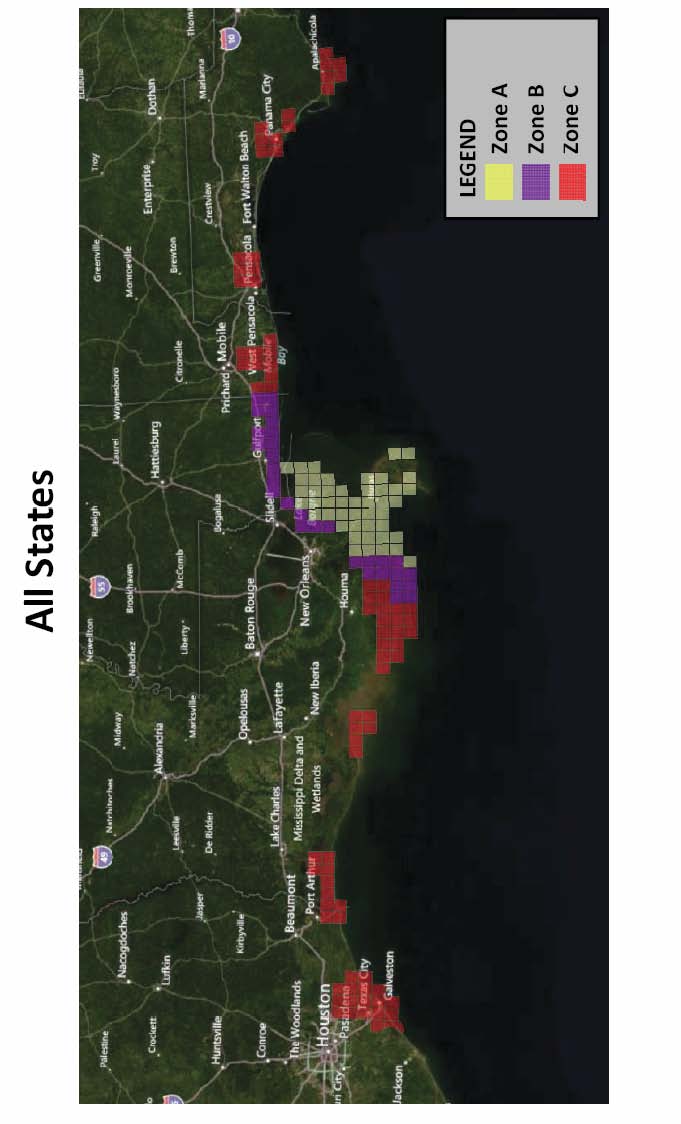
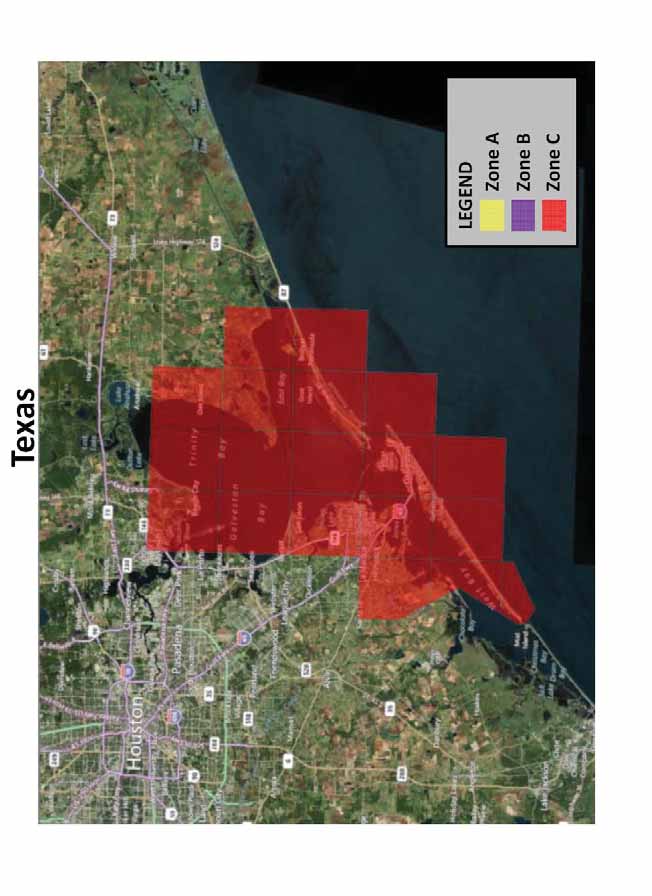
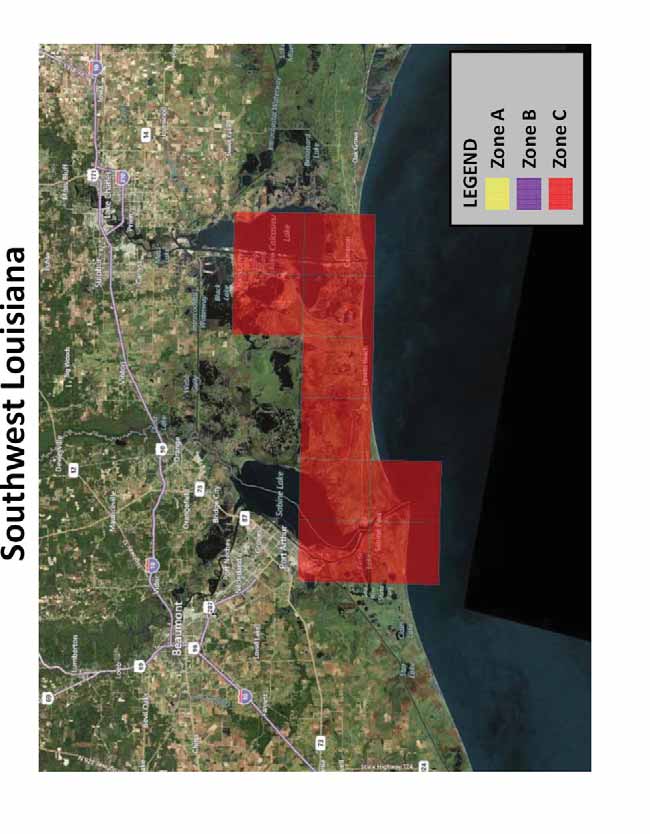


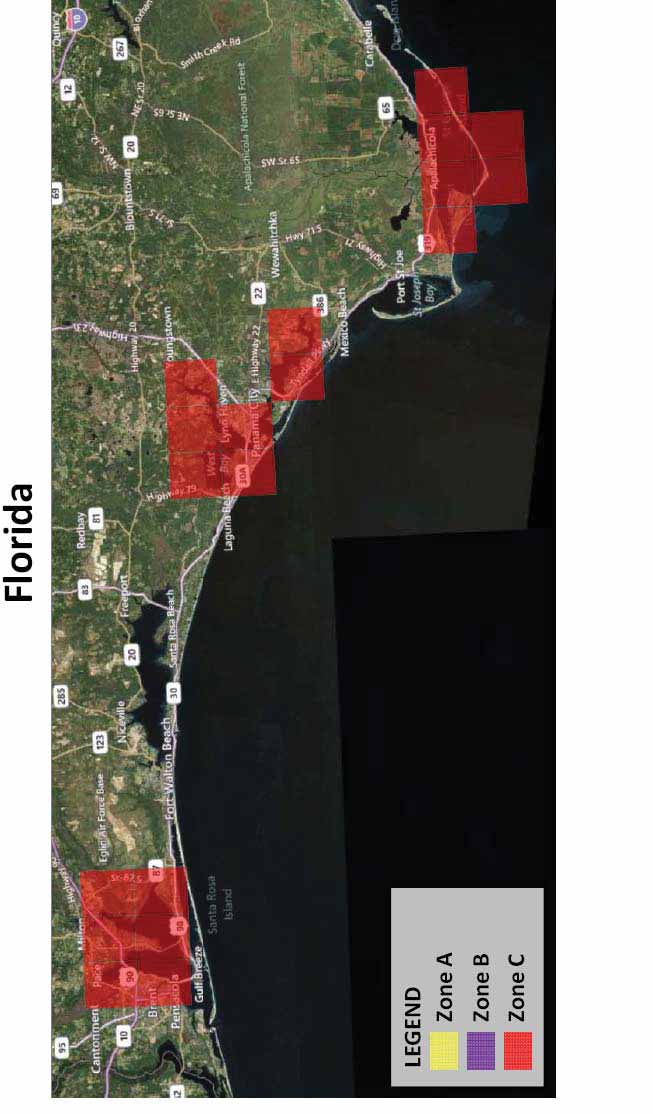
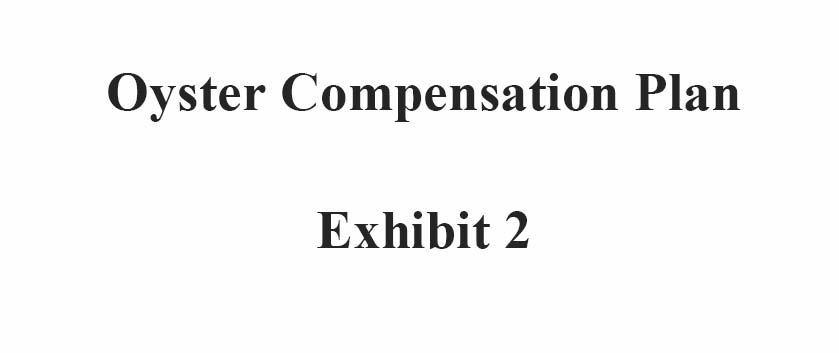
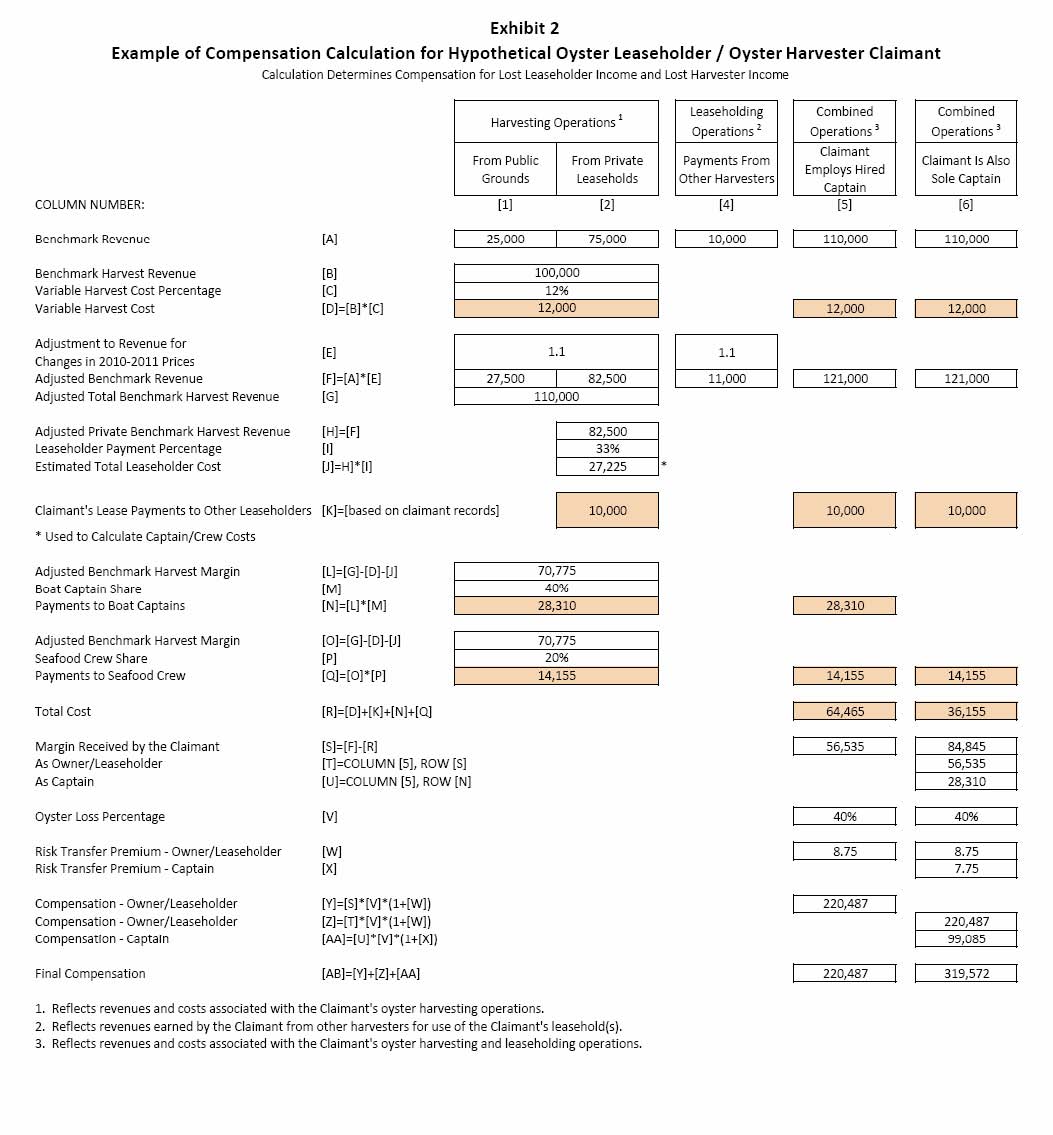
FINFISH COMPENSATION PLAN
Generally Applicable Provisions of the Finfish Compensation Plan:
-
Eligible Claimants shall be comprised of Class Members (i) who do not fall within the exclusions to the Economic Loss and Property Class Definition, (ii) who are Vessel Owners, Commercial Fishermen who lease Seafood Vessels (Commercial Fisherman Vessel Lessee), and/or Seafood Boat Captains that derive income from commercial finfishing, and (iii) who meet the additional criteria listed in this Finfish Compensation Plan.
-
It is understood that in some instances, the Vessel Owner is also the Commercial Fisherman; however, it may be the case that the Vessel Owner leased the vessel to a Commercial Fisherman. In those instances where the vessel was leased during the time period of April 20, 2010 to December 31, 2010, the Vessel Owner and Commercial Fisherman Vessel Lessee must file the vessel claim jointly in order to receive compensation prior to the Bar Date, and they shall share any Vessel Owner/Commercial Fisherman Vessel Lessee compensation provided for in this Finfish Compensation Plan. If at the time of the Bar Date either the Vessel Owner or the Commercial Fisherman Vessel Lessee has not filed a claim, the one that has filed the claim shall receive the full Vessel Owner/Commercial Fisherman Vessel Lessee compensation for the vessel. The allocation of compensation between Vessel Owner and Commercial Fisherman Vessel Lessee shall be determined as provided in Section III. If the vessel was not leased to a Commercial Fisherman Vessel Lessee during the time period of April 20, 2010 to December 31, 2010, the Vessel Owner is entitled to the full Vessel Owner/Commercial Fisherman Vessel Lessee compensation for the vessel.
-
It is understood that in some instances, the Vessel Owner and/or the Commercial Fisherman Vessel Lessee is also the Boat Captain. In those instances where the Vessel Owner and/or the Commercial Fisherman Vessel Lessee were also the Boat Captain, they shall be eligible to receive the Boat Captain compensation portion for the vessel under the Finfish Compensation Plan as set forth below. If the Vessel Owner and/or Commercial Fisherman Vessel Lessee employed a Boat Captain on the vessel and did not serve as a Boat Captain on that vessel, the hired Boat Captain is eligible for the Boat Captain compensation, not the Vessel Owner or Commercial Fisherman Vessel Lessee.
-
To establish eligibility to participate in the Finfish Compensation Plan, a Vessel Owner Claimant must provide for each vessel(s) for which the Claimant is seeking compensation:
A. Proof of ownership of the vessel during the time period of April 20, 2010 to December 31, 2010.
B. Proof that as of April 20, 2010 there was a government license (even if it had expired before that date) that authorized that vessel to commercially fish for finfish in the Specified Gulf Waters for the 2009 season or the 2010 season.
C. The vessel name and any applicable federal and/or state vessel registration identification numbers.
D. Proof that either:
-
the vessel was home ported in the Gulf Coast Areas at any time from April 20, 2010 to April 16, 2012; or,
-
the vessel landed finfish in the Gulf Coast Areas at any time from April 20, 2009 to April 16, 2012.
E. A sworn statement attesting as to whether or not the vessel was leased during the time period April 20, 2010 to December 31, 2010. If the vessel was leased during this time period, the Vessel Owner must provide a copy of the lease agreement.
F. A sworn statement attesting as to whether or not the Vessel Owner was the Boat Captain for that vessel during January 1, 2007 through December 31, 2009. If the Vessel Owner was not the sole Boat Captain for that vessel for some portion of January 1, 2007 through December 31, 2009, to the extent possible, the Claimant shall identify all other Boat Captains employed on the vessel and the time periods for which the Boat Captains were employed.
5. To establish eligibility to participate in the Finfish Compensation Plan, a Commercial Fisherman Vessel Lessee must provide for each vessel for which he or she seeks compensation:
A. Proof that during the period of April 20, 2010 through December 31, 2010 he or she leased the vessel to be used for commercial finfishing.
B. Proof that as of April 20, 2010 there was a government license (even if it had expired before that date) that authorized that vessel to commercially fish for finfish in the Specified Gulf Waters for the 2009 season or the 2010 season.
C. The vessel name and any applicable federal and/or state vessel registration identification numbers.
D. Proof that either:
-
the vessel was home ported in the Gulf Coast Areas at any time from April 20, 2010 to April 16, 2012; or,
-
the vessel landed finfish in the Gulf Coast Areas at any time from April 20, 2009 to April 16, 2012.
E. A sworn statement, attesting that the Commercial Fisherman Vessel Lessee leased the vessel during the time period of April 20, 2010 to December 31, 2010. The Commercial Fisherman Vessel Lessee must also provide a copy of the lease agreement for the vessel.
F. A sworn statement attesting as to whether or not the Commercial Fisherman Vessel Lessee was the Boat Captain for that vessel during January 1, 2007 through December 31, 2009. If the Commercial Fisherman Vessel Lessee was not the sole Boat Captain for that vessel for some portion of January 1, 2007 through December 31, 2009, to the extent possible, the Claimant shall identify all other Boat Captains employed on the vessel and the time periods for which the Boat Captains were employed.
-
To establish eligibility to participate in the Finfish Compensation Plan a Boat Captain must provide:
-
A. Proof that as of April 20, 2010 the Boat Captain held a governmental license (even if it had expired before that date) authorizing the Claimant to operate as a Boat Captain and/or to commercially fish for finfish in the Specified Gulf Waters for the 2009 season or the 2010 season.
-
B. Proof that either the Boat Captain worked:
-
on one or more commercial finfishing vessels that were home ported in the Gulf Coast Areas from April 20, 2010 through the date of execution of the Settlement Agreement; or,
-
one or more commercial finfishing vessels that landed finfish in the Gulf Coast Areas from April 20, 2009 through the date of execution of the Settlement Agreement.
-
A Sworn Statement attesting whether or not the Claimant received any Seafood Spill-Related Payments. If the Claimant received Seafood Spill-Related Payments, the Claimant shall provide documents8 sufficient to establish the timing, amount and source of Seafood Spill-Related Payments, including documents providing the claimant’s BP/GCCF/Transition Facility Claim Number, if applicable, and any corresponding payments.
Finfish Compensation Plan Definition:
Benchmark Period9 is selected by the Claimant and can be (i) 2009, (ii) 2008 and 2009, or
(iii) 2007, 2008 and 2009. If the Claimant elects to use years 2008 and 2009 or 2007, 2008, and 2009, the annual revenue amounts shall be averaged. In the event the Claims Administrator determines that the Claimant (individual or vessel) did not participate at the same level of effort in finfish harvesting due to circumstances beyond the Claimant’s control (such as illness,
8
When documents are requested in the Seafood Compensation Program, Claimant may provide either legible copies or originals of the documents.
9
For the Seafood Compensation Program, the Benchmark Period is defined independently for each Seafood Compensation Program Plan and is set forth within the specific Plan. Definitions of Benchmark Period in any other frameworks in the Deepwater Horizon Economic And Property Damages Settlement Agreement do not apply in the Seafood Compensation Program.
disability or major mechanical failure), the Claims Administrator may at his discretion allow the Claimant to exclude one or more years of the Benchmark Period.
A Vessel Owner or Commercial Fisherman Vessel Lessee must submit separate Vessel Owner/Commercial Fisherman Vessel Lessee claims for each vessel they owned or leased and may select different Benchmark Periods for different vessels.
A Boat Captain’s claim reflects the Claimant’s activities on all vessels, and the Claimant must select a single Benchmark Period for the Boat Captain’s claim.
A Vessel Owner or Commercial Fisherman Vessel Lessee who also submits a Boat Captain claim may select different Benchmark Periods for the Claimant’s Vessel Owner/Commercial Fisherman Vessel Lessee claim and the Claimant’s Boat Captain claim.
Compensation Plan Method:
Vessel Owners/Commercial Fisherman Vessel Lessees and Boat Captains will be compensated through the Historical Revenue Method. A Vessel Owner or Commercial Fisherman Vessel Lessee must submit separate Vessel Owner/Commercial Fisherman Vessel Lessee claims for each vessel they owned or leased.
Additionally, owners of Individual Fishing Quota (“IFQ”) shares may be eligible to receive compensation for their IFQ shares under the IFQ Share Compensation Method.
I. Historical Revenue Method
A. Eligibility Requirements
1. Vessel Owner/Commercial Fisherman Vessel Lessee
To be eligible under the Historical Revenue Method, a Vessel Owner/Commercial Fisherman Vessel Lessee must meet the eligibility requirements of the applicable paragraphs of the “Generally Applicable Provisions of the Finfish Compensation Plan” above and provide evidence to demonstrate his or her commercial finfishing revenue during the selected Benchmark Period.
2. Boat Captains
To be eligible under the Historical Revenue Method, a Boat Captain must meet the eligibility requirements of the applicable paragraphs of the “Generally Applicable Provisions of the Finfish Compensation Plan” above and provide evidence to demonstrate his or her commercial gross earnings from commercial finfishing on vessels for which he or she served as Boat Captain during the selected Benchmark Period.
B. Documentation Required
1. Vessel Owners/Commercial Fisherman Vessel Lessees
Vessel Owners/Commercial Fisherman Vessel Lessees seeking compensation under the Historical Revenue Method must provide documents sufficient to prove the eligibility requirements in Section I.A.1 above and to determine compensation pursuant to Section I.C below, including the following:
a. Trip ticket or their equivalents, such as dealer forms, for each vessel for which Claimant seeks compensation, which show the volume of finfish harvested and the sales price as shown on the trip tickets or their equivalents for the Benchmark Period for finfish landed in the Gulf Coast Areas. The Claimant must provide sufficient documentation for the Claims Administrator to be able to identify gross revenue derived for each vessel solely for finfish landed in the Gulf Coast Areas during the Benchmark Period. The total volume multiplied by price will be the applicable gross revenue.
– OR –
-
b.
-
Federal or state tax and financial information as follows:
i. If Claimant is an entity, federal tax returns or state tax returns, and sufficient documentation to identify components of gross revenue derived from commercial finfish harvesting by vessel for the Benchmark Period for each vessel for which the Claimant submits a Vessel Owner/Commercial Fisherman Vessel Lessee claim.
ii. If Claimant is an individual, federal form 1040 including Schedules C, E and F or state tax forms as well as sufficient documentation to identify those components of earnings derived from commercial finfish harvesting by vessel for the Benchmark Period.
iii. In addition, the Claimant must provide sufficient documentation for the Claims Administrator to be able to identify (i) the Claimant’s revenue from finfishing as compared to other sources and (ii) Claimant’s revenue from landings in the Gulf Coast Areas. If necessary, the Claims Administrator may require supplemental information from the Claimant in order to make these determinations.
c.
In addition, if available, it is requested that the Claimant also provide the following documents, to assist the Claims Administrator:
i. Vessel log book
ii. Share sheets
iii. Proof of vessel size and type
iv. Sales or other production reports maintained in the normal course of business
2. Boat Captains
Boat Captains seeking compensation under the Historical Revenue Method must provide documents sufficient to prove the eligibility requirements in Section I.A.2 and to determine compensation pursuant to Section I.C below, including the following:
a. Trip tickets or their equivalents for each vessel for which the Claimant seeks compensation, which show the volume of finfish harvested and the sales price as shown on the trip tickets or their equivalents for the Benchmark Period for finfish landed in the Gulf Coast Areas. The total volume multiplied by price will be the applicable gross revenue.
– OR –
-
b.
-
Federal tax returns, including Schedules C, E and F, W-2s, and 1099s or state tax returns with supporting documents for the Benchmark Period and sufficient documentation to identify those components of earnings derived from commercial finfish harvesting for the Benchmark Period for the vessel(s) selected by the Claimant. In addition, the Claimant must provide sufficient documentation for the Claims Administrator to be able to identify revenue from finfish landings in the Gulf Coast Areas for each vessel while the Claimant was Boat Captain. If necessary, the Claims Administrator may require supplemental information from the Claimant in order to make these determinations.
c.
In addition, if available, it is requested that the Claimant also provide the following documents, to assist the Claims Administrator:
i. Captain’s log book
ii. Vessel log book
iii. Share sheets
-
iv.
-
Proof of vessel size and type for Captained vessels
v.
Sales or other production reports maintained in the normal course of business
C. Compensation Calculations
1. Calculate Benchmark Finfish Revenue.
a. If trip tickets or their equivalents are used, the volume and price of finfish on the trip tickets or their equivalents are used to calculate gross revenue from finfish landed in the Gulf Coast Areas. If the Claimant is a Vessel Owner/Commercial Fisherman Vessel Lessee, the Claimant may provide trip tickets or their equivalents for the Benchmark Period for each vessel for which compensation is being sought. If the Claimant is a Boat Captain, the Claimant may provide trip tickets or their equivalents for all vessels he or she served as a Captain during the Benchmark Period.
– OR –
b. The Claims Administrator may determine the gross vessel revenue for Boat Captain earnings from finfish landings in the Gulf Coast Areas based on the Claimant’s tax returns, or financial information if the Claims Administrator has sufficient information to determine: (i) Claimant’s revenue from finfish harvesting as compared to other sources, (ii) Claimant’s revenue from finfish landings in the Gulf Coast Areas. If necessary, the Claims Administrator may require supplemental information from the Claimant in order to make these determinations.
2. If (i) the Claimant is a Vessel Owner/Commercial Fisherman Vessel Lessee or (ii) the Claimant is a Boat Captain and Benchmark Revenue was calculated using trip tickets or their equivalents, calculate Benchmark Finfish Cost. Benchmark Finfish Cost is calculated by multiplying Benchmark Finfish Revenue by the Finfish Cost Percentage. The Finfish Cost Percentage, 27%, is expressed as a percentage of revenue and reflects standard industry non-labor variable costs. If the Claimant is a Boat Captain and Benchmark Revenue was calculated based upon his earnings, such as from tax returns or financial information, then no Finfish Cost Percentage is applied, skip to step 3.
Benchmark Finfish Cost = (Benchmark Finfish Revenue * Finfish Cost Percentage)
3. Calculate the Base Finfish Loss using the Finfish Loss Percentage of 25%.
a. If (i) the Claimant is a Vessel Owner/Commercial Fisherman Vessel Lessee or (ii) the Claimant is a Boat Captain and Benchmark Revenue was calculated using trip tickets or their equivalents, the Base Loss is calculated as follows:
47 Base Finfish Loss = (Benchmark Finfish Revenue – Benchmark Finfish Cost) * 25%
b. If the Claimant is a Boat Captain and Benchmark Revenue was calculated using a different source than trip tickets or their equivalents, the Base Loss is calculated as follows:
Base Finfish Loss = Benchmark Finfish Revenue * 25%
4. Determine Base Compensation by multiplying Base Finfish Loss by the appropriate Vessel Owner/Commercial Fisherman Vessel Lessee or Boat Captain share. Vessel Owner/Commercial Fisherman and Boat Captain shares are: 45% for the Vessel/Owner Commercial Fisherman and 35% for the Finfish Boat Captain.
a. Base Compensation for Vessel Owners/Commercial Fisherman Vessel Lessees is calculated as below and found in Table 1:
Base Compensation = Base Finfish Loss * Finfish Vessel Share
TABLE 1
|
FINFISH VESSEL |
FINFISH BOAT |
|
OWNERS/COMMERCIAL |
CAPTAIN SHARE |
|
FISHERMAN VESSEL |
|
|
LESSEE SHARE |
|
|
45% |
35% |
b. Base Compensation for Finfish Boat Captains is calculated as:
i. If Finfish Boat Captain Compensation is calculated based on trip tickets, then the Base Compensation for the Finfish Boat Captain is calculated as:
Base Compensation = Base Finfish Loss * Finfish Boat Captain Share
ii. If Finfish Boat Captain Compensation is calculated based on tax returns and financial records, then the Base Compensation for the Finfish Boat Captain is calculated as:
Base Compensation = Base Finfish Loss
5. Apply the RTP to Base Compensation in order to determine Final Compensation. Base Compensation is specific to Claimant type and is found in Table 2.
48
Final Compensation = Base Compensation + (Base Compensation * RTP)
TABLE 2
|
FINFISH VESSEL |
FINFISH BOAT |
|
OWNERS/COMMERCIAL |
CAPTAINS |
|
FISHERMAN VESSEL |
|
|
LESSEES |
|
|
RTP |
6.0 |
5.0 |
II. Compensation for IFQ Quota Holders
The Finfish Quota Allocation Method provides a fixed compensation amount to Claimants that meet certain requirements and are Individual Fishing Quota (“IFQ”) shareholders.
A. Eligibility and Documentation Requirements
In order to be eligible to qualify for compensation under the Individual Fishing Quota Shareholder Method, the Claimant must provide:
1. Proof of ownership as of April 20, 2010 of the Individual Fishing Quota share for all species identified by IFQs, including Red Snapper, Gag Grouper Red Grouper, Deep Water Grouper Shallow Water Grouper and Tilefish.
B. Compensation Calculations
-
Individual Fishing Quota Shareholders that have provided the proof of eligibility and the required documentation set forth in section II.A. above shall receive the compensation based on the value of Individual Fishing Quota shares held. IFQ shares are defined as the right to catch 0.0001% of the pounds of the catch the relevant species that can be caught by commercial fishermen under the relevant quota.
-
In the aggregate, IFQ holders will receive compensation of $50 million. If the $50 million is not exhausted in payment of IFQ Shareholder claimants, then any remaining amount shall be distributed as part of the balance described in the “General Framework and Overview of Seafood Compensation Program Distribution” section of this Seafood Compensation Program.
-
IFQ Shareholder Claimants will be compensated in proportion to the percentage of the total value of IFQ shares, calculated across all species. The relevant prices and aggregate value of IFQ shares is summarized in Table 2. The table reports NOAA 2010 IFQ data on the prices at which IFQ shares were sold, with a “share” defined as 0.0001% of pounds of catch allowed under the species-specific IFQ program.
TABLE 2
|
Species |
Price per .0001% Share |
Total Value ($Million) |
|
Red Snapper |
$44.90 |
$44.9 |
|
Gag Grouper |
$6.75 |
$6.8 |
|
Red Grouper |
$20.67 |
$20.7 |
|
Deep Water Grouper |
$4.99 |
$5.0 |
|
Shallow Water Grouper |
$1.64 |
$1.6 |
|
Tilefish |
$1.08 |
$1.1 |
|
Total |
|
$80.0 |
4. Compensation for IFQ share holders is calculated as follows:
-
a.
-
The value of a Claimant’s IFQ shares is calculated as the product of the species-specific number of quota shares held and the species-specific value per quota share, as reflected in Table 3.
b.
The compensation received by a Claimant is calculated by multiplying the value of the Claimant’s share multiplied by 0.625.
For example, a Claimant with 1,000 shares of Red Grouper would have a IFQ share value of $20,670 (1,000 shares * $20.67). The Claimant would then receive compensation of $12,918.75 ($20,670 * 0.625).
III. Vessel Lease Compensation Allocation
To the extent the Vessel was leased by the Vessel Owner to the Commercial Fisherman Vessel Lessee as of April 20, 2010, compensation will be allocated between the parties based upon Benchmark Revenue, as calculated above and Annual Lease Payment. The Annual Lease Payment shall be calculated as the annual payment to the Vessel Owner by the Commercial Fisherman Vessel Lessee for the lease in effect as of April 20, 2010. The ratio of the Annual Lease Payment to Benchmark Revenue multiplied by the Final Compensation determines the Vessel Owner Share of Final Compensation. The Commercial Fisherman Vessel Lessee’s Share of Compensation is Final Compensation less the Vessel Owner’s Share of Final Compensation.
Vessel Owner Share of Final Compensation = Final Compensation * (Annual Lease Payment / Benchmark Revenue)
Commercial Fisherman Vessel Lessee’s Share of Final Share of Compensation = Final Compensation - Vessel Owner Share of Final Compensation.

BLUE CRAB/OTHER SEAFOOD COMPENSATION PLAN
Generally Applicable Provisions of the Blue Crab/Other Seafood Compensation Plan:
-
Eligible Claimants shall be comprised of Class Members (i) who do not fall within the exclusions to the Economic Loss and Property Class Definition, (ii) who are Vessel Owners, Commercial Fishermen who lease Seafood Vessels (Commercial Fisherman Vessel Lessee), and/or Seafood Boat Captains that derive income from commercial fishing for blue crab and/or Other Seafood,10 and (iii) who meet the additional criteria listed in this Blue Crab/Other Seafood Compensation Plan.
-
It is understood that in some instances, the Vessel Owner is also the Commercial Fisherman; however, it may be the case that the Vessel Owner leased the vessel to a Commercial Fisherman. In those instances where the vessel was leased during the time period of April 20, 2010 to December 31, 2010, the Vessel Owner and Commercial Fisherman Vessel Lessee must file the vessel claim jointly in order to receive compensation prior to the Bar Date, and they shall share any Vessel Owner/Commercial Fisherman Vessel Lessee compensation provided for in this Blue Crab/Other Seafood Compensation Plan. If at the time of the Bar Date either the Vessel Owner or the Commercial Fisherman Vessel Lessee has not filed a claim, the one that has filed the claim shall receive the full Vessel Owner/Commercial Fisherman Vessel Lessee compensation for the vessel. The allocation of compensation between Vessel Owner and Commercial Fisherman Vessel Lessee shall be determined as provided in Section II. If the vessel was not leased to a Commercial Fisherman Vessel Lessee during the time period of April 20, 2010 to December 31, 2010, the Vessel Owner is entitled to the full Vessel Owner/Commercial Fisherman Vessel Lessee compensation for the vessel.
-
It is understood that in some instances, the Vessel Owner and/or the Commercial Fisherman Vessel Lessee is also the Boat Captain. In those instances where the Vessel Owner and/or the Commercial Fisherman Vessel Lessee were also the Boat Captain, they shall be eligible to receive the Boat Captain compensation portion for the vessel under the Blue Crab/Other Seafood Compensation Plan as set forth below. If the Vessel Owner and/or Commercial Fisherman Vessel Lessee employed a Boat Captain on the vessel and did not serve as a Boat Captain on that vessel, the hired Boat Captain is eligible for the Boat Captain compensation, not the Vessel Owner or Commercial Fisherman Vessel Lessee.
-
To establish eligibility to participate in the Blue Crab/Other Seafood Compensation Plan, a Vessel Owner Claimant must provide for each vessel(s) for which the Claimant is seeking compensation:
A. Proof of ownership of the vessel during the time period of April 20, 2010 to December 31, 2010.
Other Seafood shall be defined to mean all forms of seafood included in the Exhibit 3 of the Deepwater Horizon Economic And Property Damages Settlement Agreement (Seafood Distribution Chain Definitions) including stone crab and spiny lobster, but excluding shrimp, oysters, finfish and blue crab.
B. Proof that as of April 20, 2010 there was a government license (even if it had expired before that date) that authorized that vessel to commercially fish for blue crab or Other Seafood in the Specified Gulf Waters for the 2009 season or the 2010 season.
C. The vessel name and any applicable federal and/or state vessel registration identification numbers.
D. Proof that either:
-
the vessel was home ported in the Gulf Coast Areas at any time from April 20, 2010 to April 16, 2012; or,
-
the vessel landed blue crab and/or Other Seafood in the Gulf Coast Areas at any time from April 20, 2009 to April 16, 2012.
E. A sworn statement attesting as to whether or not the vessel was leased during the time period April 20, 2010 to December 31, 2010. If the vessel was leased during this time period, the Vessel Owner must provide a copy of the lease agreement.
F. A sworn statement attesting as to whether or not the Vessel Owner was the Boat Captain for that vessel during January 1, 2007 through December 31, 2009. If the Vessel Owner was not the sole Boat Captain for that vessel for some portion of January 1, 2007 through December 31, 2009, to the extent possible, the Claimant shall identify all other Boat Captains employed on the vessel and the time periods for which the Boat Captains were employed.
5. To establish eligibility to participate in the Blue Crab/Other Seafood Compensation Plan, a Commercial Fisherman Vessel Lessee must provide for each vessel for which the Claimant seeks compensation:
A. Proof that during the period of April 20, 2010 through December 31, 2010 the Claimant leased the vessel to be used for commercial blue crab and/or Other Seafood harvesting.
B. Proof that as of April 20, 2010 there was a government license (even if it had expired before that date) that authorized that vessel to commercially fish for blue crab and/or Other Seafood in the Specified Gulf Waters for the 2009 season or the 2010 season.
C. The vessel name and any applicable federal and/or state vessel registration identification numbers.
D. Proof that either:
-
the vessel was home ported in the Gulf Coast Areas at any time from April 20, 2010 to April 16, 2012; or,
-
the vessel landed blue crab and/or Other Seafood in the Gulf Coast Areas at any time from April 20, 2009 to April 16, 2012.
E. A sworn statement, attesting that the Commercial Fisherman Vessel Lessee leased the vessel during the time period of April 20, 2010 to December 31, 2010. The Commercial Fisherman Vessel Lessee must also provide a copy of the lease agreement for the vessel.
F. A sworn statement attesting as to whether or not the Commercial Fisherman Vessel Lessee was the Boat Captain for that vessel during January 1, 2007 through December 31, 2009. If the Commercial Fisherman Vessel Lessee was not the sole Boat Captain for that vessel for some portion of January 1, 2007 through December 31, 2009, to the extent possible, the Claimant shall identify all other Boat Captains employed on the vessel and the time periods for which the Boat Captains were employed.
-
To establish eligibility to participate in the Blue Crab/Other Seafood Compensation Plan a Boat Captain must provide:
-
A. Proof that as of April 20, 2010 the Boat Captain held a governmental license (even if it had expired before that date) authorizing the Claimant to operate as a Boat Captain and/or to commercially fish for blue crab and/or Other Seafood in the Specified Gulf Waters for the 2009 season or the 2010 season.
-
B. Proof that either the Boat Captain worked:
-
on one or more commercial blue crab or Other Seafood vessels that were home ported in the Gulf Coast Areas at any time from April 20, 2010 to April 16, 2012; or,
-
on one or more commercial blue crab or Other Seafood vessels that landed blue crab or Other Seafood in the Gulf Coast Areas at any time from April 20, 2009 to April 16, 2012.
-
A Sworn Statement attesting whether or not the Claimant received any Seafood Spill-Related Payments. If the Claimant received Seafood Spill-Related Payments, the Claimant shall provide documents11 sufficient to establish the timing, amount and source of Seafood Spill-Related Payments, including documents providing the claimant’s BP/GCCF/Transition Facility Claim Number, if applicable, and any corresponding payments.
When documents are requested in the Seafood Compensation Program, Claimant may provide either legible copies or originals of the documents.
Blue Crab/Other Seafood Compensation Plan Definition:
Benchmark Period12 is selected by the Claimant and can be (i) 2009, (ii) 2008 and 2009, or
(iii) 2007, 2008 and 2009. If the Claimant elects to use years 2008 and 2009 or 2007, 2008, and 2009, the annual revenue amounts shall be averaged. In the event the Claims Administrator determines that the Claimant (individual or vessel) did not participate at the same level of effort in blue crab/other seafood harvesting due to circumstances beyond the Claimant’s control (such as illness, disability or major mechanical failure), the Claims Administrator may at his discretion allow the Claimant to exclude one or more years of the Benchmark Period.
A Vessel Owner or Commercial Fisherman Vessel Lessee must submit separate Vessel Owner/Commercial Fisherman Vessel Lessee claims for each vessel they owned or leased and may select different Benchmark Periods for different vessels.
A Boat Captain’s claim reflects the Claimant’s activities on all vessels, and the Boat Captain must select a single Benchmark Period for the Claimant’s claim.
A Vessel Owner or Commercial Fisherman Vessel Lessee who also submits a Boat Captain claim may select different Benchmark Periods for the Claimant’s Vessel Owner/Commercial Fisherman Vessel Lessee claim and the Claimant’s Boat Captain claim.
Compensation Plan Method:
Vessel Owners/Commercial Fisherman Vessel Lessees and Boat Captains will be separately compensated for blue crab claims and Other Seafood claims through the Historical Revenue Method. Claimants may submit a claim for either or both blue crab or Other Seafood categories. Compensation for blue crab claims is set forth in Section I.C and compensation for Other Seafood claims is set forth in Section I.D. A Vessel Owner or Commercial Fisherman Vessel Lessee must submit separate Vessel Owner/Commercial Fisherman Vessel Lessee claims for each vessel they owned or leased.
Additionally, Vessel Owners and Commercial Fisherman Vessel Lessees that establish they commercially fished for blue crab in the Benchmark Period and who satisfy the applicable paragraphs of the Generally applicable Provisions of the Blue Crab/Other Seafood Compensation Plan above and in Section I.A. below will receive a lump sum payment as set forth in Section I.
For the Seafood Compensation Program, the Benchmark Period is defined independently for each Seafood Compensation Program Plan and is set forth within the specific Plan. Definitions of Benchmark Period in any other frameworks in the Deepwater Horizon Economic And Property Damages Settlement Agreement do not apply in the Seafood Compensation Program.
I. Historical Revenue Method
A. Eligibility Requirements
1. Vessel Owner/Commercial Fisherman Vessel Lessee
To be eligible under the Historical Revenue Method, a Vessel Owner/Commercial Fisherman Vessel Lessee must meet the eligibility requirements of the applicable paragraphs of the “Generally Applicable Provisions of the Blue Crab/Other Seafood Compensation Plan” and provide evidence to demonstrate the Claimant’s commercial blue crab and/or Other Seafood revenue during the selected Benchmark Period.
2. Boat Captains
To be eligible under the Historical Revenue Method, a Boat Captain must meet eligibility requirements of the applicable paragraphs of the “Generally Applicable Provisions of the Blue Crab/Other Seafood Compensation Plan” requirements of the Blue Crab/Other Seafood Compensation Plan and provide evidence to demonstrate the Claimant’s gross earnings from commercial blue crab and/or Other Seafood harvesting on vessels for which the Claimant served as Boat Captain during the selected Benchmark Period.
B. Documentation Required
1. Vessel Owners/Commercial Fisherman Vessel Lessees
Vessel Owners/Commercial Fisherman Vessel Lessees seeking compensation under the Historical Revenue Method must provide documents sufficient to prove the eligibility requirements in Section I.A.1 above and to determine compensation pursuant to Section I.C or
I.D below, including the following:
a. Trip ticket or their equivalents, such as dealer forms, for each vessel for which Claimant seeks compensation, which show the volume of blue crab and/or Other Seafood harvested and the sales price as shown on the trip tickets or their equivalents for the Benchmark Period for blue crab and/or Other Seafood landed in the Gulf Coast Areas. The Claimant must provide sufficient documentation for the Claims Administrator to be able to identify gross revenue derived for each vessel solely for blue crab and/or Other Seafood landed in the Gulf Coast Areas during the Benchmark Period. The total volume multiplied by price will be the applicable gross revenue.
– OR –
-
b.
-
Federal or state tax returns and financial information as follows:
i. If Claimant is an entity, federal tax returns, state tax returns and sufficient documentation to identify components of
gross revenue derived from commercial blue crab and/or Other Seafood harvesting by vessel for the Benchmark Period for each vessel for which the Claimant submits a Vessel Owner/Commercial Fisherman Vessel Lessee claim.
ii. If Claimant is an individual, federal form 1040 including Schedules C, E and F or state tax forms and supporting documents as well as sufficient documentation to identify by vessel components of gross earnings derived from commercial blue crab and/or Other Seafood harvesting for the Benchmark Period for each vessel for which the Claimant submits a Vessel Owner/Commercial Fisherman Vessel Lessee claim.
iii. In addition, the Claimant must provide sufficient documentation for the Claims Administrator to be able to identify (i) the Claimant’s revenue from blue crab and/or Other Seafood as compared to other sources and
(ii) Claimant’s revenue from landings in the Gulf Coast Areas. If necessary, the Claims Administrator may require supplemental information from the Claimant in order to make these determinations.
c.
In addition, if available, it is requested that the Claimant also provide the following documents, to assist the Claims Administrator:
i. Vessel log book
ii. Share sheets
iii. Proof of vessel size and type
iv. Sales or other production reports maintained in the normal course of business
2. Boat Captains
Boat Captains seeking compensation under the Historical Revenue Method must provide documents sufficient to prove the eligibility requirements in Section I.A.2 above and to determine compensation pursuant to Section I.C. or I.D. below, including the following:
a. Trip tickets or their equivalents for each vessel for which the Claimant seeks compensation, which show the volume of blue crab and/or Other Seafood harvested and the sales price as shown on the trip tickets or their equivalents for the Benchmark Period for blue crab and/or Other Seafood landed in the Gulf Coast Areas. The total volume multiplied by price will be the applicable gross revenue.
– OR –
-
b.
-
Federal tax returns, including Schedules C, E and F, W-2s, and 1099s or state tax returns with supporting documents for the Benchmark Period and sufficient documentation to identify those components of gross earnings derived from commercial blue crab and/or Other Seafood harvesting for the Benchmark Period for the vessel(s) selected by the Claimant. In addition, the Claimant must provide sufficient documentation for the Claims Administrator to be able to identify revenue from blue crab and/or Other Seafood landings in the Gulf Coast Areas for each vessel while the Claimant was Boat Captain. If necessary, the Claims Administrator may require supplemental information from the Claimant in order to make these determinations.
c.
In addition, if available, it is requested that the Claimant also provide the following documents, to assist the Claims Administrator:
i. Captain’s log book
ii. Vessel log book
iii. Share sheets
-
iv.
-
Proof of vessel size and type for Captained vessels
v.
Sales or other production reports maintained in the normal course of business
C. Compensation Calculations for Blue Crab
The Claims Administrator shall determine compensation separately for blue crab and for Other Seafood. The compensation for gross revenue or earnings attributable to blue crab is determined as set forth in Section I.C. The separate and independent compensation for gross revenue or earnings attributable to Other Seafood is determined as set forth in Section I.D.
1. Calculate Benchmark Blue Crab Revenue.
a. If trip tickets or their equivalents are used, the volume and price of blue crab on the trip tickets or their equivalents are used to calculate gross revenue from blue crab landed in the Gulf Coast Areas. If the Claimant is a Vessel Owner/Commercial Fisherman Vessel Lessee, the Claimant may provide trip tickets for the Benchmark Period for each Vessel for which compensation is being sought. If the Claimant is a Boat Captain, the Claimant may provide trip tickets or their equivalents for all vessels the Claimant served as a Captain during the Benchmark Period.
– OR –
b. The Claims Administrator may determine the gross vessel revenue or Boat Captain earnings from blue crab landings in the Gulf Coast Areas based on the Claimant’s tax returns or financial information if the Claims Administrator has sufficient information to determine: (i) Claimant’s revenue from blue crab as compared to other sources and (ii) Claimant’s revenue from blue crab landings in the Gulf Coast Areas. If necessary, the Claims Administrator may require supplemental information from the Claimant in order to make these determinations.
2. Calculate Total Adjusted Benchmark Blue Crab Revenue by multiplying the Adjusted Benchmark Blue Crab Revenue by 1.2, the Adjustment for Changes in 2010-11 Prices.
Total Adjusted Benchmark Blue Crab Revenue =
(Benchmark Blue Crab Revenue * Adjustment for Changes in 2010-11 Prices).
3. If (i) the Claimant is a Vessel Owner/Commercial Fisherman Vessel Lessee or (ii) the Claimant is a Boat Captain and Benchmark Revenue was calculated using trip tickets or their equivalents, calculate Benchmark Blue Crab Cost. Benchmark Blue Crab Cost is calculated by multiplying Benchmark Blue Crab Revenue by the Blue Crab Cost Percentage of 35%. The Blue Crab Cost Percentage is expressed as a percentage of revenue and reflects standard industry non-labor variable costs. If the Claimant is a Boat Captain and Benchmark Revenue was calculated based upon his earnings, such as from tax returns or financial information, then no Blue Crab Cost Percentage is applied, skip to step 4.
Benchmark Blue Crab Cost = (Benchmark Blue Crab Revenue * Blue Crab Cost Percentage)
4. Calculate the Base Blue Crab Loss using the Blue Crab Loss Percentage of 35%.
a. If (i) the Claimant is a Vessel Owner/Commercial Fisherman Vessel Lessee or (ii) the Claimant is a Boat Captain and Benchmark Revenue was calculated using trip tickets or their equivalents, the Base Loss is calculated as follows:
Base Blue Crab Loss =
(Total Adjusted Benchmark Blue Crab Revenue – Benchmark Blue Crab Cost) * 35%
b. If the Claimant is a Boat Captain and Total Adjusted Benchmark Revenue was calculated using a different source than trip tickets or their equivalents, the Base Loss is calculated as follows:
Base Blue Crab Loss = Adjusted Benchmark Blue Crab Revenue * 35%
5. Determine Base Compensation by multiplying Base Blue Crab Loss by the appropriate Vessel Owner/Commercial Fisherman Vessel Lessee share. Vessel Owner and Boat Captain shares are presented in Table 1.
a. Base Compensation for Vessel Owners/Commercial Fisherman Vessel Lessees is calculated as:
Base Compensation = Base Blue Crab Loss * 50%
b. Base Compensation for Blue Crab Boat Captains is calculated as:
i. if Blue Crab Boat Captain Compensation is calculated based on trip tickets, then the Base Compensation for Blue Crab Boat Captain is calculated as:
Base Compensation = Base Blue Crab Loss * 30%
ii. If Blue Crab Boat Captain Compensation is calculated based on tax returns and financial records, Compensation for Blue Crab Boat Captain is calculated as:
Base Compensation = Base Blue Crab Loss
TABLE 1
BLUE CRAB VESSEL
BLUE CRAB BOAT OWNER/COMMERCIAL
CAPTAIN SHARE FISHERMAN VESSEL LESSEE SHARE
50%
30%
6. Apply the RTP to Base Compensation in order to determine Final Compensation. Base Compensation is specific to Claimant type and is found in Table 2.
Final Blue Crab Compensation = Base Compensation + (Base Compensation * RTP)
TABLE 2
BLUE CRAB BOAT OWNERS/COMMERCIAL
BLUE CRAB VESSEL
CAPTAINS FISHERMAN VESSEL LESSEES
RTP
6.0
5.0
In addition, Vessel Owners/Commercial Fisherman Vessel Lessees who receive Final Blue Crab Compensation shall also receive a lump sum payment of $7,500 per vessel.
D. Compensation Calculations for Other Seafood
1. Calculate Benchmark Other Seafood Revenue
a. If trip tickets or their equivalents are used, the volume and price of Other Seafood on the trip tickets or their equivalents are used to calculate gross revenue from Other Seafood landed in the Gulf Coast Areas. If the Claimant is a Vessel Owner/Commercial Fisherman Vessel Lessee, the Claimant may provide trip tickets or their equivalents for the Benchmark Period for each Vessel for which compensation is being sought. If the Claimant is a Boat Captain, the Claimant may provide trip tickets for all vessels the Claimant served as a Captain during the Benchmark Period.
– OR –
b. The Claims Administrator may determine the gross vessel revenue or Boat Captain earnings from Other Seafood landings in the Gulf Coast Areas based on the Claimant’s tax returns, monthly profit and loss statements, or financial information if the Claims Administrator has sufficient information to determine:
(i) Claimant’s revenue from Other Seafood as compared to other sources and (ii) Claimant’s revenue from Other Seafood landings in the Gulf Coast Areas. If necessary, the Claims Administrator may require supplemental information from the Claimant in order to make these determinations.
2. Calculate Total Adjusted Benchmark Other Seafood Revenue by multiplying the Additional Catch Adjusted Benchmark Other Seafood Revenue by 1.1, the Adjustment for Changes in 2010-11 Prices.
Total Adjusted Benchmark Other Seafood Revenue =
(Benchmark Other Seafood Revenue * Adjustment for Changes in 2010-11 Prices).
3. If (i) the Claimant is a Vessel Owner/Commercial Fisherman Vessel Lessee or (ii) the Claimant is a Boat Captain and Benchmark Revenue was calculated using trip tickets or their equivalents, calculate Benchmark Other Seafood Cost. Benchmark Other Seafood Cost is calculated by multiplying Benchmark Other Seafood Revenue by the Other Seafood Cost Percentage of 35%. The Other Seafood Cost Percentage is expressed as a percentage of revenue and reflects standard industry non-labor variable costs. If the Claimant is a Boat Captain and Benchmark Revenue was calculated based upon his earnings, such as from tax returns or financial information, then no Other Seafood Cost Percentage is applied, skip to step 5.
Benchmark Other Seafood Cost =
(Benchmark Other Seafood Revenue * Other Seafood Cost Percentage)
4. Calculate the Base Other Seafood Loss using the Other Seafood Loss Percentage of 10%.
a. If (i) the Claimant is a Vessel Owner/Commercial Fisherman Vessel Lessee or (ii) the Claimant is a Boat Captain and Benchmark Revenue was calculated using trip tickets or their equivalents, the Base Loss is calculated as follows
Base Other Seafood Loss = (Total Adjusted Benchmark Other Seafood Revenue – Benchmark Other Seafood Cost) * 10%
b. If the Claimant is a Boat Captain and Benchmark Revenue was calculated using a different source than trip tickets or their equivalents, the Base Loss is calculated as follows
Base Other Seafood Loss = Total Adjusted Benchmark Other Seafood Revenue * 10%
5. Determine Base Compensation by multiplying Base Other Seafood Loss by the appropriate Vessel Owner/Commercial Fisherman Vessel Lessee or Boat Captain share. Vessel Owner and Boat Captain shares are presented in Table 3.
a. Base Compensation for Vessel Owners/Commercial Fisherman Vessel Lessees is calculated as:
Base Compensation = Base Other Seafood Loss * 50%
b. Base Compensation for Other Seafood Boat Captains is calculated as:
i. If Other Seafood Boat Captain Compensation is calculated based on trip tickets, then Other Seafood Boat Captain Base Compensation is calculated as:
Base Compensation = Base Other Seafood Loss * 30%
ii. If Other Seafood Boat Captain Compensation is calculated based on tax returns and financial records, then Other Seafood Boat Captain Base Compensation is calculated as:
Base Compensation = Base Other Seafood Loss
TABLE 3
OTHER SEAFOOD
OTHER SEAFOOD VESSEL
BOAT CAPTAIN OWNER/COMMERCIAL
SHARE
FISHERMAN VESSEL
LESSEE SHARE
50%
30%
6. Apply the RTP to Base Compensation in order to determine Final Compensation. Base Compensation is specific to Claimant type and is found in Table 1.
Final Compensation = Base Compensation + (Base Compensation * RTP)
TABLE 4
|
OTHER SEAFOOD |
OTHER SEAFOOD BOAT |
|
VESSEL |
CAPTAINS |
|
OWNERS/COMMERCIAL |
|
|
FISHERMAN VESSEL |
|
|
LESSEES |
|
|
RTP |
5.5 |
4.5 |
II. Vessel Lease Compensation Allocation
To the extent the Vessel was leased by the Vessel Owner to the Commercial Fisherman Vessel Lessee as of April 20, 2010, compensation will be allocated between the parties based upon Benchmark Revenue, as calculated above and Annual Lease Payment. The Annual Lease Payment shall be calculated as the annual payment to the Vessel Owner by the Commercial Fisherman Vessel Lessee for the lease in effect as of April 20, 2010. The ratio of the Annual Lease Payment to Benchmark Revenue multiplied by the Final Compensation determines the Vessel Owner Share of Final Compensation. The Commercial Fisherman Vessel Lessee’s Share of Compensation is Final Compensation less the Vessel Owner’s Share of Final Compensation.
Vessel Owner Share of Final Compensation = Final Compensation * (Annual Lease Payment / Benchmark Revenue)
Commercial Fisherman Vessel Lessee’s Share of Final Share of Compensation = Final Compensation - Vessel Owner Share of Final Compensation.
Seafood Crew Compensation Plan for Individuals Who Are Seafood First Mates, Seafood
Second Mates, Seafood Boatswains, and Seafood Deckhands
Overview
This Seafood Crew Compensation Plan is for Class Members who are Seafood First Mates, Seafood Second Mates, Seafood Boatswains and Seafood Deckhands claiming economic loss from employment by a Commercial Fisherman due to or resulting from the Deepwater Horizon oil spill. Claimants seeking compensation under Category I or III must show they were employed by a Commercial Fisherman in 2009, and Claimants seeking compensation under Category II must show that they were employed by a Commercial Fisherman in 2009 or that they had accepted a job offer to work for a Commercial Fisherman in 2010.
Any eligible Claimant may receive compensation based upon one of the following three categories (but no more than one of the three categories), provided the Claimant satisfies the requirements outlined below.
I. INDIVIDUAL CLAIMANTS WITH TAX INFORMATION OR PAY PERIOD EARNINGS DOCUMENTATION FOR 2009: Applies to Claimants providing Tax Information Documents or Pay Period Earnings Documentation for the selected Base Year(s). Requirements detailed in Section I must be fulfilled.
II. INDIVIDUAL CLAIMANTS WITHOUT TAX INFORMATION OR PAY PERIOD EARNINGS DOCUMENTATION WHO SUBMIT A CLAIMANT SWORN WRITTEN STATEMENT AND EMPLOYER SWORN WRITTEN STATEMENT TO
ESTABLISH EARNINGS: Applies to two types of Claimants: (i) those without sufficient Tax Information Documents or Pay Period Earnings Documentation regarding 2009 earnings, but who provide Sworn Written Statements (from both the Claimant and the Claimant’s employer) presenting employment and compensation information for 2009; and (ii) those with proof of an offer of employment in a Claiming Job for 2010. Requirements detailed in Section II must be fulfilled.
III. INDIVIDUAL CLAIMANTS WITHOUT TAX INFORMATION OR PAY PERIOD EARNINGS DOCUMENTATION WHO SUBMIT A CLAIMANT SWORN WRITTEN STATEMENT, SPONSOR SWORN WRITTEN STATEMENT(S) AND ATTORNEY SWORN WRITTEN STATEMENT (IF APPLICABLE) TO ESTABLISH EARNINGS: Applies to Claimants without sufficient Tax Information Documents or Pay Period Earnings Documentation and without an Employer Sworn Written Statement to document earnings for 2009 but who provide at least three Sworn Written Statements presenting employment and compensation information for 2009. Requirements detailed in Section III must be fulfilled.
Definitions
The following defined terms used in this Seafood Crew Compensation Plan shall have the meanings set forth below and be presented in bold-faced type.13
A. Actual Earnings: Claimant’s Income actually earned from the Claiming Job.
B. Base Year(s): A Claimant selected period, applicable to Category I only, used for historical comparison and defined as one of the following options, provided that once selected, the same Base Year(s) shall be used in this Seafood Crew Compensation Plan for all purposes for which a Base Year(s) is required for that Claimant. Provided further, a Claimant is restricted to the following three options in choosing the Claimant’s Base Year(s).
-
2009; or
-
The average of 2008 and 2009; or
-
The average of 2007, 2008 and 2009.
C. Benchmark Period: For purposes of this Seafood Crew Compensation Plan, the Benchmark Period for claimants in Category I is the period of April 20 through December 31 of the year or years selected from the Base Year(s), and the Benchmark Period for claimants in Categories II and III is April 20, 2009 through December 31, 2009. The Benchmark Period is used to establish baseline earnings to be used in calculating the Claimant’s lost earnings arising out of the harvesting of seafood due to the Deepwater Horizon oil spill.
D. Category II Aggregate Compensation Amount: $80 million is the Aggregate Compensation Amount for Category II claims.
E. Category III Aggregate Compensation Amount: $50 million is the Aggregate Compensation Amount available to pay Category III claims.
F. Claiming Job(s): The job held by the Claimant that meets the definition of Seafood First Mate, Seafood Second Mate, Seafood Boatswain or Seafood Deckhand.
G. Claims Administrator: The Claims Administrator and related staff appointed pursuant to the Deepwater Horizon Economic And Property Damages Settlement Agreement.
H. Income: Gross earnings from the Claiming Job.
These definitions apply to the Seafood Crew Compensation Plan only and not to other aspects of the Seafood Compensation Program generally.
I. Pay Period Earnings Documentation: Documentation sufficient to establish a Claimant’s earnings from employment and hours worked during the applicable Benchmark Period. Documentation may include:
-
Paycheck stubs; and/or
-
Other employer records documenting actual amounts paid, if applicable; and/or
-
Bank records showing income deposits and supporting documentation indicating the source of those deposits; and/or
-
Receipts or records from check cashing or payday loan services and supporting documentation indicating the source of those funds; and/or
-
Contracts for employment accompanied by documentation establishing that wages or other amounts to be paid pursuant to the contract, if applicable, were in fact paid; and/or
-
Pay period earnings detail submitted under oath and included in court filings (for example, documentation provided in connection with divorce, child support, or wage garnishment proceedings).
J. Tax Information Documents: Tax Returns or Forms W-2 and/or 1099s.
K. Tax Returns: Federal or state income tax returns, including any relevant supporting schedules.
L. Sworn Claim Form: Each Claimant must complete and submit a Claim Form which the Claimant shall verify under penalties of perjury. The Claim Form shall direct the Claimant to provide information, including the Claimant’s chosen Base Year(s) for Category I. The Claimant shall attach required documents supporting the claim. All statements made in, and documents submitted with, the Sworn Claim Form may be verified as judged necessary by the Claims Administrator. The Claimant shall provide forms in which the Claimant shall authorize the Claims Administrator to: (1) verify employment and obtain copies of wage records, (2) obtain the relevant Tax Information Documents from the Internal Revenue Service and/or Social Security Administration, and (3) confirm any bank account information used in support of a claim, but the authorization for bank records shall be limited to the Claimant’s chosen Base Year(s). The Claim Form may be submitted in electronic fashion, including scanning of documents or copies of verification from public databases providing the same information as would be provided by the original document.
I. CATEGORY I: INDIVIDUAL CLAIMANTS WITH TAX INFORMATION OR PAY PERIOD EARNINGS DOCUMENTATION FOR 2009
Category I is open to all eligible Class Members claiming economic loss arising out of the harvesting of Seafood where the Claimant was employed by a Commercial Fisherman in 2009, worked or anticipated to work harvesting Seafood in 2010, and can provide sufficient documentation as set forth below. Claimant must provide either:
(i) Claimant’s federal or state Tax Information Documents (Tax Returns or Forms W-2 and/or 1099) for the selected Base Year(s) or (ii) Pay Period Earnings Documentation sufficient to establish earnings from the Claiming Job for the selected Base Year(s). The Claimant’s compensation shall be calculated as set forth in Section
-
below and shall be based on the earnings from the Benchmark Period and the applicable RTP.
-
Documentation Requirements
1. Documentation Establishing Employment Earnings: For each year included in the selected Base Year(s), Individual Claimants must provide at least one of the following Tax Information Documents:
-
Federal tax Form 1040 pages 1 and 2, all pages of Schedules C, E, and F, and any supporting statements attached to the Form 1040 filing (including Form W-2s for joint returns); or
-
State tax return, including any supporting schedules or statements; or
-
Forms W-2 documenting earnings from the Claiming Job; or
-
Forms 1099 documenting earnings from the Claiming Job.
AND/OR
For each year included in the selected Base Year(s), Pay-Period Earnings Documentation sufficient to establish the source(s) and amounts of earnings, which may include as follows:
-
Bank records showing income deposits and supporting documentation indicating the source of those deposits; and/or
-
Documents from BP/GCCF/Transition Facility showing payment and the Claimant’s BP/GCCF/Transition Facility Claim Number;
-
Receipts or records from check cashing services or payday loan services and supporting documentation indicating the source of the funds; and/or
-
Other documents provided by an employer setting forth for such other employment position(s): (i) required hours of work, (ii) actual hours worked by Claimant, and (iii) compensation rate for the Claiming Jobs.
2. Additional Claimant Documentation:
-
a.
-
Claimant Employability Documentation: Consists of both:
i. A copy of a Social Security card, government-issued identification (for example, a valid driver’s license), temporary worker visa, or green card that was valid as of April 20, 2010 for the Claimant, or a print out from a public database providing the same information as would be provided by the original document;
AND
ii. Evidence the Claimant was at least 16 years of age as of April 20, 2010. Acceptable evidence includes a copy of a valid driver’s license, a valid passport, a certified copy of the Claimant’s birth certificate, or a print out from a public database providing the same information as would be provided by the original document.
b.
Licensing Documentation: If Claimant’s employment requires a government-issued license/permit, a copy of valid 2009 or 2010 licenses (even if it had expired), if appropriate, or a print out from a public database providing the same information as would be provided by the original document.
c.
Work Availability: A statement and documentation sufficient to establish that the Claimant was present and available to work in close enough proximity to the location of employment to travel to the job as frequently as required by the employer during the period from April 21, 2010 through December 31, 2010.
i. Documentation that could demonstrate presence and availability includes, but is not limited to, the following:
-
(A)
-
Proof of home ownership and address; or
(B)
A lease or rental agreement; or
(C)
A sublease agreement; or
(D)
Contemporaneous utility bills.
69
ii. Documentation that could demonstrate location of employment includes, but is not limited to, the following:
-
(A)
-
Employer’s business name and address; or
(B)
Jobsite location; or
(C)
Docking and port information for a vessel.
3. Seafood Spill-Related Payments:
The Claimant shall provide a Sworn Written Statement attesting whether or not the Claimant received any Seafood Spill-Related Payments. If the Claimant received Seafood Spill-Related Payments, the Claimant shall provide documents sufficient to establish the timing, amount and source of Seafood Spill-Related Payments, including documents providing the claimant’s BP/GCCF/Transition Facility Claim Number, if applicable, and any corresponding payments.
B. Causation Requirements
For Claimant’s who satisfy the Documentation Requirements, the DWH Spill shall be presumed to be the cause of the Claimant’s lost earnings for a Claiming Job.
C. RTP
An RTP of 2.25 shall apply only to Claimants with claims that qualify for compensation under Category II of this Seafood Compensation Plan and who provide documents sufficient to prove Work Availability as set forth in Section II.A.1.d above.
D. Description Of Compensation Calculation And Distribution Of Payments
The Claims Administrator shall determine the amount of Claimant’s lost earnings relating to employment by a Commercial Fisherman due to or resulting from the Deepwater Horizon oil spill based on the totality of the information provided by the Claimant and the Claimant’s employer(s), including the Sworn Claim Form, the Claimant Sworn Written Statement, the Employer Sworn Written Statement(s), and, if applicable, the Sponsor Sworn Written Statement(s), and any other supporting documentation provided by the Claimant. The Claims Administrator cannot rely solely on the Claimant Sworn Written Statement for proof of lost earnings.
The Claims Administrator shall receive and process claims under Category II as required to allow for Claimants and/or the Claims Administrator to supplement the claim or acquire any additional necessary information or documentation. No Category II claim shall be paid until after the Bar Date. After the Bar Date for Category II claims, the Claims Administrator shall determine whether each Claimant who timely submitted a Category II claim is eligible and qualified to receive compensation.
The Claims Administrator shall determine compensation for Category II Claimants as follows. For claimants that establish a valid job offer, their lost potential earnings relating to potential employment by a Commercial Fisherman due to or resulting from the Deepwater Horizon oil spill shall be calculated as the wages that the Claims Administrator establishes would have been earned from April 21, 2010 through December 31, 2010. For example, if the Claimant validly established a qualifying job offer for 40 hours per week that was revoked, the Claimant could establish lost earnings of the hourly wage times 40 hours per week times 36 weeks.
For Category II claimants, the Claimant’s base compensation shall be calculated as:
(i) 37% of the Actual Earnings from the Claiming Jobs held by the Claimant during the Benchmark Period; or, (ii) as 37% of the Claimant’s potential earnings for April 20, 2010 through December 31, 2010.
The Claimant shall receive a lump-sum payment equal to the Claimant’s base compensation plus any applicable RTP.
77 No Claimant in Category II shall receive more than $9,500 in base compensation before application of the RTP. Further, if the total aggregate amount of Category II compensation claims for all claimants who have timely submitted eligible and qualifying Category II claims exceeds the Aggregate Compensation Amount for Category II, then Category II claimants will be subject to a pro rata reduction in compensation. If the Aggregate Compensation Amount for Category II is not exhausted, then any remaining amount within the Aggregate Compensation Amount for Category II shall be distributed as part of the balance described in the “General Framework and Overview of Seafood Compensation Program Distribution” Section of the Seafood Compensation Program.
There are no appeal process rights available under Category II of the Seafood Crew Compensation Plan. The decision of the Claims Administrator is final and not appealable.
III. CLAIMANTS WITHOUT TAX INFORMATION OR PAY PERIOD EARNINGS DOCUMENTATION WHO SUBMIT A CLAIMANT SWORN WRITTEN STATEMENT, SPONSOR SWORN WRITTEN STATEMENT(S) AND ATTORNEY SWORN WRITTEN STATEMENT (IF APPLICABLE) TO ESTABLISH EARNINGS
Any Claimant who does not have Tax Information Documents or Pay Period Earnings Documentation for the Claiming Job evidencing the Claimant’s earnings during 2009 may instead establish lost earnings and causation, by submitting in addition to a Sworn Claim Form: (a) a Claimant Sworn Written Statement with specified contents,
(b) one or more Sponsor Sworn Written Statement(s) and/or one or more Attorney Sworn Written Statements(s), and (c) any other specified documentation. In addition, the Claims Administrator may interview the Claimant and/or the sponsor(s) and/or the attorney(s) if the Claims Administrator determines an interview is appropriate.
All Claimants who seek compensation under Category III shall submit the Sworn Claim Form and all necessary documents in a final and complete form no later than the Bar Date. Any claim that is not filed as of the Bar Date shall be rejected, and the Claimant shall receive no compensation under this Settlement Agreement for the Claimant’s lost earnings for the Claiming Job.
The Claims Administrator shall receive and process claims under Category III as required to allow for Claimants and/or the Claims Administrator to supplement the claim or acquire any additional necessary information or documentation. However, no Category III claim shall be paid until after the Bar Date. After the Bar Date, the Claims Administrator shall process as expeditiously as possible all timely submitted claims as described in further detail in subsection C below.
There are no appeal process rights available under Category III of the Seafood Crew Compensation Plan. The decision of the Claims Administrator is final and not appealable.
A. Documentation And Causation Requirements:
A Category III claimant must provide a Sworn Claim Form and all of the documents identified below. The Claims Administrator shall review and assess the documentation provided by the Claimant, including information from the Claimant’s sponsor(s) and/or attorney(s), and any other information deemed relevant by the Claims Administrator, for purposes of determining whether the Claimant had Actual Earnings in 2009 from employment as a Seafood First Mate, Seafood Second Mate, Seafood Boatswain or Seafood Deckhand. The Claims Administrator shall rely on his assessment of the credibility and reliability of the information submitted in determining if the causation requirement is satisfied and the amount of any lost earnings relating to employment by a Commercial Fisherman due to or resulting from the Deepwater Horizon oil spill.
1. Claimant Sworn Written Statement: The Claimant shall submit a
Claimant Sworn Written Statement which sets forth all of the following information and shall attach any relevant documents in Claimant’s possession:
|
a. |
Information about each employer for whom a claimant worked at |
|
any time in 2009 and/or 2010, including, for example, the nature of |
|
the work performed, number of years worked, whether the |
|
employment is steady or seasonal, year-round or intermittent, and |
|
the circumstances of the Claimant’s departure and/or termination, |
|
if applicable. |
At a minimum, the Claimant shall include the |
|
following: |
|
i. |
The business name, last known address, and telephone |
|
number of each of Claimant’s employers for 2009 and/or |
|
2010. |
|
b. |
The Claimant’s actual earned income from all sources in 2009 and |
|
2010, and any other earnings history that the Claimant believes is |
|
relevant to support the claim, including any support for the |
|
Claimant’s belief that these actual earned amounts are accurate. |
|
c. |
An explanation of how the reduction of Claimant’s hours of work, |
|
termination of the Claimant’s employment, and/or withdrawal of |
|
an offer of employment related to the Claiming Job(s) for the |
|
period from April 21 through December 31, 2010 was due to or |
|
resulting from the DWH Spill. |
|
d. |
The name, address and telephone number of any individual |
|
submitting a |
Sponsor Sworn Written Statement |
and the |
|
Claimant’s relationship to such sponsor and/or the name, address |
|
and telephone number of an attorney submitting an Attorney |
|
Sworn Written Statement. |
-
e.
-
A Sworn Statement attesting whether or not the Claimant received any Seafood Spill-Related Payments. If the Claimant received Seafood Spill-Related Payments, the Claimant shall provide documents sufficient to establish the timing, amount and source of Seafood Spill-Related Payments, including documents providing the claimant’s BP/GCCF/Transition Facility Claim Number, if applicable, and any corresponding payments.
f.
A statement and documents sufficient to establish that the Claimant was present and available to work in close enough proximity to the anticipated location of employment to travel to the job as frequently as required by the employer during the period from April 21, 2010 through December 31, 2010.
i. Documentation that could demonstrate presence and availability includes, but is not limited to, the following:
-
(A)
-
A lease or rental agreement; or
(B)
A sublease agreement; or
(C)
Contemporaneous utility bills.
ii. Documentation that could demonstrate the location of employment or anticipated location of employment includes, but is not limited to, the following:
-
(A)
-
Employer’s business name and address; or
(B)
Jobsite location; or
(C)
Docking and port information for a vessel.
2. Claimant Employability Documentation:
Consists of both:
a. A copy of a Social Security card, government-issued identification (for example, a valid driver’s license), temporary worker visa, or green card that was valid as of April 20, 2010, or a print out from a public database providing the same information as would be provided by the original document.
AND
b. Evidence that the Claimant was at least 16 years of age as of April 20, 2010. Acceptable evidence includes a valid driver’s license, a valid passport, or a copy of the Claimant’s birth certificate, or a print out from a public database providing the same information as would be provided by the original document.
-
Licensing Documentation: If the Claimant’s employment in the Claiming Job requires a government-issued license/permit, the Claimant shall provide a copy of valid 2009 and/or 2010 licenses (even if it had expired before that date), or a print out from a public database providing the same information as would be provided by the original document.
-
Sponsor Sworn Written Statements and/or Attorney Sworn Written Statement: In addition to the Claimant Sworn Statement, the Claimant must submit two additional Sworn Written Statements. The Claimant shall be required to submit an Attorney Sworn Written Statement if an attorney:
-
a.
-
submitted or pursued a claim on the Claimant’s behalf in the OPA Process, or,
b.
submitted or pursued a claim on the Claimant’s behalf in the Transition Process, or,
c.
submitted or pursued any claim on the Claimant’s behalf in the Deepwater Horizon Economic Litigation, such as a Plaintiff Profile Form or Short Form Joinder, or
d.
represents the Claimant for any claims arising from, or related to, the Deepwater Horizon Incident.
If the attorney for the Claimant has withdrawn his or her representation of the Claimant, then the Claimant will not be required to submit an Attorney Sworn Written Statement. In addition to the Attorney Sworn Written Statement, the Claimant shall also submit a Sponsor Sworn Written Statement. A sponsor who submits a Sponsor Sworn Written Statement may not be the parent, grandparent, child, grandchild, spouse, brother, sister, aunt, uncle, niece, nephew, brother-in-law, sister-in-law, step-parent, step-brother, step-sister or step-child of the Claimant, unless such sponsor employed the Claimant at some time during 2009 or 2010.
If the Claimant is not required to submit an Attorney Sworn Written Statement as set forth above, the Claimant must submit either two Sponsor Sworn Written Statements (at least one sponsor must be unrelated to the Claimant) or a Sponsor Sworn Written Statement and an Attorney Sworn Written Statement.
-
e.
-
Sponsor Sworn Written Statement: a Sponsor Sworn Written Statement must include the following information:
i. The sponsor’s name, address, daytime and evening telephone numbers, Social Security number or government issued identification number, and the length of time the sponsor has resided at their current address.
ii. A statement that a true and correct copy of one (or more) of the following forms of valid identification of the sponsor is attached: valid driver’s license, Social Security card, valid
U.S. Passport, Green Card, and attached copies, or verification from a public database that the sponsor has one or more of the listed items.
iii. The sponsor’s relationship to the Claimant, which must be other than the parent, grandparent, child, grandchild, spouse, brother, sister, aunt, uncle, , niece, nephew, brother-in-law, sister-in-law, step-parent, step-sister, stepbrother or step-child of the Claimant unless such person was the Claimant’s employer in 2009 or 2010 and the basis for the sponsor’s personal knowledge of the Claimant’s employment.15
-
iv.
-
A description of the Claimant’s employment prior to April 20, 2010, and, if relevant, the Claimant’s expected employment as a Seafood First Mate, Seafood Second Mate, Seafood Boatswain, or Seafood Deckhand thereafter, and the sponsor’s basis of knowledge for these facts.
v.
An explanation of how the reduction of Claimant’s hours of work, termination of the Claimant’s employment, or withdrawal of an offer of employment during the period from April 21, 2010 through December 31, 2010, was due to or resulting from the DWH Spill and the sponsor’s basis of knowledge for these facts.
vi. A representation that the sponsor has not submitted a Sponsor Sworn Written Statement for more than ten other claimants.
vii. A representation that the sponsor understands and acknowledges that the Claims Administrator will rely on statements in the Sponsor Sworn Written Statement, which acknowledgement the sponsor verifies under penalty of perjury is true and correct.
viii. A representation that the sponsor understands that fraudulent claims and statements will be prosecuted to the full extent of the law.
f.
Attorney Sworn Written Statement: an Attorney Sworn Written Statement must include the following information:
81
The standard to be applied is whether or not the Sponsor’s statement contains facts that would allow the Sponsor to testify under the Federal Rules of Evidence as being within the Sponsors personal knowledge.
i. The attorney’s full name, office address, office telephone number, and email address.
ii. The attorney’s Bar Association membership number.
iii. The attorney’s relationship to the Claimant, including a description of when the attorney began representation of the Claimant, and the scope of such representation.
-
iv.
-
A representation that the attorney has made a reasonable investigation of the Claimant’s Sworn Claim Form and Claimant Sworn Written Statement and that the attorney’s findings are, to the best of the Attorney’s knowledge, reasonably consistent with the content of such Claim Form and Claimant Sworn Written Statement. Such investigation shall be made by the attorney or a member of the attorney’s staff. If a member of the attorney’s staff makes the investigation, the Attorney Sworn Written Statement shall identify the staff member. Furthermore, whether the attorney or a staff member makes the investigation, the Attorney Sworn Written Statement shall state with specificity what steps were taken in the investigation in conducting the investigation.
v.
A representation that the attorney understands and acknowledges that the Claims Administrator will rely on statements in the Attorney Sworn Written Statement, which acknowledgement the attorney verifies under penalty of perjury is true and correct.
B. Interviews
1. The Claims Administrator shall have the right to interview all Claimants and related sponsor(s) and/or attorney(s) in this Category III if the Claims Administrator determines an interview is appropriate.16 The Claims
In addition, nothing in this Seafood Crew Compensation Program shall in any way limit the right and obligation of the Claims Administrator to investigate fully all suspicions of fraudulent conduct by or on behalf of any claimant, including but not limited to conducting any interviews and obtaining any documents the Claims Administrator deems necessary.
Administrator shall follow the Interview Guidelines contained in the Deepwater Horizon Economic and Property Settlement Agreement.
C. Description Of Compensation Calculation And Distribution Of Payments
The Claims Administrator shall determine whether the Claimant is eligible and qualified to receive compensation for a Category III claim based on the totality of the information provided by the Claimant, the Claimant’s sponsor(s), and the Claimant’s attorney, including the Sworn Claim Form, the Claimant Sworn Written Statement, the Claimant Employability Documentation,the Licensing Documentation, the Sponsor Sworn Written Statement and/or the Attorney Sworn Written Statement, any other supporting documentation provided by the Claimant, and any additional interviews or information as deemed appropriate by the Claims Administrator. The Claimant is eligible and qualified to receive compensation for a Category III claim if the Claims Administrator determines, based upon this information, that the Claimant had actual earnings from employment as a Seafood First Mate, Seafood Second Mate, Seafood Boatswain, or Seafood Deckhand during the time period of January 1, 2009 through April 20, 2010.
The Claims Administrator shall receive and process claims under Category III as required to allow for Claimants and/or the Claims Administrator to supplement the claim or acquire any additional necessary information or documentation. No Category III claim shall be paid until after the Bar Date. After the Bar Date for Category III claims, the Claims Administrator shall determine whether each Claimant who timely submitted a Category III claim is eligible and qualified to receive compensation. If the Claims Administrator determines that a Claimant is eligible and qualified to receive compensation for a Category III claim, the Claimant shall receive a lump-sum payment of $5,000. If the total aggregate amount of Category III compensation claims for all claimants who have timely submitted eligible and qualifying Category III claims exceeds the Aggregate Compensation Amount for Category III, then Category III Claimants will be subject to a pro rata reduction in compensation. If the Aggregate Compensation Amount for Category III is not exhausted, then any remaining amount within the Aggregate Compensation Amount for Category III shall be distributed as part of the balance described in the “General Framework and Overview of Seafood Compensation Program Distribution” Section of the Seafood Compensation Program.
SEAFOOD SPILL-PAYMENT REDUCTION PROCEDURES
If the Claims Administrator determines that the Claimant has received Seafood Spill-Related Payments, the Claims Administrator shall offset any compensation under the Seafood Compensation Program by the total of the Seafood Spill-Related Payment amount. If a Claimant qualifies for compensation under multiple provisions of the Seafood Compensation Program, the Seafood Spill-Related Payment is only applied once. For example, if a Claimant qualifies to receive: (i) $275,563 under the Shrimp Reduced Expedited Compensation Program; (ii) $32,000 under the Blue Crab/Other Seafood Compensation Program; and (iii) received $25,000 in Seafood Spill-Related Payments, his compensation under the Seafood Compensation Program would be: $282,563 ($275,563 + $32,000 - $25,000).
EXHIBIT 11A

Compensation Framework for Coastal Real Property Claims
![]() 25,26 and, at the claimant’s option, for additional periods as described below, (c) any other
25,26 and, at the claimant’s option, for additional periods as described below, (c) any other 
